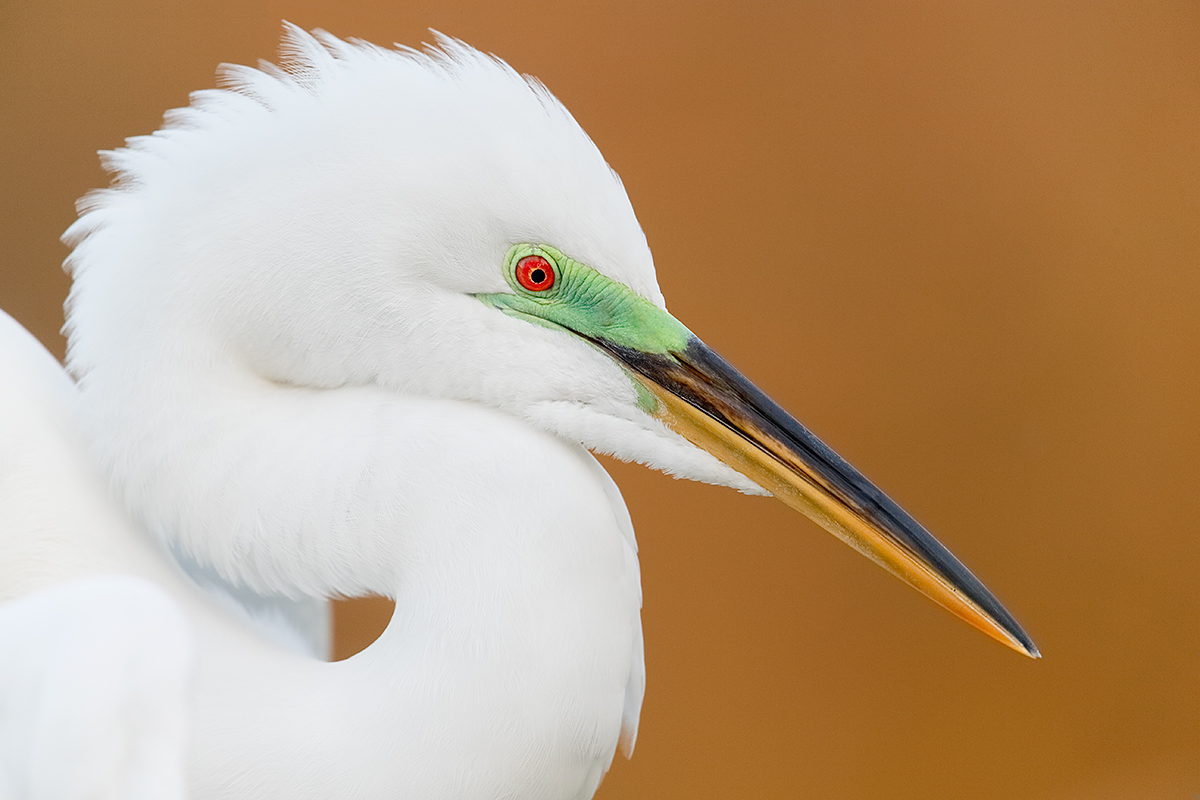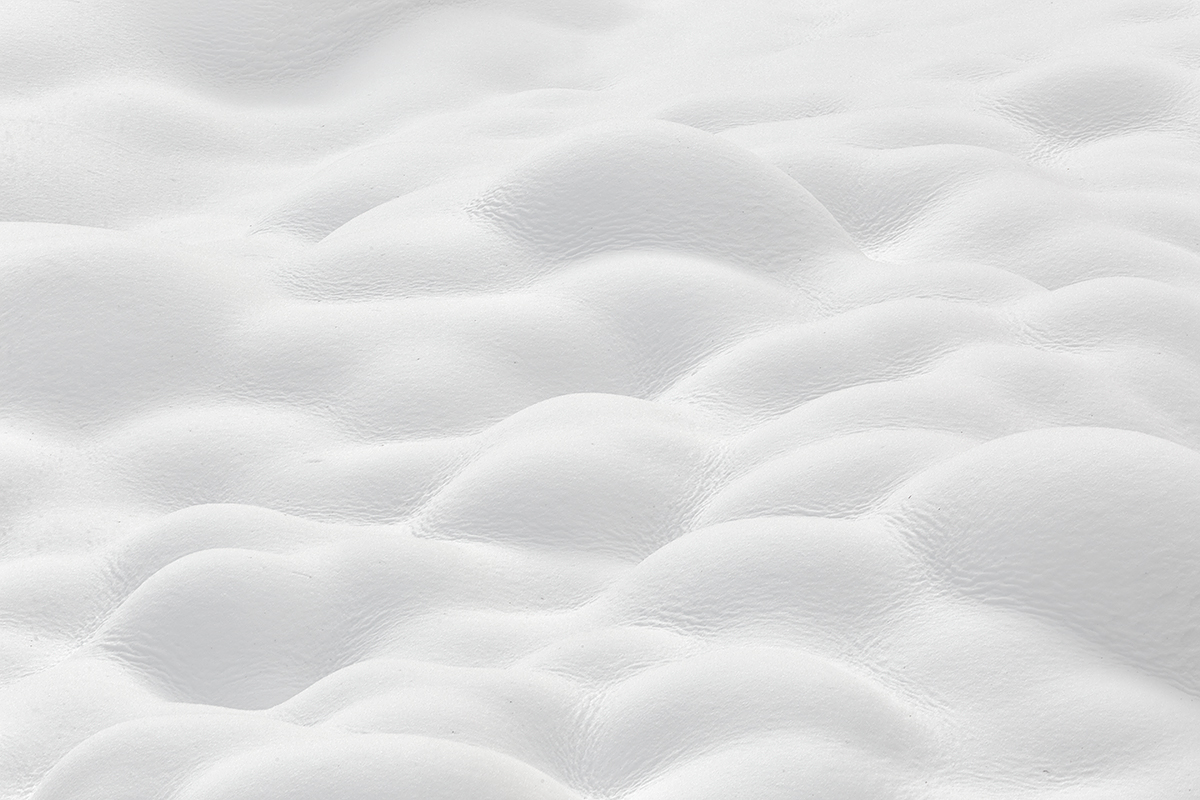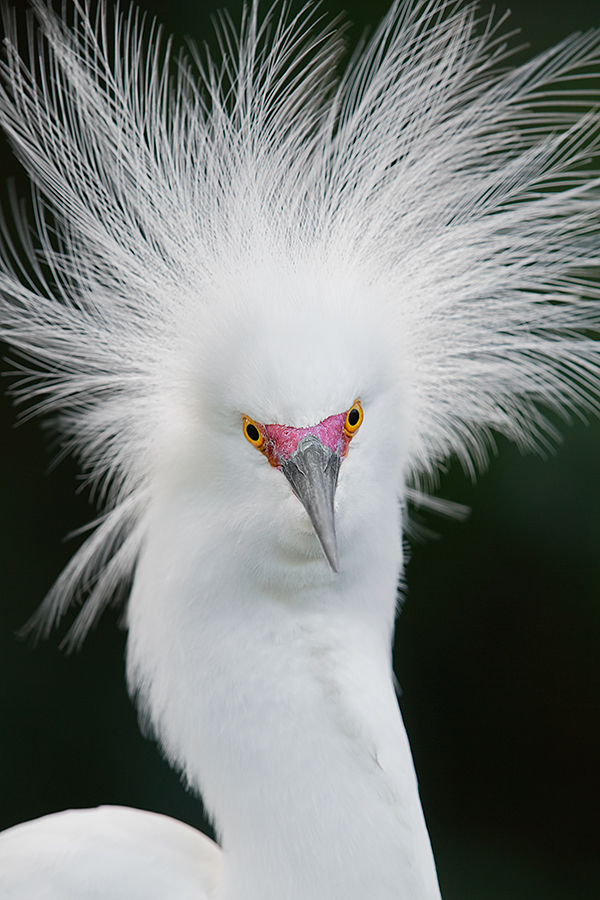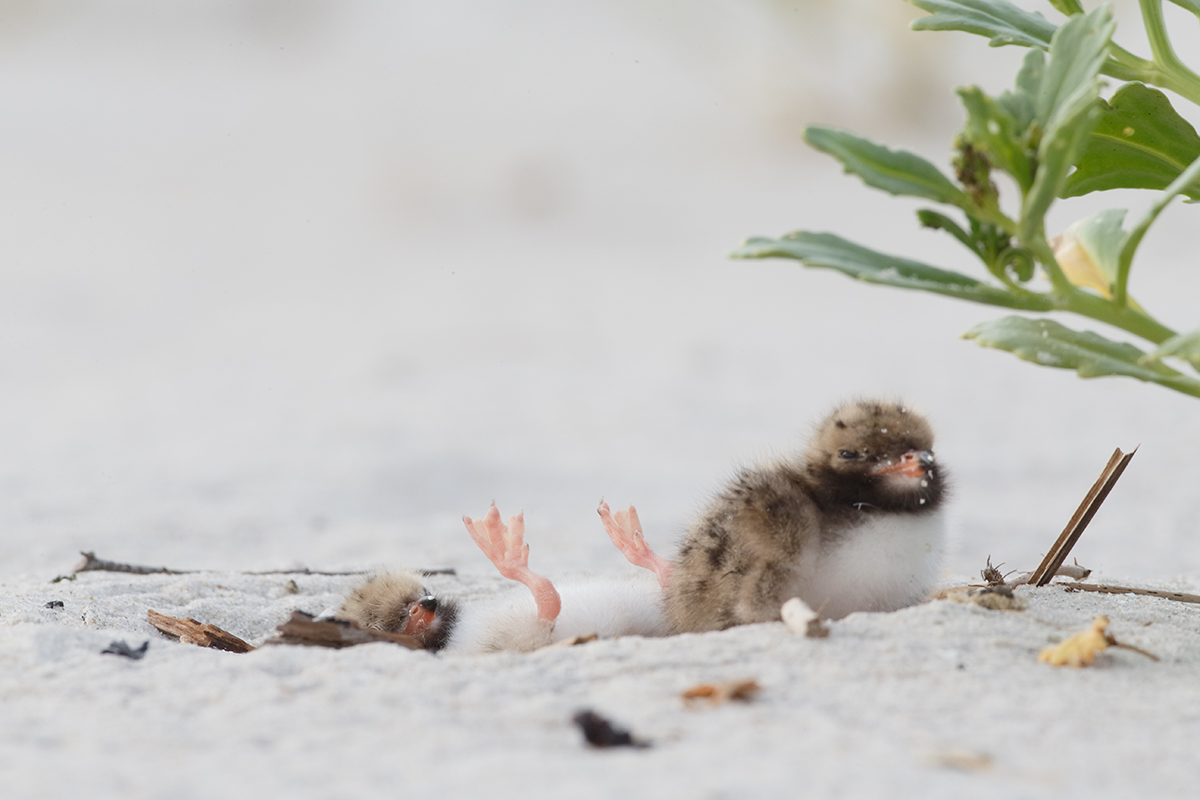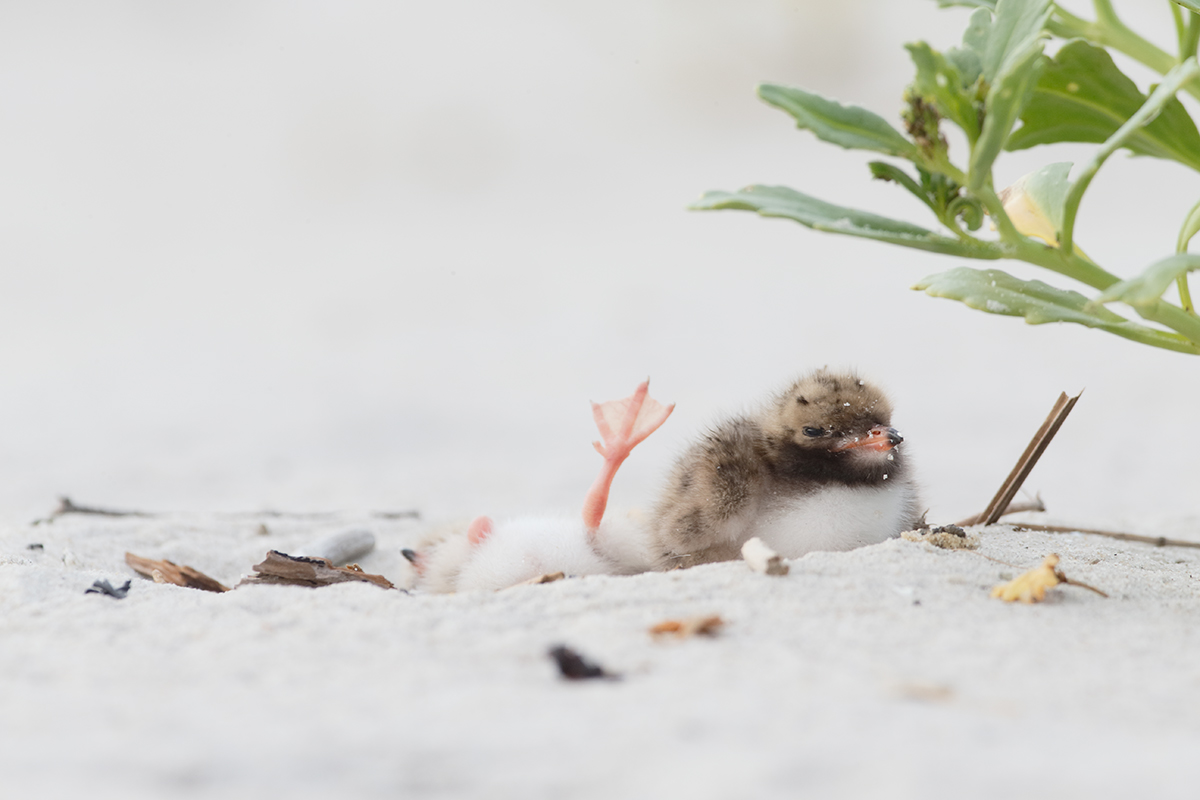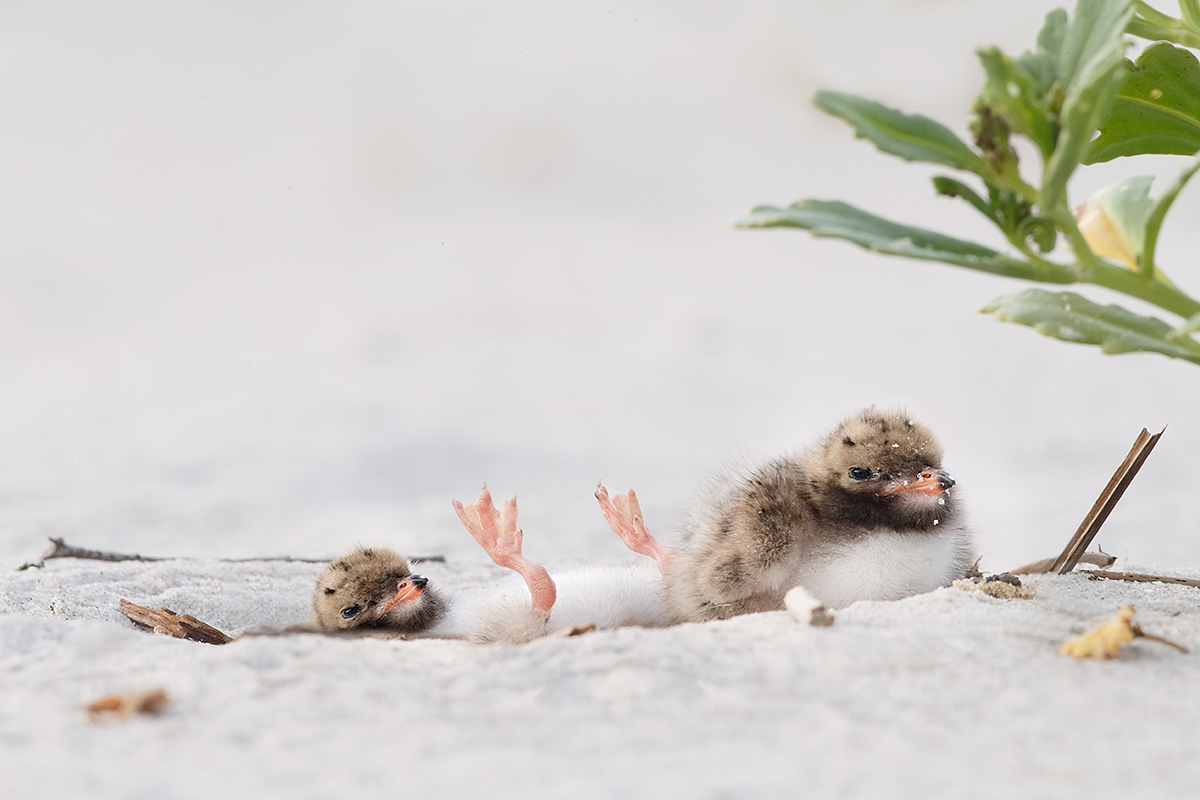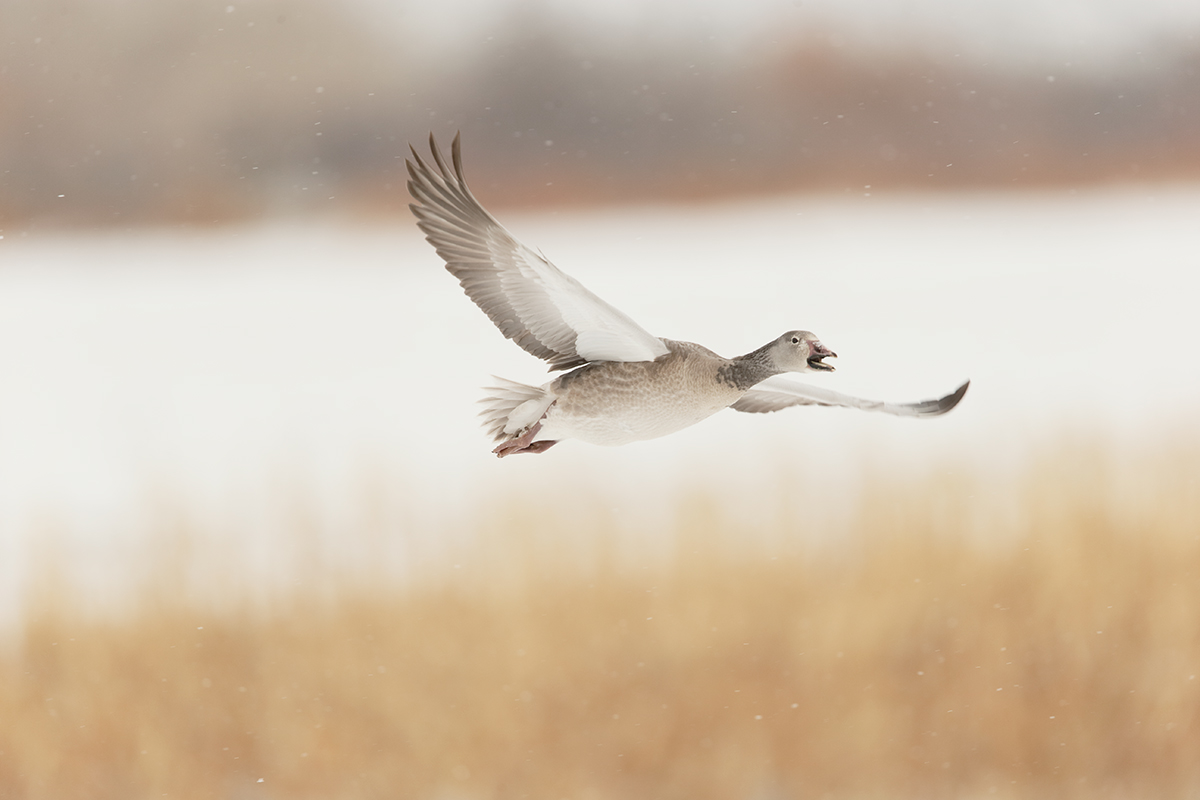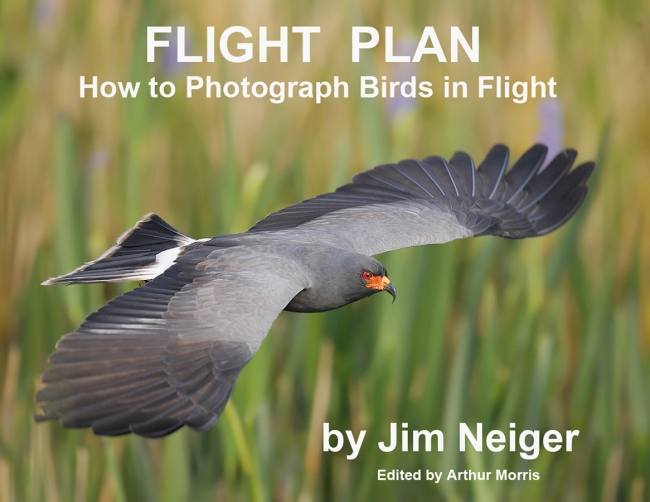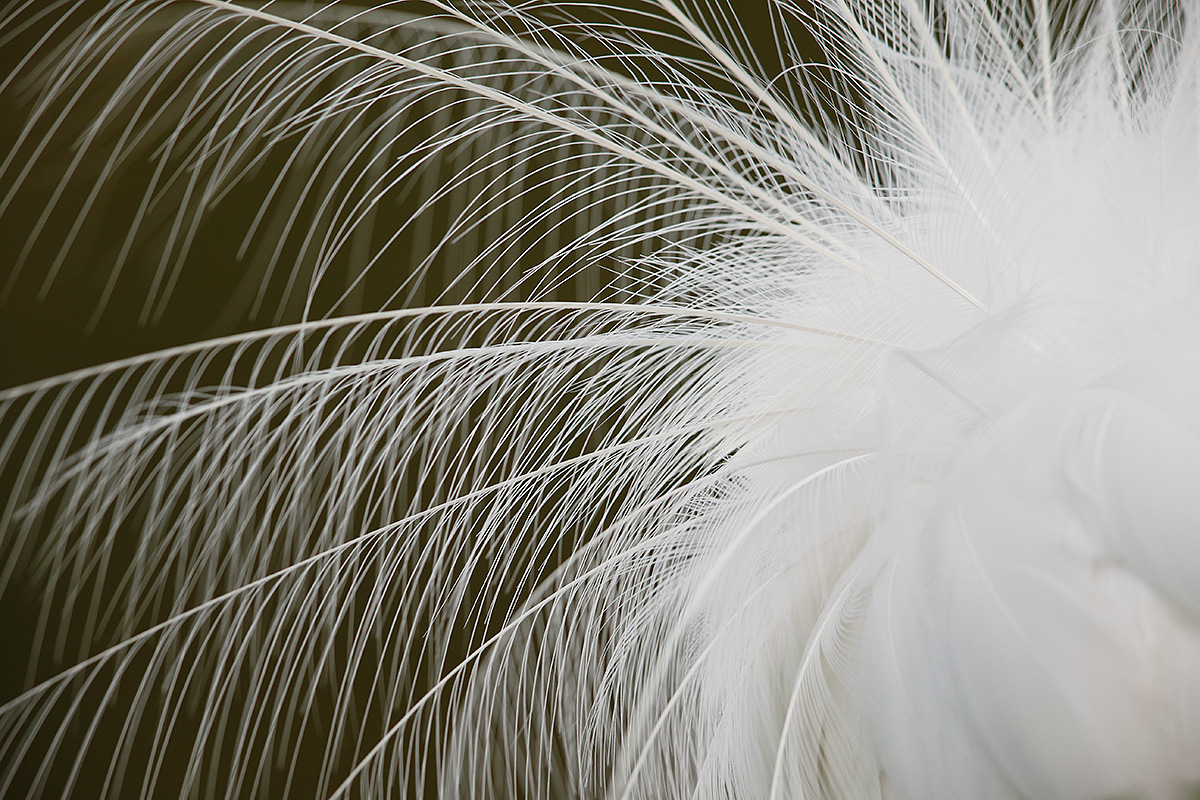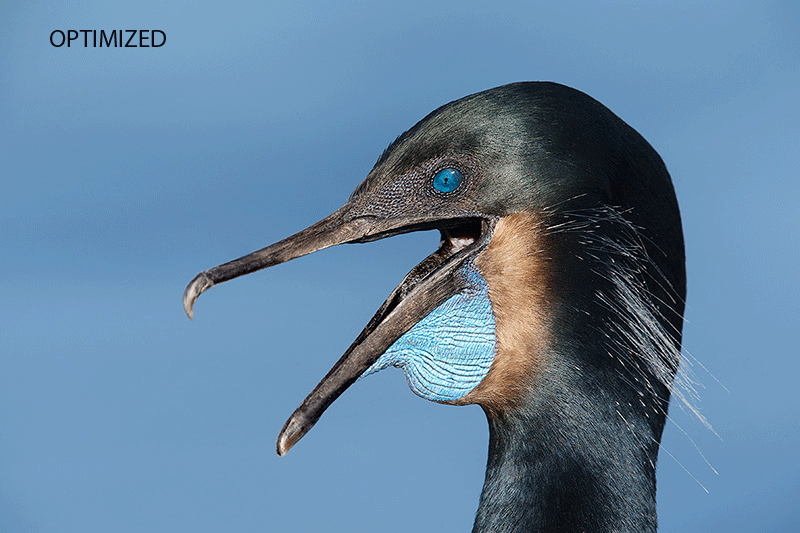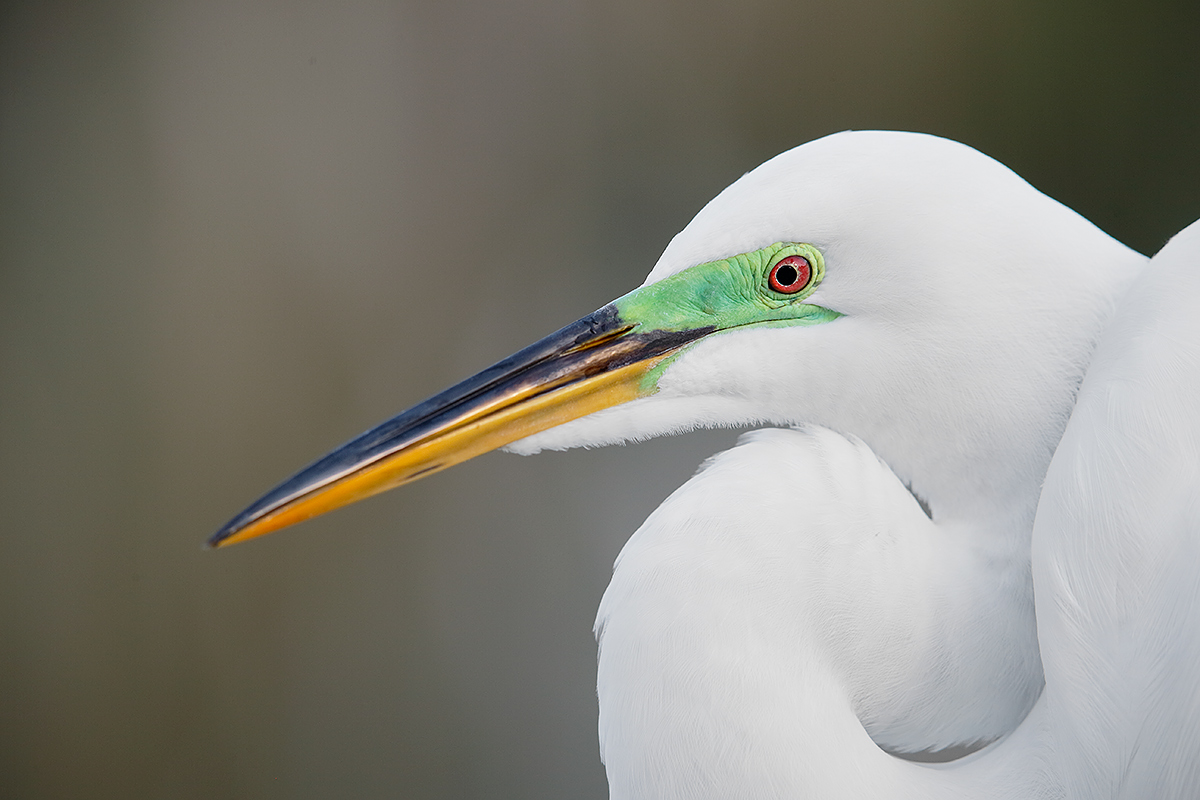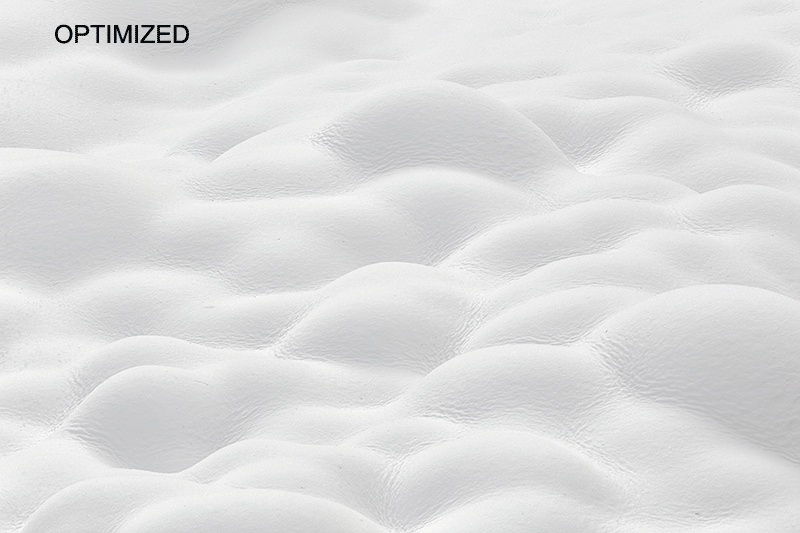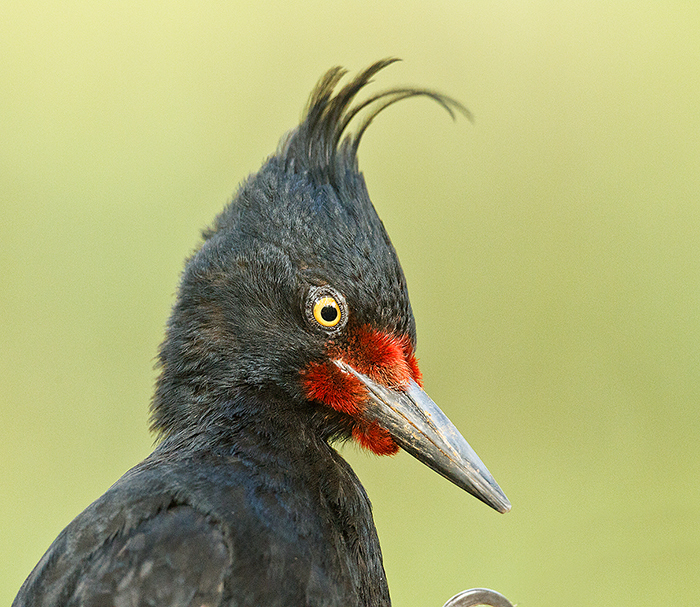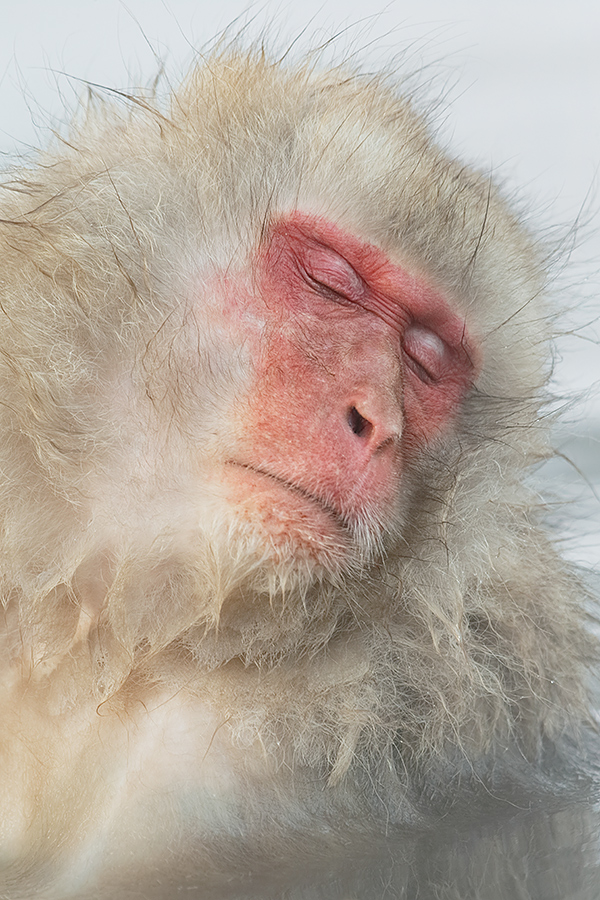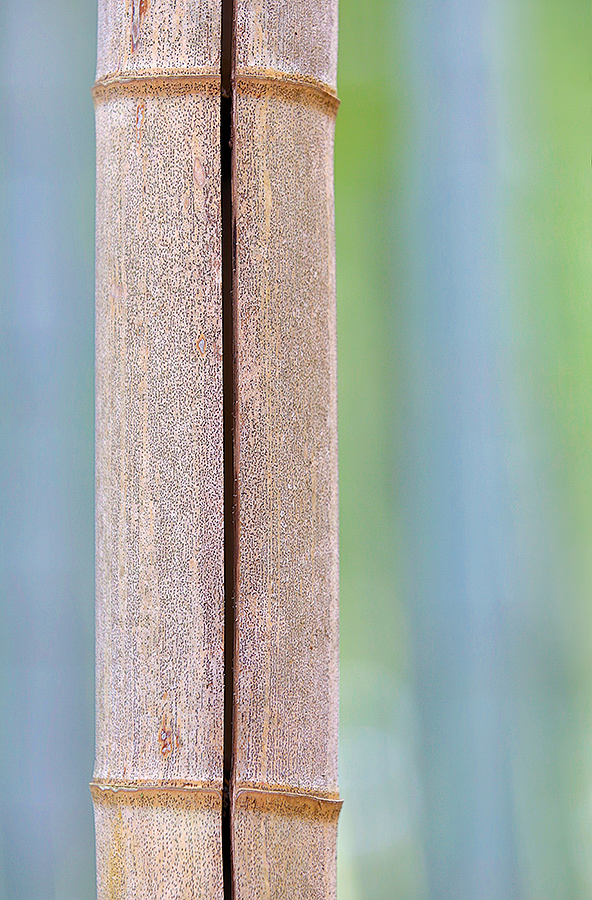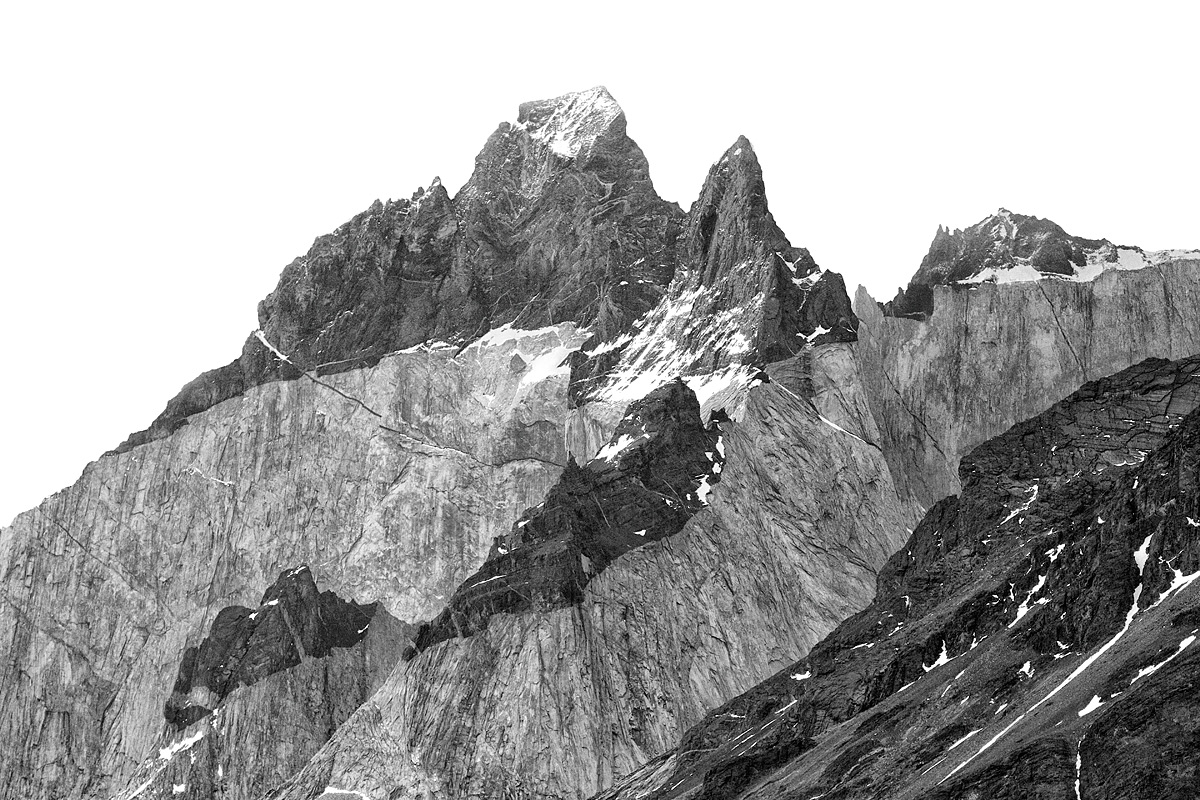March 26th, 2014 117
This post marks 117 straight days with a new educational blog post. With so many folks getting in the habit of using our B&H and Amazon links why quit now? To show your appreciation for my efforts here, we do ask that you use our B&H and Amazon affiliate links for all of your B&H and Amazon purchases. Please check the availability of all photographic accessories in the BIRDS AS ART Online Store. We sell only what I use and depend on. We will not sell you junk. We know what you need to make creating great images easy and fun. And we are always glad to answer your gear questions via e-mail.
You can find the following items in the store: Gitzo tripods, Mongoose M3.6 and Wimberley heads, plates, low feet, and accessories, flash brackets, , Delkin e-film Pro Compact Flash Cards, LensCoat products, and our unique line-up of educational materials including ABP I & II, Digital Basics, Site and Set-up e-Guides, Canon and Nikon Camera Users and AF e-Guides, and MP-4 Photoshop video tutorials among others.
We would of course appreciate your using our B&H and Amazon affiliate links for all of your B&H and Amazon major gear, video, electronic, household, and personal purchases. For the photographic stuff mentioned in the paragraph above we, meaning BAA, would of course greatly appreciate your business. Here is a huge thank you to the many who have been using our links on a regular basis and visiting the BAA Online store as well.
This blog post took 1 1/2 hours to create. Enjoy!
|
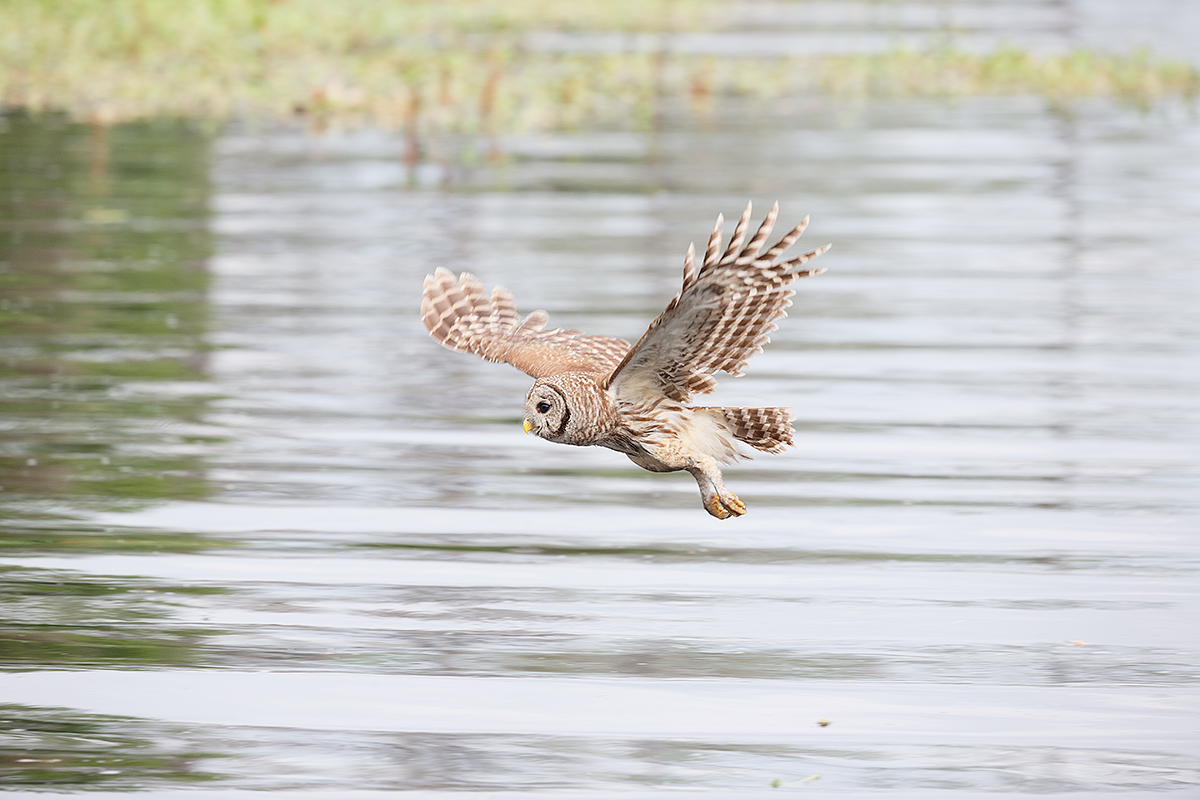
|
|
This over-exposed Barred Owl image was created in relatively harsh sunlight at 10:21am on Jim Neiger’s pontoon boat on Lake Blue Cypress on Friday morning past with the Canon EF 200-400mm f/4L IS USM Lens with Internal 1.4x Extender (hand held at 350mm) and the Canon EOS 5D Mark III. ISO 800. 1/640 sec. at f/5.6 in Manual mode was correct until the sun came out as the bird flew…. AWB.
Central Sensor/AI Servo-Surround/Rear Focus AF on the owl’s neck was of course active at the moment of exposure. Click here to see the latest version of the Rear Focus Tutorial. Click on the image to see a larger version.
|
Bad Luck
Just as this Barred Owl took off and flew low across a small river, the sun came out at full strength from behind a dark cloud. I had been set up for cloudy dark flight at ISO 800, 1/640 sec. at f/5.6. There were lots of blinkies on the water and more than a few on the bird itself. When I saw the image on the computer I was not sure that it could be salvaged. The good news was that it was sharp on the eye so I converted it 2/3 stop darker in DPP, brought it into Photoshop, and went to work.
|
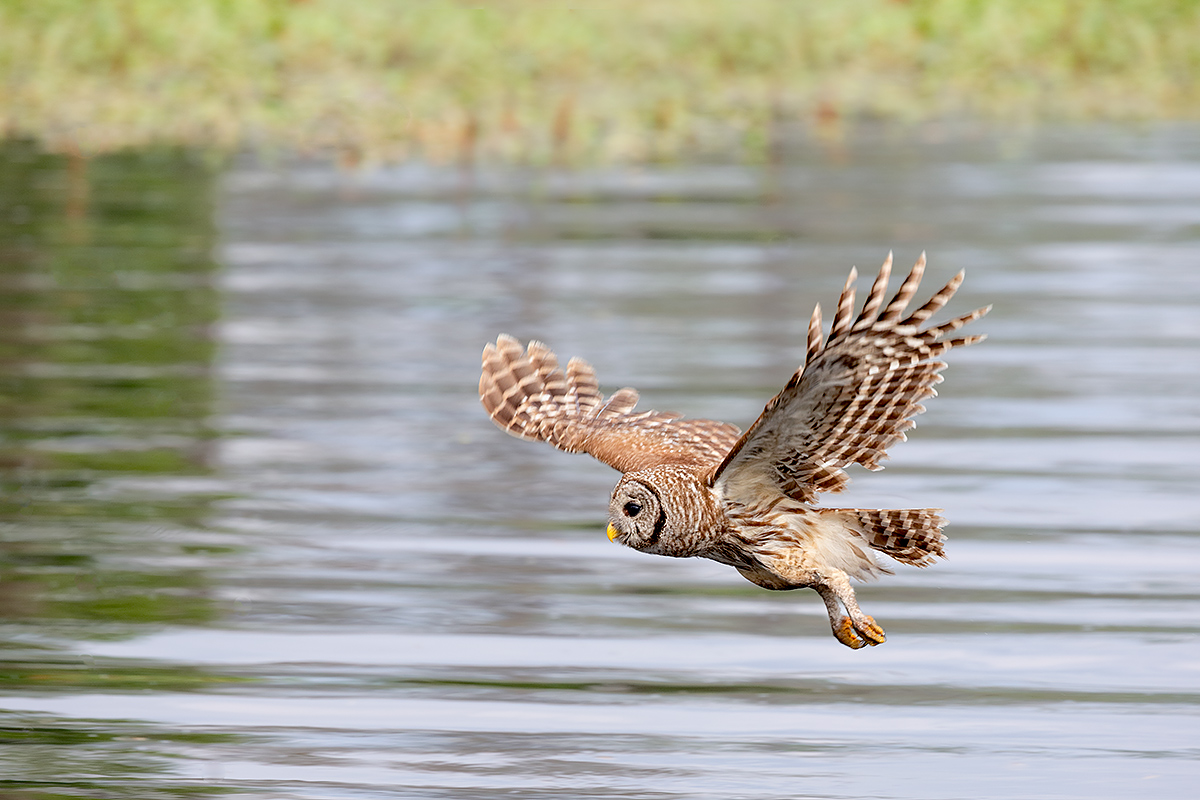
|
|
This is the optimized version of the original image capture above. At times, folks forget the great potential of digital RAW captures….
|
The Image Optiimization
The image optimization here was fairly straightforward. After converting the image 2/3 stop darker with the Highlight slider set to (-1), I brought the image into CS-6 and cropped it. Then I fine tuned the tonality and cleaned up the image. I started with a Levels Adjustment on its own layer, added some BLACK to the BLACKs and NEUTRALs in Selective Color and tweaked the Gamma in an Exposure Adjustment Layer, that new trick thanks to a tip from BPN moderator Bill Jobes here. Then NIK 50/50 at 67% opacity on the bird alone along with a small Contrast Mask.
River and background clean-up was as usual done with the Clone Stamp Tool (S), the Spot Healing Brush (J), the Patch Tool (P), and a flopped Quick Mask of the upper left corner that was moved (V) to the upper right corner (Q, B, Q, Control J, Control T, Flop Horizontally, Enter, V) and then fine-tuned with a Regular Layer Mask. When I was done I realized that I had overdone the contrast a bit so I ran my Reverse S Curve to tone things down just a bit. Image salvaged.
Digital Basics
Are you tired of making your images look worse in Photoshop? Do you have no clue as to how I optimized the images above? Everything above plus tons more is detailed in my Digital Basics File, an instructional PDF that is sent via e-mail. It includes my complete digital workflow, dozens of great Photoshop tips, the use of Contrast Masks, several different ways of expanding canvas, all of my time-saving Keyboard Shortcuts, Using Adjustment Layers, Quick Masking, Layer Masking, and NIK Color Efex Pro basics, my killer image clean-up techniques, Digital Eye Doctor, creating time-saving actions, and lots more.
The DPP RAW Conversion Guide
After seeing the accurate colors that I get from my DPP RAW conversions, Japan in Winter co-leader Paul McKenzie switched to DPP conversions and Denise Ippolito is considering doing the same. Now that is amazing…. To learn why I use Canon’s Digital Photo Professional (DPP) to convert every image that I work on, click here.
APTATS I & II
Learn the details of advanced Quick Masking techniques in APTATS I. Mention this blog post and apply a $5 discount with phone orders only. Learn advanced Layer Masking Techniques in APTATS II. Mention this blog post and apply a $5 discount with phone orders only. Buy the pair, APTATS I and APTATS II and we will be glad to apply at $15 discount with phone orders only.
BirdPhotographers.Net; It Ain’t Just Birds/Honest Critiques Done Gently
Learn more here. I learn something new on most every visit and one of the best ways to improve it to critique the images of others while having your images critiqued as well. Plus, you get to see lots of great images on a daily basis.
|
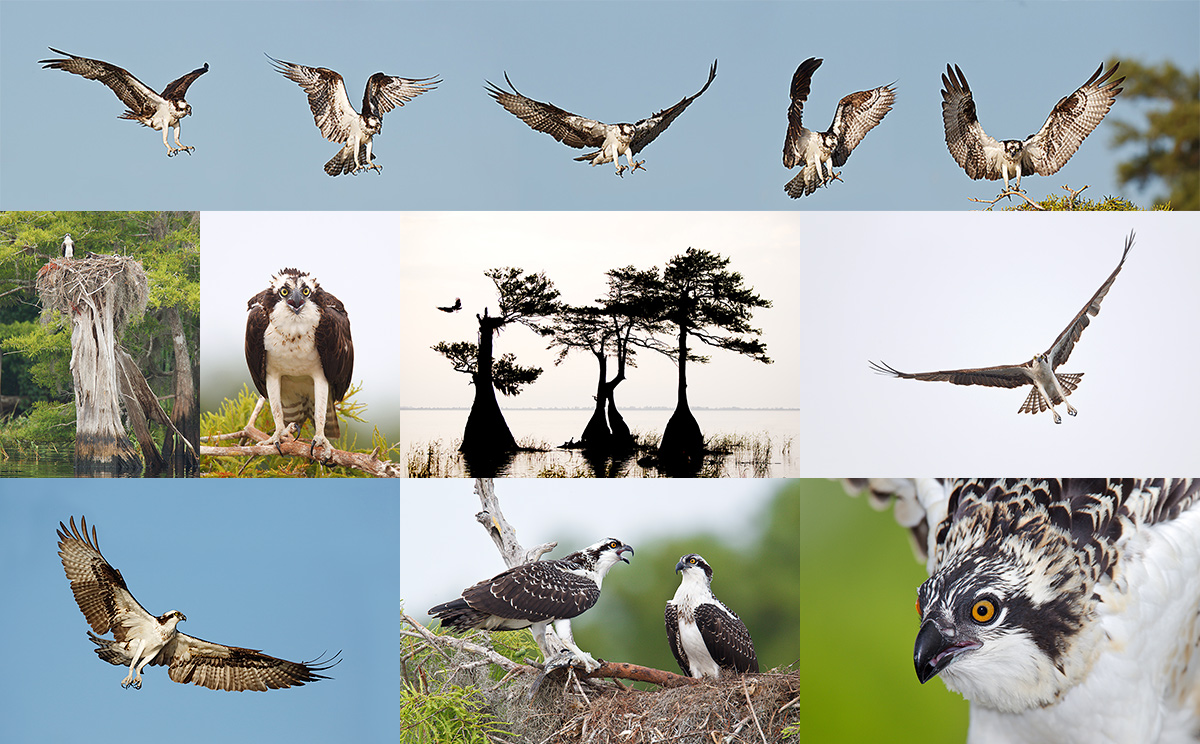
|
|
All images created on Lake Blue Cypress. Copyright Arthur Morris/BIRDS AS ART
|
Lake Blue Cypress Osprey Heaven Full-Day In-the-Field Hand Holding Workshops via Customized Pontoon Boat
Two 3+ hour shooting sessions on a beautiful cypress lake teeming with Osprey; Barred Owl almost guaranteed. Red-shouldered Hawk and Pileated Woodpecker likely. Be sure to follow the link to Jim’s gallery below.
2 great leaders: Captain Jim Neiger and Arthur Morris.
Available dates: April 8, 9, 11 & 12, 2014.
Here are the Full Day rates:
1 photographer: $650.
2 photographers: $500 each.
3 photographers: $450 each.
4 photographers: $400.
Each full day booking includes a delicious healthy lunch at my home. Overnight lodging at my home is available cheap on a limited basis for folks who would like to do more than one day. Please inquire via e-mail.
So far one photographer signed up for Saturday, April 12; join us and enjoy a $150 savings.
One or two photographers may hire the boat on a private basis by paying the full day rate for 4: $1600.
Because of the late date payment in full by personal check is due now. Please e-mail for additional details of info.
Check out Jim Neiger’s Osprey Heaven/Lake Blue Cypress Gallery here and you will be amazed as to the quality of the flight and action images and the possibilities.
Here’s what BPN member David Salem had to say about a day on the lake with Jim Neiger in Pane 1 here:
“We met our friend Jim Neiger on his boat at Lake Blue Cypress and had a blast shooting hundreds of Osprey and many other species including some great shots of Barred owls. I highly suggest booking a trip with Jim on the lake as he knows the lake real well and the birds even better. It was a trip that I will never forget with literally hundreds of Osprey flying around starting their nesting season. A sight to see!! I will be posting some pics from the lake soon. ”
Gatorland Short Notice Saturday Full-Day In-the-Field Workshops
Saturday March 29 and Saturday April 4, 2014. 7:15am till 10:15am & 4:00pm till dusk. Lunch, image review, and Photoshop session included. Limit 6. Small groups are likely: $399. Both: $749.
The cost of your Gatorland Photographer’s Pass is not included.
Gatorland is so good right now that I am going back the next two Saturdays (March 29 & April 4). The Snowy and Cattle Egrets are in way early and there are many in full breeding plumage. Here’s the story: last week there were about two dozen photographers at Gatorland on Saturday past. Aside from two decent photographers–I can tell by where you are pointing your lens…, nobody had a clue as to how to make a good image…. Yesterday it was even worse; pretty much no one had a clue. Most folks just stand in one spot and point and shoot. Without regard for light angle or background. Join me on this, the 3rd Gatorland Short Notice Saturday Full-Day In-the-Field Workshop and you will learn to spot the good situations, to choose the best perspective, to see and understand the light, to get the right exposure every time after making a single test exposure, and to design pleasing images by mastering your camera’s AF system. A big part of the above is that you will learn how and why you must work in Manual mode 90% of the time at Gatorland. That is exactly what Jim Weerts learned on Saturday past.
At lunch we will review my images, take a look at five of your best images from the morning session (for those who opt to bring their laptops), and process a few of my images in Photoshop after converting them in DPP. That followed by Instructor Nap Time. Last Saturday all 3 folks had a great time and learned a ton. And the weather for this coming Saturday is looking good.
Payment in full via credit card is due upon registering. Please call Jim or Jennifer at 863-692-0906 to register. Ask for me if you have any questions.
Last Saturday’s Gatorland Kudos
Via e-mail from multiple IPT veteran Peter Hawrylyshyn:
Artie, Just wanted to say thanks. I really enjoyed the Saturday IPT at Gatorland. It was a great one-day refresher course on composition, lighting/sun angles, exposure settings, birds in flight, and fill-flash, … I also learnt a lot watching your workflow and new processing tips over lunch. I thought you’d post that great Black-crowned Night-Heron that you found for us on your blog. I guessed wrong. Peter
Note. I will be devoting a whole post to that bird soon; have not had time to process them yet….
Via e-mail from Jim Weerts:
Thanks, Artie, for your kind hospitality, the Gatorland adventure, and sharing your expertise! I did indeed fall into it and for that I’m most appreciative. My father told me a long time ago that when I retire, I must retire to something else! Well, photography has filled the bill for me and the challenge to keep learning is the best part of it. You certainly pushed me hard last weekend and I hope to keep up with this adventure including with your blog. I did review the “Working in Manual Mode” material on your blog and will focus on this more as time allows.
The best part of the week-end included learning to look for the distractions in the background, understanding the wind direction and what it presents, and lining up my shadow with the target. Using Manual mode is a new favorite particularly with the changing situations like lighting, background and birds or wildlife. Learning new techniques with the 5D MK III (like rear focus and changing AF points), plus adding more knowledge about some of the rear buttons on the camera all added to the experience. Previously, I had not been able to make any changes on the fly that finally happening now, thanks to somebody teaching me how to do that! Beyond all of this, seeing the subject in new ways and new dimensions just opens up more fun! Thanks my new friend, for so much! I loved it! And “Thanks” for your talents! Jim Weerts
Note: Jim just signed up for the Holland IPT!
Support the BAA Blog. Support the BAA Bulletins: Shop B&H here!
We want and need to keep providing you with the latest free information, photography and Photoshop lessons, and all manner of related information. Show your appreciation by making your purchases immediately after clicking on any of our B&H or Amazon Affiliate links in this blog post. Remember, B&H ain’t just photography!


 


Amazon
Everyone buys something from Amazon, be it a big lens or deodorant. Support the blog by starting your search by clicking on the logo-link below. No purchase is too small to be appreciated; they all add up. Why make it a habit? Because I make it a habit of bringing you new images and information on an almost daily basis.
Typos
In all blog posts and Bulletins, feel free to e-mail or to leave a comment regarding any typos, wrong words, misspellings, omissions, or grammatical errors. Just be right. 🙂
March 25th, 2014 116
This post marks 116 straight days with a new educational blog post. With so many folks getting in the habit of using our B&H and Amazon links why quit now? To show your appreciation for my efforts here, we do ask that you use our B&H and Amazon affiliate links for all of your B&H and Amazon purchases. Please check the availability of all photographic accessories in the BIRDS AS ART Online Store. We sell only what I use and depend on. We will not sell you junk. We know what you need to make creating great images easy and fun. And we are always glad to answer your gear questions via e-mail.
You can find the following items in the store: Gitzo tripods, Mongoose M3.6 and Wimberley heads, plates, low feet, and accessories, flash brackets, , Delkin e-film Pro Compact Flash Cards, LensCoat products, and our unique line-up of educational materials including ABP I & II, Digital Basics, Site and Set-up e-Guides, Canon and Nikon Camera Users and AF e-Guides, and MP-4 Photoshop video tutorials among others.
We would of course appreciate your using our B&H and Amazon affiliate links for all of your B&H and Amazon major gear, video, electronic, household, and personal purchases. For the photographic stuff mentioned in the paragraph above we, meaning BAA, would of course greatly appreciate your business. Here is a huge thank you to the many who have been using our links on a regular basis and visiting the BAA Online store as well.
This blog post took 2 hours to create. Enjoy!
Answers Old & New
In an effort to have this blog be interactive, I ask lots of questions. At times, I am remiss in following up on them. Today’s post is designed to rectify that. Working from newer to older.
|
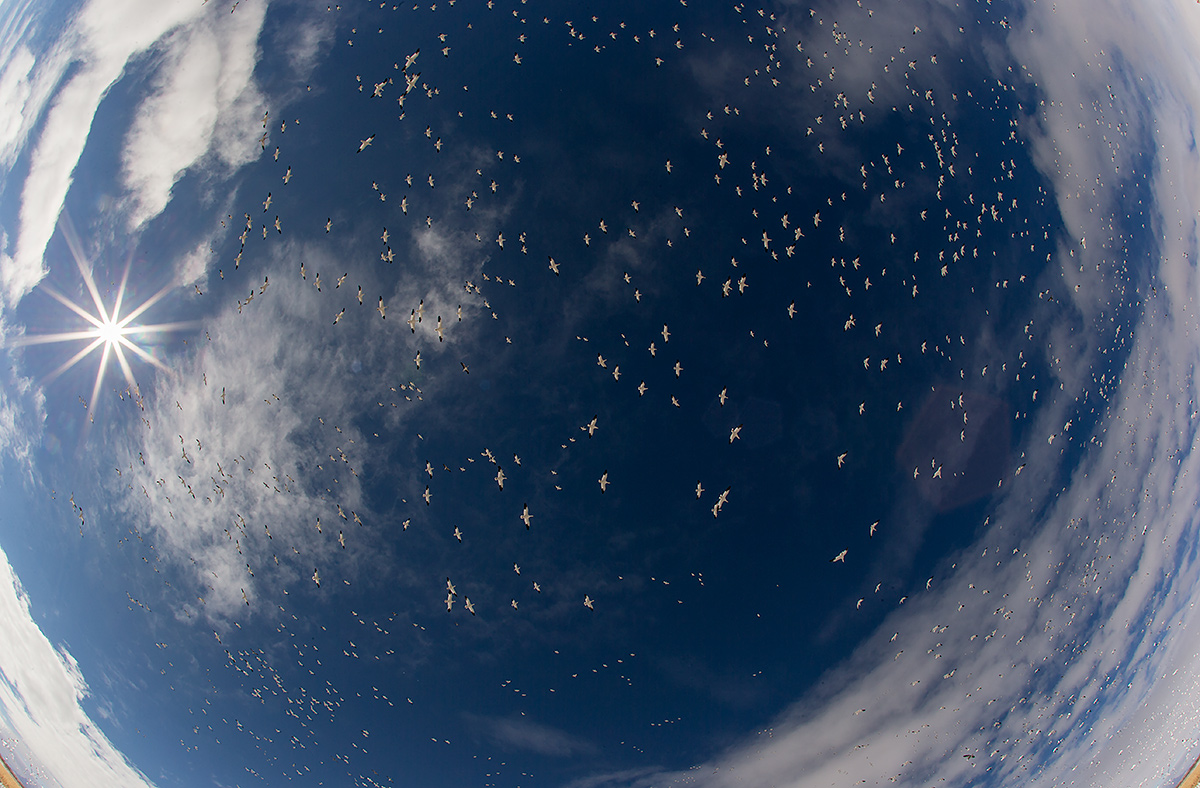
|
|
This Snow Geese image was created with the Canon 15mm fisheye lens (now replaced by the Canon EF 8-15mm f/4L Fisheye USM lens and the Canon EOS-1D X. ISO 400. Evaluative metering -1 1/3 stops as framed: 1/400 sec. at f/22 in Av Mode. Color temperature: 7000.
Central Sensor/Surround/AI Servo/Rear Focus AF as framed active at the moment of exposure. Click here to see the latest version of the Rear Focus Tutorial. Click on the image to see a larger version.
|
Image Questions
In, The Photoshop CS-6 Basic Tab “Tonal Adjustment” Sliders blog post on 21 March, I asked with regards to the image above:
Why f/22?
With most but not all lenses, working at apertures of f/22 or smaller with pinhole light sources will yield pleasing starburst patterns as seen in the image above. With longer lenses, it helps if the sun is just peeking above a mountain ridge or through some leaves. Remember, you do not want to be pointing longer focal length lenses at the sun when it is out at full strength. I’d say that you’d want to stay away from anything longer than 100mm to ensure that you not damage your retina. Elinor Osborne got this correctly in her comment.
Why -1 1/3 stops?
Though the sun is bright it is well off center and relatively small in the frame. Thus, it does not have any great effect on the meter reading. What the meter is seeing and influenced by is that huge dark blue sky. Remember that the blue sky directly overhead is about two stops darker than the sky near the horizon; I needed to under-expose from the meter reading to prevent blowing out the WHITEs of the geese and to bring the sun into a manageable range. Mission accomplished.
BAA Fine Art Prints
In the same post, Sharon Hallowell left this comment: “I really love this image and have come back several times to view it! Where would I look to purchase this as a print?
All BAA images are available as either traditional photographic or canvas prints. We offer a great variety of sizes and all are signed by yours truly. To purchase a print as a gift or for your home or office, or to learn more, click here.
Exposure Questions from “What’s So Funny?”
In the What’s So Funny? blog post, I needed 1 2/3 stops of underexposure for the preening Great Egret image to avoid burning out the rim-lit WHITEs. The dark, shaded background would influence the meter towards overexposure.
With the Brant’s Cormorant image the exposure danger was the possibility of over-exposing the almost fluorescent blue of the bird’s gular sac. Best way to avoid that is to work in Manual mode, make a test image, and check for blinkies on the gular sac highlights.
Head Hunting Tips…/My Favorite
Though I liked all three Head Hunting Tips… images, my favorite, like most of you, was #3, Yellow-buff Background (above). Like the other 2 images it featured a gorgeous breeding plumage Great Egret, but I loved the soft light and the killer background colors. To attain those I had to raise the tripod by pulling the legs in and then carefully choosing my perspective.
I wish only for 1 degree more of head turn towards us.
My Favorite/Simplicity, Undoing the BLUEs, and More…
In Simplicity, Undoing the BLUEs, and More…, where all who responded preferred Image #2: Tree Stand on Snowy Ridge, I liked both images equally. For me, the soft light and sensuous curves in image #1 are quite special.
Mint Canon 800mm f/5.6L IS & 400mm f/4IS DO Lenses for Sale
Friend and multiple IPT veteran Larry Master is offering a mint condition Mint Canon 800mm f/5.6L IS Lens for sale for $8750. This great lens, my favorite for 3 years, the Canon EF 800mm f/5.6L IS USM lens, sells new at B&H for $13,218.00. Yesterday they were offering one in mint condition for a ridiculous $10,249.90; it sold overnight. Go figure. Larry’s lens will save you a ton of dough and you will have a great lens with lots of reach. Larry is selling the lens as he purchased the 600 II on my advice.
The sale includes a Lenscoat, an Aquatech soft lens cap that fits like a glove, a Kirk Enterprises LP30 plate (not recommended by me), the lens trunk and leather cover, and insured shipping by UPS Ground to US addresses only. Personal checks only; your new lens will be shipped only after your check clears.
Larry is also offering a Canon 400mm f/4 IS DO lens, used perhaps twice since it was purchased new, in absolute mint condition for $4799. It retails new for $6,499 at B&H.
The sale includes the fabric lens case, all original materials, a LensCoat, and insured shipping by UPS Ground to US addresses only. Personal checks only; your new lens will be shipped only after your check clears. I owned and used a 400 DO for years; at 4.28 pounds it is a great lens for folks wishing to gain extra reach without excessively heavy gear…. I used it often with both TCs and made sharp images.
Interested folks may contact Larry on his cell phone at 518-645-1545 or via e-mail.
Gatorland Short Notice Saturday Full-Day In-the-Field Workshops
Saturday March 29 and Saturday April 4, 2014. 7:15am till 10:15am & 4:00pm till dusk. Lunch, image review, and Photoshop session included. Limit 6. Small groups are likely: $399. Both: $749.
The cost of your Gatorland Photographer’s Pass is not included.
Gatorland is so good right now that I am going back next Saturday (March 29). The Snowy and Cattle Egrets are in way early and there are many in full breeding plumage. Here’s the story: last week there were about two dozen photographers at Gatorland on Saturday past. Aside from two decent photographers–I can tell by where you are pointing your lens…, nobody had a clue as to how to make a good image…. Yesterday it was even worse; pretty much no one had a clue. Most folks just stand in one spot and point and shoot. Without regard for light angle or background. Join me on this, the 3rd Gatorland Short Notice Saturday Full-Day In-the-Field Workshop and you will learn to spot the good situations, to choose the best perspective, to see and understand the light, to get the right exposure every time after making a single test exposure, and to design pleasing images by mastering your camera’s AF system. A big part of the above is that you will learn how and why you must work in Manual mode 90% of the time at Gatorland. That is exactly what Jim Weerts learned on Saturday past.
At lunch we will review my images, take a look at five of your best images from the morning session (for those who opt to bring their laptops), and process a few of my images in Photoshop after converting them in DPP. That followed by Instructor Nap Time. Last Saturday all 3 folks had a great time and learned a ton. And the weather for this coming Saturday is looking good.
Payment in full via credit card is due upon registering. Please call Jim or Jennifer at 863-692-0906 to register. Ask for me if you have any questions.
Last Saturday’s Gatorland Kudos
Via e-mail from Jim Weerts:
Thanks, Artie, for your kind hospitality, the Gatorland adventure, and sharing your expertise! I did indeed fall into it and for that I’m most appreciative. My father told me a long time ago that when I retire, I must retire to something else! Well, photography has filled the bill for me and the challenge to keep learning is the best part of it. You certainly pushed me hard last weekend and I hope to keep up with this adventure including with your blog. I did review the “Working in Manual Mode” material on your blog and will focus on this more as time allows.
The best part of the week-end included learning to look for the distractions in the background, understanding the wind direction and what it presents, and lining up my shadow with the target. Using Manual mode is a new favorite particularly with the changing situations like lighting, background and birds or wildlife. Learning new techniques with the 5D MK III (like rear focus and changing AF points), plus adding more knowledge about some of the rear buttons on the camera all added to the experience. Previously, I had not been able to make any changes on the fly that finally happening now, thanks to somebody teaching me how to do that! Beyond all of this, seeing the subject in new ways and new dimensions just opens up more fun! Thanks my new friend, for so much! I loved it! And “Thanks” for your talents! Jim Weerts
Lake Blue Cypress/Osprey Heaven with Jim Neiger
Jim Neiger and I are offering full day Osprey Heaven In-the-Field Workshops in early to mid-April. Possible dates are as follows: April 8, 9, 11, & 12, 2014. If you are interested please shoot me an e-mail; group size will be strictly limited to four hand holding photographers.
Support the BAA Blog. Support the BAA Bulletins: Shop B&H here!
We want and need to keep providing you with the latest free information, photography and Photoshop lessons, and all manner of related information. Show your appreciation by making your purchases immediately after clicking on any of our B&H or Amazon Affiliate links in this blog post. Remember, B&H ain’t just photography!


 


Amazon
Everyone buys something from Amazon, be it a big lens or deodorant. Support the blog by starting your search by clicking on the logo-link below. No purchase is too small to be appreciated; they all add up. Why make it a habit? Because I make it a habit of bringing you new images and information on an almost daily basis.
Typos
In all blog posts and Bulletins, feel free to e-mail or to leave a comment regarding any typos, wrong words, misspellings, omissions, or grammatical errors. Just be right. 🙂
March 24th, 2014 115
This post marks 115 straight days with a new educational blog post. With so many folks getting in the habit of using our B&H and Amazon links why quit now? To show your appreciation for my efforts here, we do ask that you use our B&H and Amazon affiliate links for all of your B&H and Amazon purchases. Please check the availability of all photographic accessories in the BIRDS AS ART Online Store. We sell only what I use and depend on. We will not sell you junk. We know what you need to make creating great images easy and fun. And we are always glad to answer your gear questions via e-mail.
You can find the following items in the store: Gitzo tripods, Mongoose M3.6 and Wimberley heads, plates, low feet, and accessories, flash brackets, , Delkin e-film Pro Compact Flash Cards, LensCoat products, and our unique line-up of educational materials including ABP I & II, Digital Basics, Site and Set-up e-Guides, Canon and Nikon Camera Users and AF e-Guides, and MP-4 Photoshop video tutorials among others.
We would of course appreciate your using our B&H and Amazon affiliate links for all of your B&H and Amazon major gear, video, electronic, household, and personal purchases. For the photographic stuff mentioned in the paragraph above we, meaning BAA, would of course greatly appreciate your business. Here is a huge thank you to the many who have been using our links on a regular basis and visiting the BAA Online store as well.
New friend Jim Weerts and I photographed two local Sandhill Crane colts down by the lake on Sunday morning. Then it was a day of working on Gatorland images, swimming, napping, and mostly over-eating :(. I am back in the groove of healthy eating today.
It’s Been a Long Time: Flash Re-visited
A quick search revealed that the last time I used flash was at Gatorland almost 2 years ago on April 29, 2012.
The image above illustrates the perfect use of fill flash. Having the flash on a bracket preventing messing up the eye (flash eye, silver eye, purple eye, eye destruction, or all of the above). The flash added a bit of extra sharpness to the eyes and the feathers while working at a relatively slow shutter speed (1/60 sec.) at a long effective focal length (1200mm). Lastly, the flash helped restore the proper color balance.
There will be lots more on flash here on the blog in the next few days. Including tales of some major screw-ups by yours truly.
Flash Simplified
If you are clueless when it comes to flash you are advised to study the “Flash Simplified” section in The Art of Bird Photography II. ABP II: 916 pages on CD only with 900+ great images each with one of our legendary BAA educational captions. Just like the ones you see here on the blog. Topics covered include flash gear and set-up, Better Beamer basics, telephoto fill flash, flash as main light, and the use of Manual flash. The use of High Speed Synch for flash flight photography is detailed in various image captions.
I had several ABP IIs for sale on the bench at the Gator Breeding Marsh these last two weekends. Though virtually every single photographer there would have benefited greatly by getting a copy and studying this amazing resource, I sold not a one….
Why the 5D Mark III/600II/2X III TC Combo?
I have said it here often, “When the speed of initial AF acquisition and the frame rate do not matter, the 5D III, with its larger files, will always be my choice over the 1D X.” For me, it’s a no-brainer.
Mint Canon 500mm f/4L IS II Super-telephoto Lens for Sale: $8799
Lens Sold in 5 Minutes for the Asking Price
Selling your used (or like-new) photo gear through the BAA Blog or via a BAA Online Bulletin is a great idea. We charge only a 5% commission. One of the more popular used gear for sale sites charges a minimum of 20% plus assorted fees! Yikes. The minimum item price here is $500. If you are interested please e-mail with the words Items for Sale Info Request cut and pasted into the Subject line :). Stuff that is priced fairly–I offer free pricing advise, usually sells in no time flat as did Dennis Cassidy’s 500 II.
Another Gatorland Short Notice Saturday Full-Day In-the-Field Workshop
Saturday March 29, 2014. 7:15am till 10:15am & 4:00pm till dusk. Lunch, image review, and Photoshop session included. Limit 6. A very small group is again likely: $399.
The cost of your Gatorland Photographer’s Pass is not included.
Gatorland is so good right now that I am going back next Saturday (March 29). The Snowy and Cattle Egrets are in way early and there are many in full breeding plumage. Here’s the story: last week there were about two dozen photographers at Gatorland on Saturday past. Aside from two decent photographers–I can tell by where you are pointing your lens…, nobody had a clue as to how to make a good image…. Yesterday it was even worse; pretty much no one had a clue. Most folks just stand in one spot and point and shoot. Without regard for light angle or background. Join me on this, the 3rd Gatorland Short Notice Saturday Full-Day In-the-Field Workshop and you will learn to spot the good situations, to choose the best perspective, to see and understand the light, to get the right exposure every time after making a single test exposure, and to design pleasing images by mastering your camera’s AF system. A big part of the above is that you will learn how and why you must work in Manual mode 90% of the time at Gatorland. That is exactly what Jim Weertz learned on Saturday past.
At lunch we will review my images, take a look at five of your best images from the morning session (for those who opt to bring their laptops), and process a few of my images in Photoshop after converting them in DPP. That followed by Instructor Nap Time. Last Saturday all 3 folks had a great time and learned a ton. And the weather for this coming Saturday is looking good.
Payment in full via credit card is due upon registering. Please call Jim or Jennifer at 863-692-0906 to register. Ask for me if you have any questions.
Lake Blue Cypress with Jim Neiger
Over the next many weeks Jim Neiger and I will be offering full day Osprey Heaven In-the-Field Workshops. Rates and potential dates will be announced soon. If you are interested please shoot me an e-mail; group size will be strictly limited to four hand holding photographers.
Support the BAA Blog. Support the BAA Bulletins: Shop B&H here!
We want and need to keep providing you with the latest free information, photography and Photoshop lessons, and all manner of related information. Show your appreciation by making your purchases immediately after clicking on any of our B&H or Amazon Affiliate links in this blog post. Remember, B&H ain’t just photography!


 


Amazon
Everyone buys something from Amazon, be it a big lens or deodorant. Support the blog by starting your search by clicking on the logo-link below. No purchase is too small to be appreciated; they all add up. Why make it a habit? Because I make it a habit of bringing you new images and information on an almost daily basis.
Typos
In all blog posts and Bulletins, feel free to e-mail or to leave a comment regarding any typos, wrong words, misspellings, omissions, or grammatical errors. Just be right. 🙂
March 23rd, 2014 114
This post marks 114 straight days with a new educational blog post. With so many folks getting in the habit of using our B&H and Amazon links why quit now? To show your appreciation for my efforts here, we do ask that you use our B&H and Amazon affiliate links for all of your B&H and Amazon purchases. Please check the availability of all photographic accessories in the BIRDS AS ART Online Store. We sell only what I use and depend on. We will not sell you junk. We know what you need to make creating great images easy and fun. And we are always glad to answer your gear questions via e-mail.
You can find the following items in the store: Gitzo tripods, Mongoose M3.6 and Wimberley heads, plates, low feet, and accessories, flash brackets, , Delkin e-film Pro Compact Flash Cards, LensCoat products, and our unique line-up of educational materials including ABP I & II, Digital Basics, Site and Set-up e-Guides, Canon and Nikon Camera Users and AF e-Guides, and MP-4 Photoshop video tutorials among others.
We would of course appreciate your using our B&H and Amazon affiliate links for all of your B&H and Amazon major gear, video, electronic, household, and personal purchases. For the photographic stuff mentioned in the paragraph above we, meaning BAA, would of course greatly appreciate your business. Here is a huge thank you to the many who have been using our links on a regular basis and visiting the BAA Online store as well.
New friend Jim Weerts (say wurtz) and old friend and multiple IPT veteran Peter Hawrylyshyn (say Hah-ver-LISH-in spent long and great day at Gatorland yesterday.
Getting Lazy?
In response to yesterday’s Coming Clean blog post here, only a single readers chose to note any of the many changes that I made during the image optimization process. You are invited to click here and leave a comment if you spot any of the many changes.
|
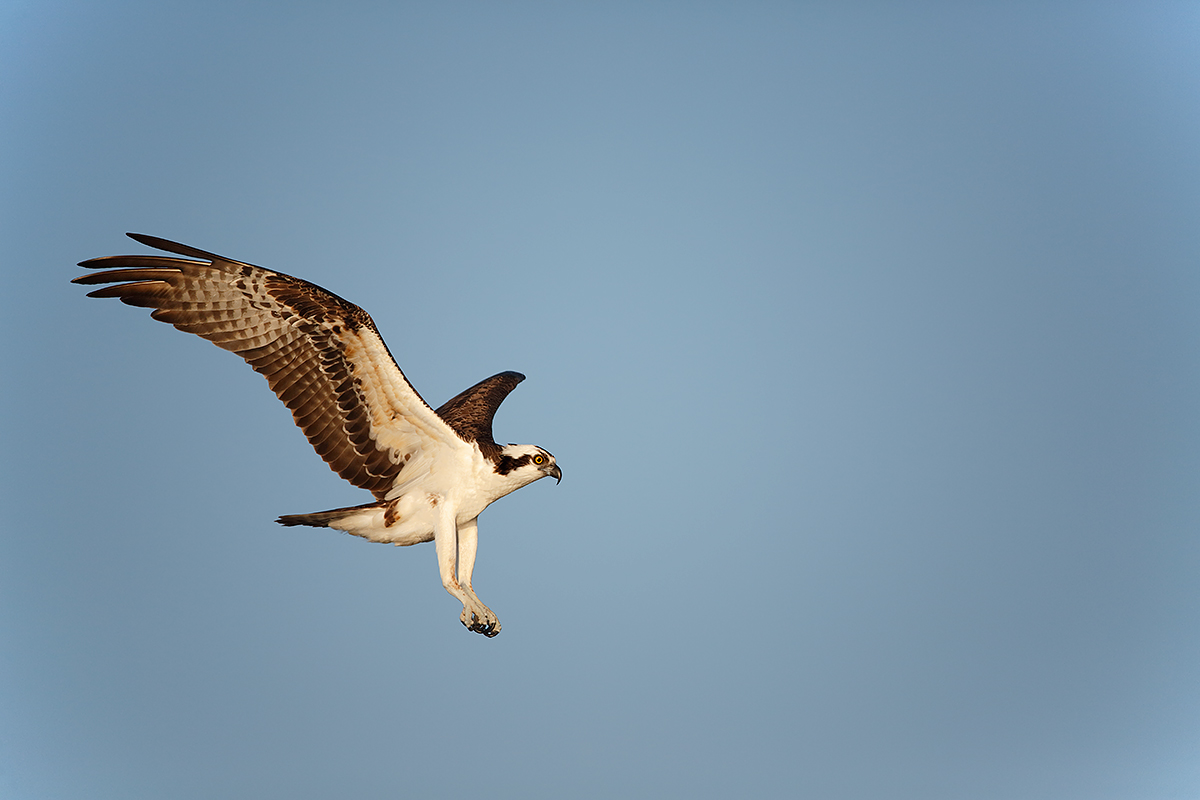
|
|
This Osprey image was created at 8:10am in soft early morning light on Jim Neiger’s pontoon boat on Lake Blue Cypress on Friday morning past with the Canon EF 200-400mm f/4L IS USM Lens with Internal 1.4x Extender (hand held with the internal extender in place at 560mm) and the Canon EOS 5D Mark III. ISO 500. Evaluative metering +1 1/3 stops off the sky was a bit of an over-exposure: 1/2500 sec. at f/5.6 in Manual mode. AWB.
Central Sensor/AI Servo-Surround/Rear Focus AF just caught the top of the bird’s head and was of course active at the moment of exposure. Click here to see the latest version of the Rear Focus Tutorial. Click on the image to see a larger version.
|
The Question
Recently Brad Smith contacted me via e-mail and wrote in part:
I wanted to buy the EF 200-400mm f/4L IS USM Extender 1.4X, but have heard from a couple of respected users that the lens is sluggish for use with birds in flight on the 5D Mark III (much better on the 1D X, but I do not own that body).
|
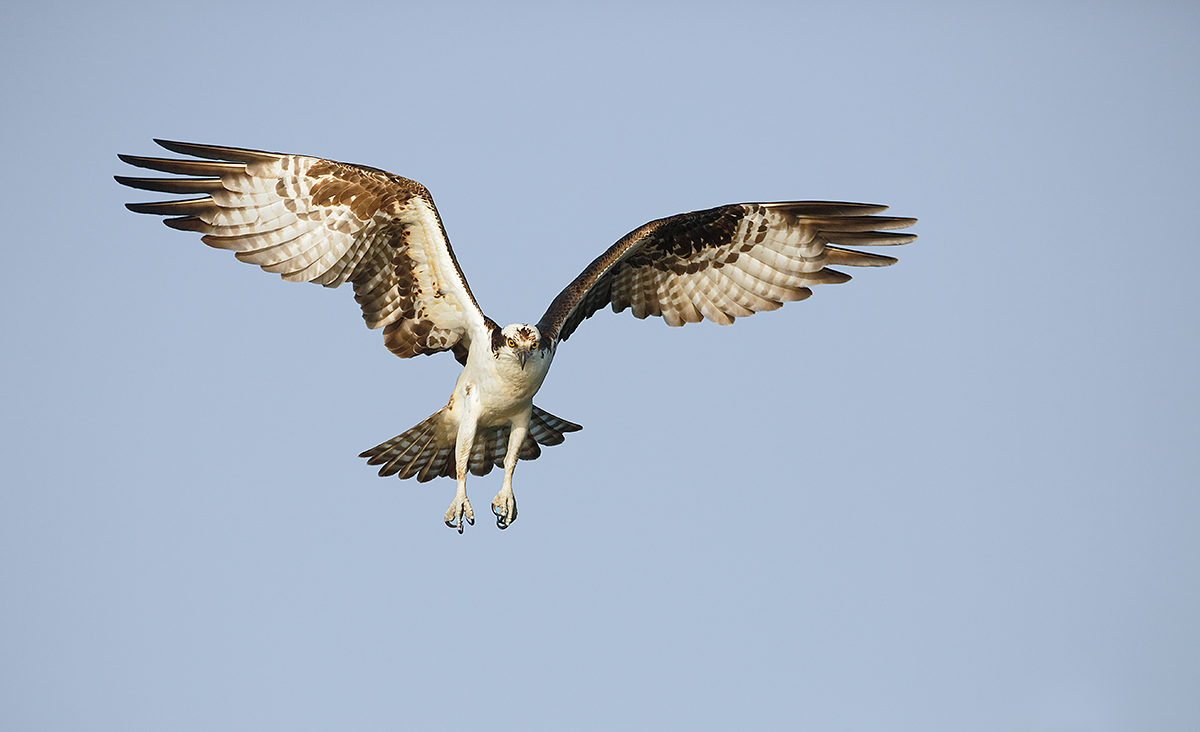
|
|
This Osprey image was also created on Jim Neiger’s pontoon boat on Lake Blue Cypress on Friday morning past at 8:46am in full sun with the Canon EF 200-400mm f/4L IS USM Lens with Internal 1.4x Extender (hand held with the internal extender in place at 467mm–I needed to zoom in a bit more) and the Canon EOS 5D Mark III. ISO 800. Evaluative metering +2/3 stop off the blue sky 30 degrees up from the horizon: 1/3200 sec. at f/7.1 in Manual mode. AWB.
Central Sensor/AI Servo-Surround/Rear Focus AF just caught the top of the bird’s head and was of course active at the moment of exposure. Click here to see the latest version of the Rear Focus Tutorial. Click on the image to see a larger version.
|
My Response
Initial AF acquisition with a 5D III will always be a bit slower than with the 1D X because of differences in the power of the camera batteries. (Even with the Canon BG-E11 Battery Grip for 5D Mark III cmera with the extra Canon LP-E6 Rechargeable Lithium-Ion battery (7.2V, 1800mAh), the camera only uses one battery at a time. But in all other respects the AF system of the 5D III is superb right on par with the AF system of the 1D X in terms of AF tracking accuracy. In addition, all lenses are a bit slower in initial AF acquisition with a TC in place as compared to using the lens alone….
That said I am positive that the 5D III/200-400 combo would acquire focus almost instantaneously at 400mm and be just fine at 560mm. Just be sure to have the limit range switch set to far (rather than full). Pre-focusing manually so that bird is roughly in focus eliminates all problems with the speed of initial focusing acquisition whether the TC is in place or not….. In addition, I have found the 200-400 amazing for flight–the ability to zoom out as a bird approaches is extremely wonderful when doing flight photography.
Now don’t get me wrong here, the 1D X kills the 5D III for flight because of its faster initial focusing acquisition and its blazingly fast frame rate. My two main points here are that the 5D Mark III is a more than adequate body for flight photography and that it would do just fine with the 200-400 even with the internal TC in place.
During a follow-up phone conversation I promised that when I went our with Jim Neiger on Friday past that I would do all of my flight photography with the 200-400 with the internal TC in place. So I did. That rig, as you can see here, did just fine as I had predicted with the Ospreys. I did have some trouble with Barred Owls flying at high speed right down the lens barrel. I am not positive that the 1D X would have done better but I suspect that it would have been able to re-acquire focus faster than the 5D III in this difficult and specialized situation. Come to think of it I have never been very good with birds flying right at me…. Jim Neiger is so skilled in this area that it would make most folks sick to watch him in action….
BTW
After our phone conversation Brad Smith kindly use one of our affiliate links to order a 200-400. Thanks a stack Brad. If you have any gear questions please feel free to shoot me an e-mail.
|
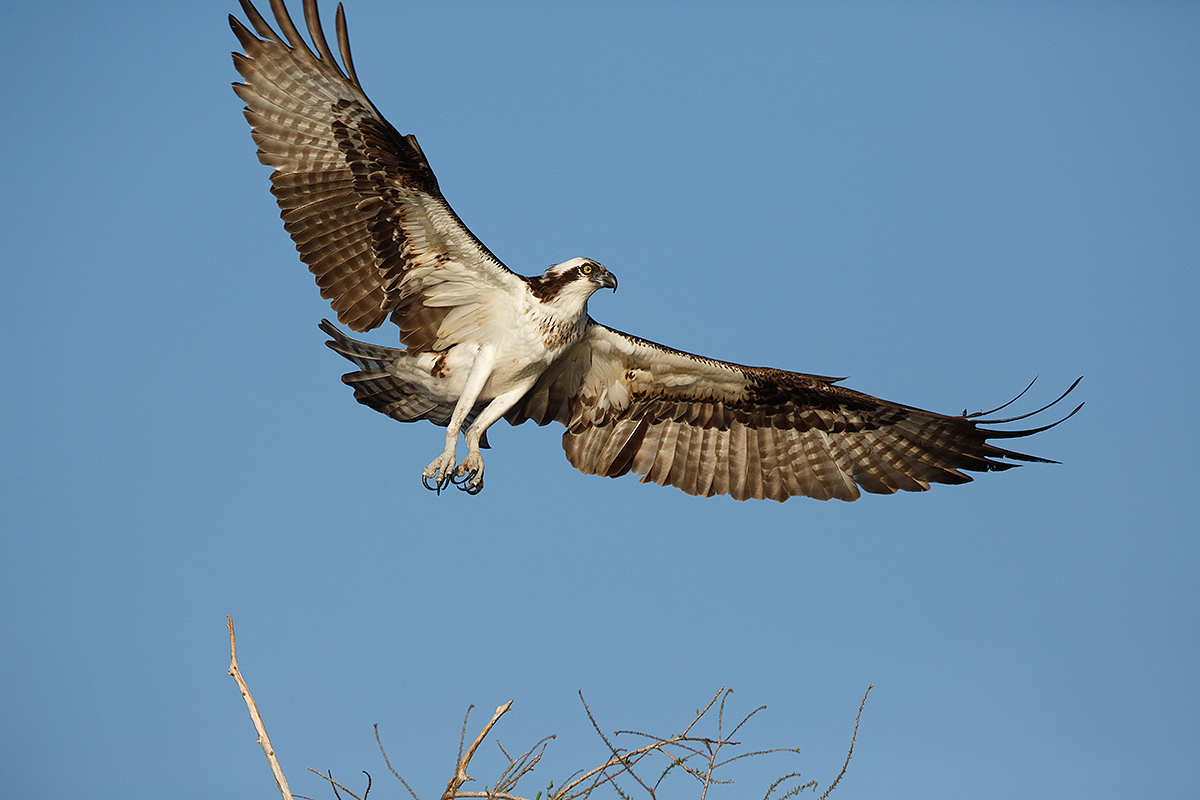
|
|
This Osprey image was also created on Jim Neiger’s pontoon boat on Lake Blue Cypress on Friday morning past at 8:20am in full but still soft sunlight with the Canon EF 200-400mm f/4L IS USM Lens with Internal 1.4x Extender (hand held with the internal extender in place at 436mm) and the Canon EOS 5D Mark III. ISO 800. Evaluative metering +1 stop off the blue sky 30 degrees up from the horizon: 1/3200 sec. at f/8 in Manual mode. AWB.
61-point/AI Servo-Surround/Rear Focus AF on the base of the far wing that was on the same plane as the bird’s eye was active at the moment of exposure. Click here to see the latest version of the Rear Focus Tutorial. Click on the image to see a larger version.
|
Operator Error
When you have a great flight situation, have a zoom lens in your hand, fail to get the bird centered in the frame, catch the perfect, fully lit wingspread, and wind up clipping the wingtips, there is only one place to look: in the mirror.
|
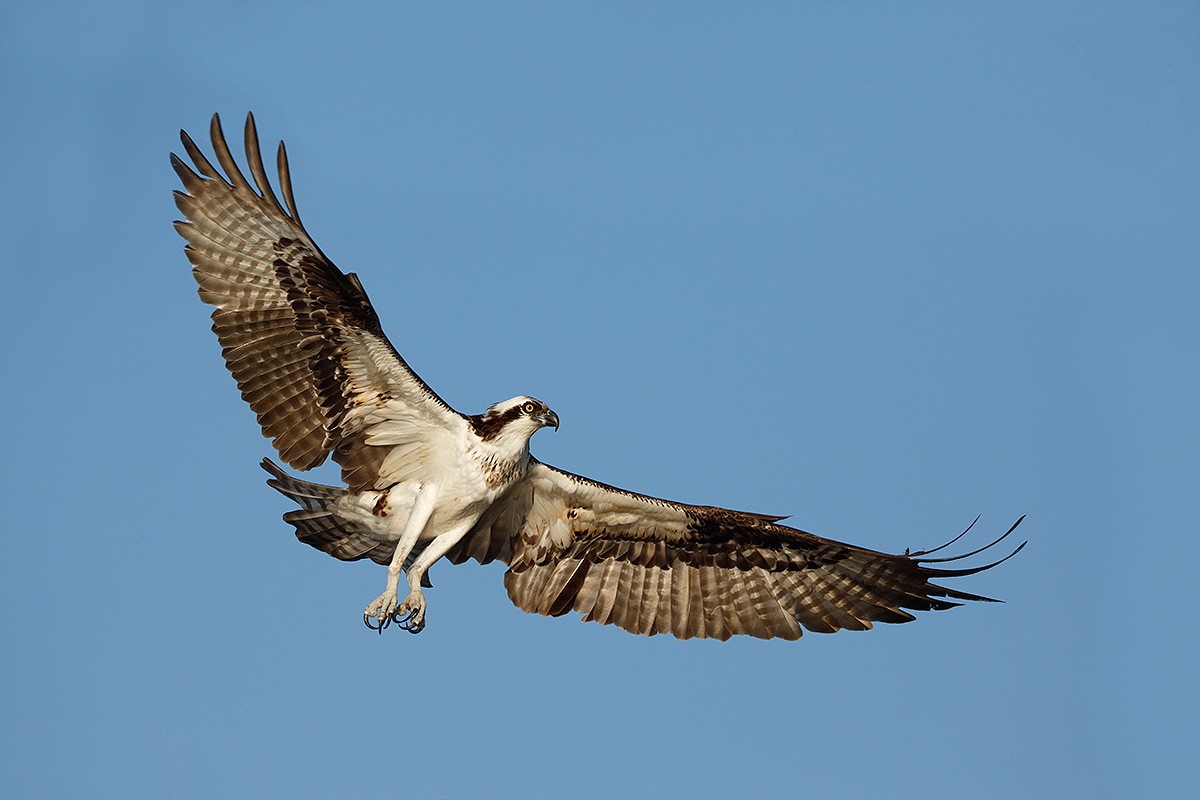
|
|
This is the optimized version of the image immediately above.
|
APTATS I to the Rescue
Using the techniques detailed in the 4th tutorial in APTATS I, “Clipped Feather Tip Repair,” it took me only ten minutes to more than salvage the Osprey image with the 3 clipped primaries. I used the tip of the 5th primary to replace the missing tip of the 4th primary. And I used the tip of the first primary to replace the missing tips of the 2nd and 3rd primaries. I did work both large and carefully. The advanced knowledge of Layer Masking that I picked up from APTATS II was of course quite helpful in fine-tuning the various wingtip layers.
APTATS I & II
Learn the details of advanced Quick Masking techniques in APTATS I. Mention this blog post and apply a $5 discount with phone orders only. Learn advanced Layer Masking Techniques in APTATS II. Mention this blog post and apply a $5 discount with phone orders only. Buy the pair, APTATS I and APTATS II and we will be glad to apply at $15 discount with phone orders only.
Digital Basics
Are you tired of making your images look worse in Photoshop? Do you have no clue as to how I optimized the images above? Everything above plus tons more is detailed in my Digital Basics File, an instructional PDF that is sent via e-mail. It includes my complete digital workflow, dozens of great Photoshop tips, the use of Contrast Masks, several different ways of expanding canvas, all of my time-saving Keyboard Shortcuts, Quick Masking, Layer Masking, and NIK Color Efex Pro basics, my killer image clean-up techniques, Digital Eye Doctor, creating time-saving actions, and lots more.
The DPP RAW Conversion Guide
After seeing the accurate colors that I get from my DPP RAW conversions, Japan in Winter co-leader Paul McKenzie switched to DPP conversions and Denise Ippolito is considering doing the same. Now that is amazing…. To learn why I use Canon’s Digital Photo Professional (DPP) to convert every image that I work on, click here.
If It Ain’t Broke, Don’t Fix It
Yet Another Gatorland Short Notice Saturday Full-Day In-the-Field Workshop
Saturday March 29, 2014. 7:15am till 10:15am & 4:00pm till dusk. Lunch, image review, and Photoshop session included. Limit 6. A very small group is again likely: $399.
The cost of your Gatorland Photographer’s Pass is not included.
Gatorland is so good right now that I am going back next Saturday (March 29). Enticement tomorrow. Head portraits of Great Egrets are pretty much guaranteed even with an intermediate zoom lens. Nest building and flight likely. Here’s the story: last week there were about two dozen photographers at Gatorland on Saturday past. Aside from two photographers nobody had a clue as to how to make a good image…. Yesterday it was even worse; pretty much no one had a clue… Most folks just stand in one spot and point and shoot. Without regard for light angle or background. Join me on this, the 3rd Gatorland Short Notice Saturday Full-Day In-the-Field Workshop and you will learn to spot the good situations, to choose the best perspective, to see and understand the light, to get the right exposure every time after making a single test exposure, and to design pleasing images by mastering your camera’s AF system. A big part of the above is that you will learn how and why you must work in Manual mode 90% of the time at Gatorland. That is exactly what Jim Weertz learned yesterday.
At lunch we will review my images, take a look at five of your best images from the morning session (for those who opt to bring their laptops), and process a few of my images in Photoshop after converting them in DPP. That followed by Instructor Nap Time. Last Saturday all 3 folks had a great time and learned a ton. And the weather for this coming Saturday is looking good.
Payment in full via credit card is due upon registering. Please call Jim or Jennifer at 863-692-0906 to register. Ask for me if you have any questions.
Lake Blue Cypress with Jim Neiger
Over the next two weeks Jim Neiger and I will be offering full day Osprey Heaven In-the-Field Workshops. Rates and potential dates will be announced soon. If you are interested please shoot me an e-mail; group size will be strictly limited to four hand holding photographers.
Support the BAA Blog. Support the BAA Bulletins: Shop B&H here!
We want and need to keep providing you with the latest free information, photography and Photoshop lessons, and all manner of related information. Show your appreciation by making your purchases immediately after clicking on any of our B&H or Amazon Affiliate links in this blog post. Remember, B&H ain’t just photography!


 


Amazon
Everyone buys something from Amazon, be it a big lens or deodorant. Support the blog by starting your search by clicking on the logo-link below. No purchase is too small to be appreciated; they all add up. Why make it a habit? Because I make it a habit of bringing you new images and information on an almost daily basis.
Typos
In all blog posts and Bulletins, feel free to e-mail or to leave a comment regarding any typos, wrong words, misspellings, omissions, or grammatical errors. Just be right. 🙂
March 22nd, 2014 113
This post marks 113 straight days with a new educational blog post. What’s wrong with me??? With so many folks getting in the habit of using our B&H and Amazon links why quit now? To show your appreciation for my efforts here, we do ask that you use our B&H and Amazon affiliate links for all of your B&H and Amazon purchases. Please check the availability of all photographic accessories in the BIRDS AS ART Online Store. We sell only what I use and depend on. We will not sell you junk. We know what you need to make creating great images easy and fun. And we are always glad to answer your gear questions via e-mail.
You can find the following items in the store: Gitzo tripods, Mongoose M3.6 and Wimberley heads, plates, low feet, and accessories, flash brackets, , Delkin e-film Pro Compact Flash Cards, LensCoat products, and our unique line-up of educational materials including ABP I & II, Digital Basics, Site and Set-up e-Guides, Canon and Nikon Camera Users and AF e-Guides, and MP-4 Photoshop video tutorials among others.
We would of course appreciate you using our B&H and Amazon affiliate links for all of your B&H and Amazon major gear, video, electronic, household, and personal purchases. For the photographic stuff mentioned in the paragraph above we would of course greatly appreciate your business. Here is a huge thank you to the many who have been using our links on a regular basis and visiting the BAA Online store as well.
I had a great morning with Jim Neiger and the Ospreys, came home, took a nap, took a swim, had an ice bath, and cooked dinner. I prepared this blog post in about 1 1/2 hours on Friday and plan to publish it early on Saturday before I head to Gatorland with single client and new friend Jim Weerts. I need to get to bed early.
ps: At 4:23am Saturday morning I learned that old friend and multiple IPT veteran Peter Hawrylyshyn will be joining us at Gatorland for the day. Talk about the last minute…
Is It Too Cute? Is It Phony? Or Both?
If you missed this blog post, “Is It Too Cute? Is It Phony? Or Both?,” you might want to check it out first here so that everything below will make sense.
Late to the Party
It was 12 minutes after 7pm on July 24, 2013 on last summer’s Nickerson Beach Baby Beach-nesting Birds IPT. I had taken a walk with a few of the participant down to the ocean to look for oystercatcher chicks getting fed. When we walked back up to the rest of the group everyone was excitedly photographing our favorite nest while sitting behind their longest lens. The nest, with two small chicks, was located just outside the colony ropes. When one of the adults was incubating, we kept our distance. But with the cloudy weather both adults were often away from the nest at the same time. It was then that we approached slowly and photographed the two little ones.
As I got closer we wondered what all the excitement was about. Everyone was giggling at the sight of the upside down chick with its legs in the air. I only had a chance to make about a half dozen images when the upside-down chick righted itself. One of the adults landed by the nest so we all backed up slowly on our butts or knees. I kept only two images, the one above and the one below.
The Image Above
For the image above, I focused on the chicks legs. The chick on our right is simply not sharp as there was nowhere near enough depth-of-field even at f/11. Note that wide open was f/8 so I was only stopped down one stop. I love the up-in-the-air pink feet but I did not like the the eye of the upside-down bird was hidden behind the small piece of wood and I did not at all like that the chick on our right was soft.
The Second Image
With only one leg in the air, and the left-hand chick’s head turned completely away, the only thing that the second image had going for it was that the bird on the right was sharp….
Coming Clean
First, I decided to paint a Quick Mask of the sharp chick from the second image, put the selection on a layer, and cover the soft chick in the first image. That went fairly well though I carelessly left a small halo above the head. That done, I still did not like the way the head of the chick with the flailing legs was obscured. Then, after noticing that the bill of the chick now on the right was juxtaposed and angled roughly the same as that of the chick on the left, I came up with a plan. I painted a Quick Mask of the right hand head, put it on a layer, and used the Move Tool and the Transform Tool to put it in place. I was able to fine-tune things using Layer Masks, several smaller Quick Masks, the Patch Tool, and the Spot-healing Brush. As suggested by Denise Ippolito who saw and early version of the optimized image, I cleaned the sand off the head on the left and even moved the central brown marking to the right in hopes that no one would notice that the two heads were in fact the same…. None-the-less, two folks, BK UK and Wayne Rundell, both figured out what I had done by paying close attention to detail. Way to go guys!
What’s Different?
Taking the first image as the “original” what other changes did I make? There are many. Try to note as many as you can and leave a comment.
UK Puffins & Gannet IPT
Details for this great trip have been finalized. Please e-mail me for complete info if you are interested. Needed: one female roommate.
The Optimized Image
The optimized TIF file is of course labeled as a composite. It was fun to be there when it happened, fun to realize the possibilities, and fun to create. You can see the original post and all the comments here.
Digital Basics
Are you tired of making your images look worse in Photoshop? Do you have no clue as to how I optimized the images above? Everything above plus tons more is detailed in my Digital Basics File, an instructional PDF that is sent via e-mail. It includes my complete digital workflow, dozens of great Photoshop tips, the use of Contrast Masks, several different ways of expanding canvas, all of my time-saving Keyboard Shortcuts, Quick Masking, Layer Masking, and NIK Color Efex Pro basics, my killer image clean-up techniques, Digital Eye Doctor, creating time-saving actions, and lots more.
APTATS I & II
Learn the details of advanced Quick Masking techniques in APTATS I. Mention this blog post and apply a $5 discount with phone orders only. Learn advanced Layer Masking Techniques in APTATS II. Mention this blog post and apply a $5 discount with phone orders only. Buy the pair, APTATS I and APTATS II and we will be glad to apply at $15 discount with phone orders only.
The DPP RAW Conversion Guide
After seeing the accurate colors that I get from my DPP RAW conversions, Japan in Winter co-leader Paul McKenzie switched to DPP conversions and Denise Ippolito is considering doing the same. Now that is amazing…. To learn why I use Canon’s Digital Photo Professional (DPP) to convert every image that I work on, click here.
|
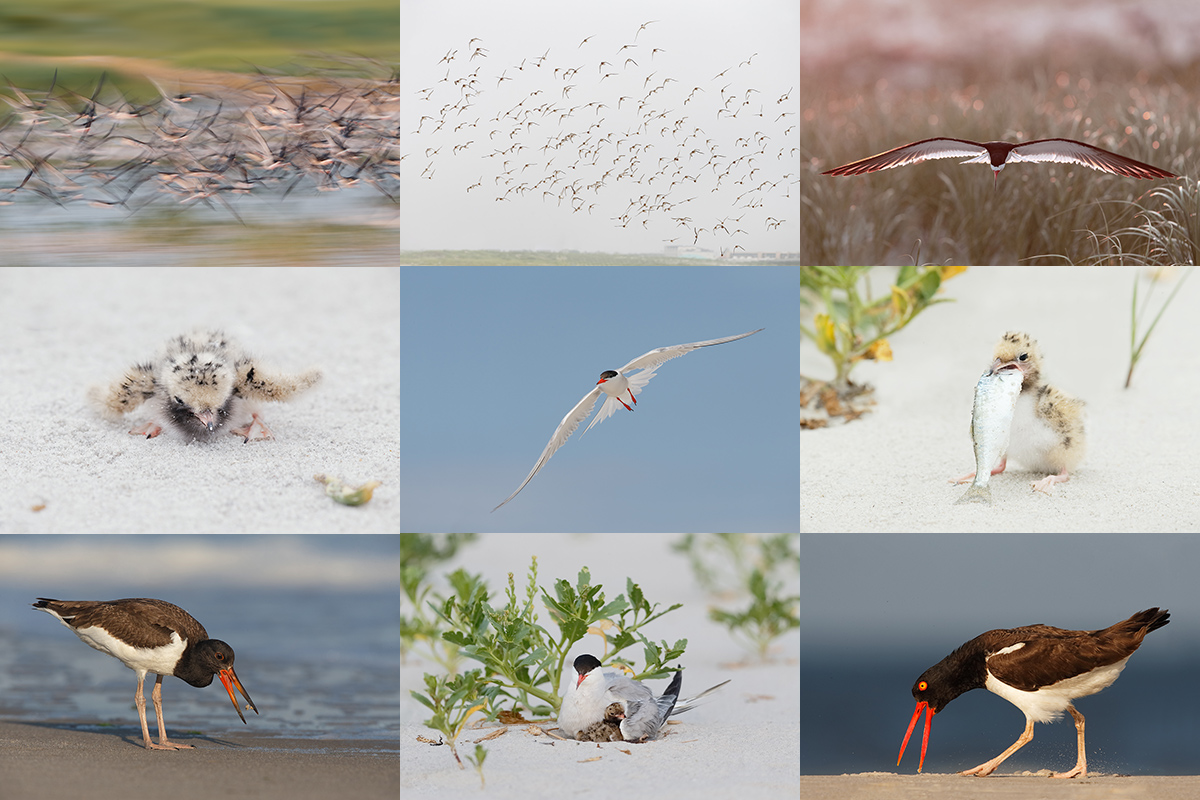
|
|
Nickerson Beach 2013 IPT images and card design copyright 2013: Arthur Morris/BIRDS AS ART. From upper left to right clockwise: skimmer blur, Sanderling flock with ocean and Long Beach, LI, NY in the background, backlit skimmer landing, Common Tern chick eating baby Bluefish, displaying American Oystercatcher, Common Tern brooding chick, young oystercatcher eating sand crab, newborn tern chick, adult Common Tern in flight.
Click on the image to enjoy a larger version.
|
Nickerson Baby Beach-nesting Birds IPT: 3-Full Days/July 15-17, 2014: $1199. Introductory meet and greet: 8pm, Monday, July 14, 2014. Co-leaders Arthur Morris and Denise Ippolito
Join us on Long Island, NY next summer to photograph Black Skimmers, Common Terns with chicks, American Oystercatcher families, and possibly some just-hatched Black Skimmer chicks. The opportunities will include chances to photograph a variety of breeding behaviors including courtship feeding, display flight and combat, and copulations. Car-pooling is recommended; if we opt to return to the beach before 5pm there is a $30/vehicle parking fee that is not included so it is best to share that expense. Parking in the morning is free.
A $499 non-refundable deposit is required to hold your slot for this IPT. Your balance is due 2 months before the date of the IPT and is also non-refundable. If the trip fills, we will be glad to apply a credit applicable to a future IPT for the full amount less a $100 processing fee. If we do not receive your check for the balance on or before the due date we will try to fill your spot from the waiting list. If your spot is filled, you will lose your deposit. If not, you can secure your spot by paying your balance.
Please print, complete, and sign the form that is linked to here and shoot it to us along with your deposit check (made out to “Arthur Morris.”) Though we prefer a check, you can also leave your deposit with a credit card by calling the office at 863-692-0906. If you register by phone, please print, complete and sign the form as noted above and either mail it to us or e-mail the scan.
If you have any questions, please feel free to contact me via e-mail
|
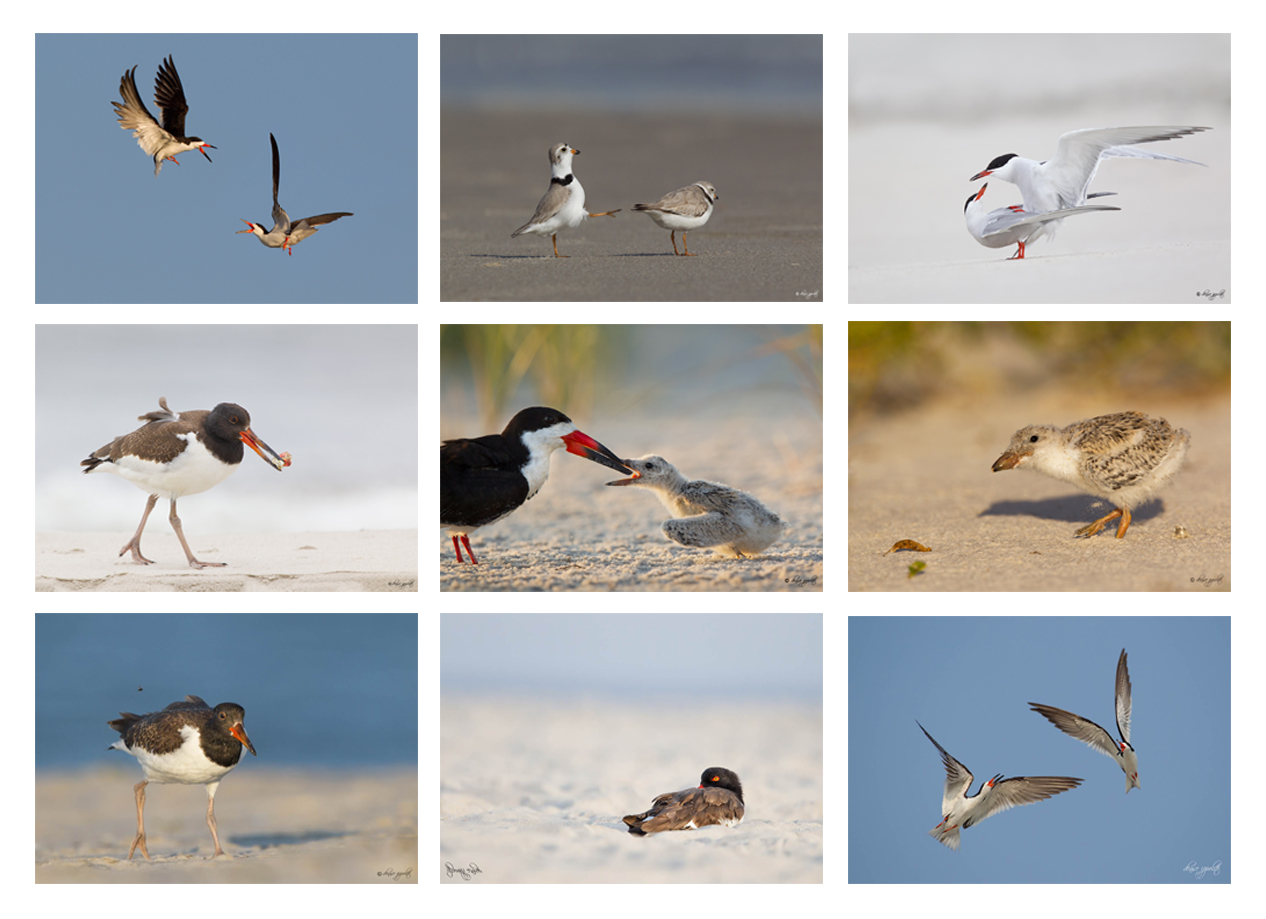
|
|
Nickerson Beach Summer 2013 images and card design copyright 2013: Denise Ippolito/A Creative Adventure. From upper left to right clockwise: Black Skimmers battling, Piping Plover goose-stepping, Common Terns copulating, Black Skimmer chick, skimmer aerial battle, adult oystercatcher sleeping on beach, juvenile oystercatcher striding, juvenile oystercatcher with prey item, backlit skimmer chick being fed at dawn.
Click on the image to enjoy a larger version.
|
Denise’s Card
As I mentioned above, the skimmers were both low in numbers and late nesting last July. Typically there would be lots of nests and more than a few small chicks on those dates. All of Neesie’s images above were made within 2 weeks of the IPT and the skimmer chicks in particular give a much more typical picture of activity in mid-July.
Support the BAA Blog. Support the BAA Bulletins: Shop B&H here!
We want and need to keep providing you with the latest free information, photography and Photoshop lessons, and all manner of related information. Show your appreciation by making your purchases immediately after clicking on any of our B&H or Amazon Affiliate links in this blog post. Remember, B&H ain’t just photography!


 


Amazon
Everyone buys something from Amazon, be it a big lens or deodorant. Support the blog by starting your search by clicking on the logo-link below. No purchase is too small to be appreciated; they all add up. Why make it a habit? Because I make it a habit of bringing you new images and information on an almost daily basis.
Some folks with browser problems are not seeing the Amazon logo links. They can use the affiliate link here to support the blog.
Typos
In all blog posts and Bulletins, feel free to e-mail or to leave a comment regarding any typos, wrong words, misspellings, omissions, or grammatical errors. Just be right. 🙂
March 21st, 2014 112
This post marks 112 straight days with a new educational blog post. With so many folks getting in the habit of using our B&H and Amazon links why quit now? To show your appreciation for my efforts here, we do ask that you use our B&H and Amazon affiliate links for all of your B&H and Amazon purchases. Please check the availability of all photographic accessories in the BIRDS AS ART Online Store. We sell only what I use and depend on. We will not sell you junk. We know what you need to make creating great images easy and fun. And we are always glad to answer your gear questions via e-mail.
You can find the following items in the store: Gitzo tripods, Mongoose M3.6 and Wimberley heads, plates, low feet, and accessories, flash brackets, , Delkin e-film Pro Compact Flash Cards, LensCoat products, and our unique line-up of educational materials including ABP I & II, Digital Basics, Site and Set-up e-Guides, Canon and Nikon Camera Users and AF e-Guides, and MP-4 Photoshop video tutorials among others.
Note: We almost never have Mongoose M3.6 heads in stock. We sell them as fast as we get them. We had three in stock the other day. Now we have none in stock…. The best way to ensure getting one of these great heads for your intermediate or super-telephoto lens is to call Jim now and place your order. You are then ensured of getting one from our next shipment. We will not of course bill your credit card until the item ships or drop-ships.
We would of course appreciate you using our B&H and Amazon affiliate links for all of your B&H and Amazon major gear, video, electronic, household, and personal purchases. For the photographic stuff mentioned in the paragraph above we would of course greatly appreciate your business. Here is a huge thank you to the many who have been using our links on a regular basis and visiting the BAA Online store as well.
I prepared this blog post in about 1 1/2 hours on Thursday evening and plan to publish it early on Friday. I will be spending the morning on Jim Neiger’s pontoon boat on Lake Blue Cypress photographing Ospreys. I believe that there may be an opening on Jim’s last Osprey Heaven workshop. Click here and scroll down for contact info and the skinny on all of Jim’s upcoming workshops.
|

|
|
This Snow Geese image was created with the Canon 15mm fisheye lens (now replaced by the Canon EF 8-15mm f/4L Fisheye USM lens and the Canon EOS-1D X. ISO 400. Evaluative metering -1 1/3 stops as framed: 1/400 sec. at f/22 in Av Mode. Color temperature: 7000.
Central Sensor/Surround/AI Servo/Rear Focus AF as framed active at the moment of exposure. Click here to see the latest version of the Rear Focus Tutorial. Click on the image to see a larger version.
|
The Photoshop CS-6 Basic Tab “Tonal Adjustment” Sliders
When I first started poking around Photoshop CS-6 about six months ago, I noted the new Whites slider on the Basic tab so I called Tim Grey to get his take on the CS-6 Exposure sliders, especially on the new White slider. He kindly explained things to me as I took careful notes in an e-mail to myself. I have no intention of using CS-6 for my RAW conversions as I greatly prefer the colors that I get from Canon’s DPP (Digital Photo Professional); they match what I call the color space in my mind if that makes sense…. In any case, over the past month several folks have asked about the new slider in CS-6 so I went looking for the e-mail. No luck. Yesterday I e-mailed Tim asking if the information that I was seeking was available online.
Here is his answer:
Artie,
Doing great, and trust you’re also well. A video training course I recorded on Adobe Camera Raw features a lesson on the basic tonal adjustments (which I think are the ones you’re looking for), and it just so happens that lesson is one of the free “preview” videos available. So, you can watch that video here. Let me know if you have questions.
Tim
I urge everyone who converts their RAW files in either Photoshop or Lightroom (where the conversion sliders are quite similar) to watch “Basic Tonal Adjustments,” the first of the three videos you will find at the link. (Note: the 2nd video covers HSL–Hue/Saturation/Luminance–adjustments; the 3rd video deals with making grayscale conversions. The 3 videos play consecutively. In this blog post, I will–though I found the other 2 interesting and informative–be discussing only the 1st video.) BTW, Tim has a really cool speaking voice.
Tim begins by setting the white point by adjusting the Exposure slider while holding down the Alt key (the Option key on a Mac) until clipping shows and then backing off a bit “till the whites look good.” Next he recommends doing the exact same thing with the Whites slider, and again suggests backing off a bit so that the brightest whites maintain details. Then he adjusts the Blacks slider, again while holding down the Alt key (the Option key on a Mac) until clipping appears, and then backing off a bit while considering the overall image.
He explains that moving the Highlights slider is similar to moving the Whites slider but that the changes with the former affect a wider range of tonalities than with the latter. He continues in the same vein: moving the Shadows slider is similar to moving the Blacks slider but the changes with the former affecting a wider range of tonalities than with the latter. He adjusts the Shadows and Highlights sliders after first adjusting the Exposure slider followed by the Whites and Blacks sliders.
As I have been looking through last year’s Bosque file recently I chose a fish eye image for my ACR test drive.
Be sure to check out Tim’s Photoshop CS-6 Raw Workshop video set here. Those of you who are not receiving Tim’s “Ask Tim Grey eNewsletter (Providing Answers to Photographers for Over a Dozen Years…) are missing tons of great free info almost every day. Learn more on Tim’s ten year anniversary blog post here. It is a wonderful and interesting read.
|
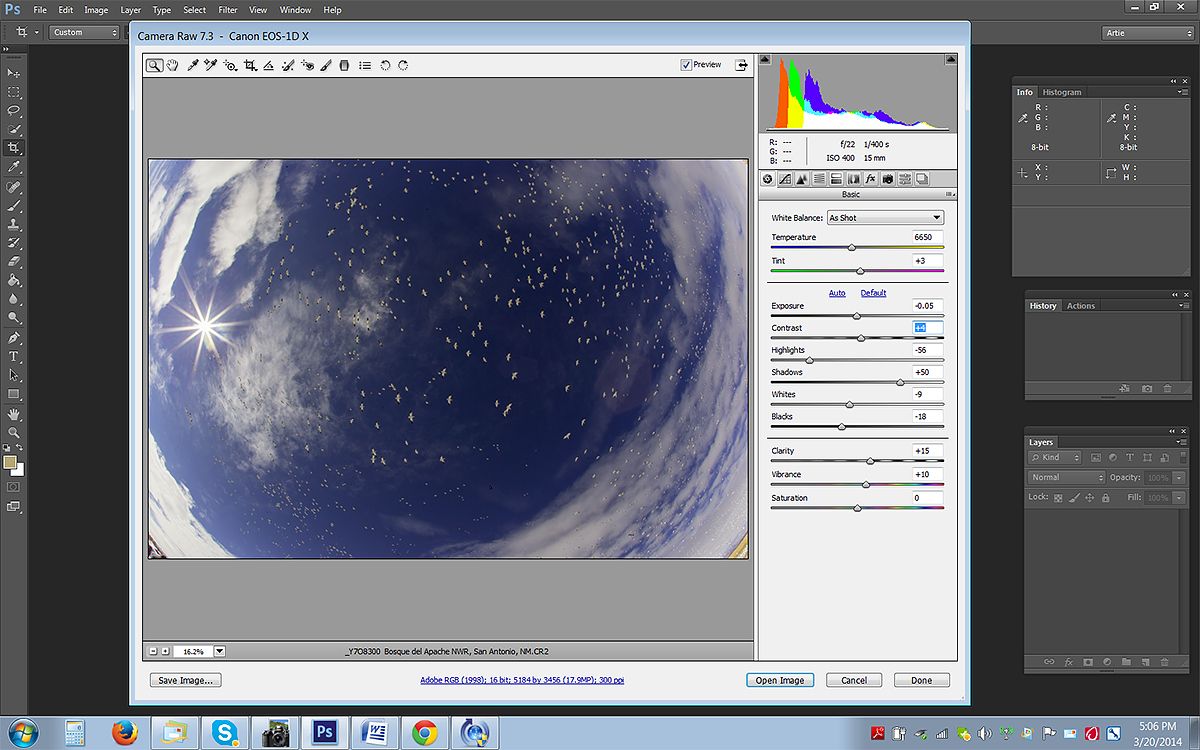
|
|
This is an ACR conversion window screen capture. If you click on it to enlarge it most should be able to read the slider names and values.
|
Basic Tonal Adjustments for the Snow Goose Fisheye Image
If you click on the screen capture above you will be able to note the values on the various sliders. First I moved the Exposure slider to the left to -0.05 darkening the image overall just a bit. Next I experimented a bit and found that by first moving the Highlights slider to the left to -56 and the Whites slider to the left to -9 that I was able to bring down the starburst so that it showed no clipping. I moved the Blacks slider to the clipping point and then backed off just a bit to -18. That left the sky a very dark blue so I moved the Shadows slider to +50 and was happy with my tonal adjustments.
Image Questions
Why f/22?
Why -1 1/3 stops?
Another Gatorland Short-Notice Saturday Full-Day In-the-Field Workshop
Saturday March 22, 2014. 7:15am till 10:15am & 4:00pm till dusk. Lunch, image review, and Photoshop session included. Limit 6/Openings 5. A very small group is again likely: $399.
Special Incentive: those who sign up at the last minute, i.e., today, Friday March 21, 2014, are invited to be at my house on Sunday tomorrow for a free one hour photo session with Sandhill Crane colts and chicks…
You will need to call before 9pm; if no answer be sure to shoot me an e-mail before 6pm with a callback number.
You can see a slew of great Gatorland images from the previous Saturday Short-Notice Gatorland IPT here.
The cost of your Gatorland Photographer’s Pass is not included.
Gatorland is so good right now that I am going back this Saturday to try for tiny Great Egret chicks in the nest. Head portraits of this species in full breeding plumage are pretty much guaranteed even with an intermediate zoom lens. Nest building and flight likely. Here’s the story: there about two dozen photographers at Gatorland on Saturday past. Aside from one photographer from Slovakia and another, from the UK, wearing a blue and white checked shirt, nobody had a clue as to how to make a good image…. Most folks just stand in one spot and point and shoot. Without regard for light angle or background. Join me on this, the 2nd Gatorland Short Notice Saturday Full-Day In-the-Field Workshop and you will learn to spot the good situations, to choose the best perspective, to see and understand the light, to get the right exposure every time after making a single test exposure, and to design pleasing images by mastering your camera’s AF system. A big part of the above is that you will learn how and why you must work in Manual mode 90% of the time at Gatorland. That is one of the things that Dana-see her e-mail below, and Chris Billman learned last Saturday.
At lunch we will review my images, take a look at five of your best images from the morning session (for those who opt to bring their laptops), and process a few of my images in Photoshop after converting them in DPP. That followed by Instructor Nap Time. Last Saturday all 3 folks had a great time and learned a ton. And the weather for this coming Saturday is looking good.
Payment in full via credit card is due upon registering. Please call Jim or Jennifer at 863-692-0906 to register. Ask for me if you have any questions.
UK Puffins & Gannet IPT
Details for this great trip have been finalized; we already have 4 folks signed up; we need just one more for the trip to go. The limit is 10. Please e-mail me for complete info if you are interested.
|
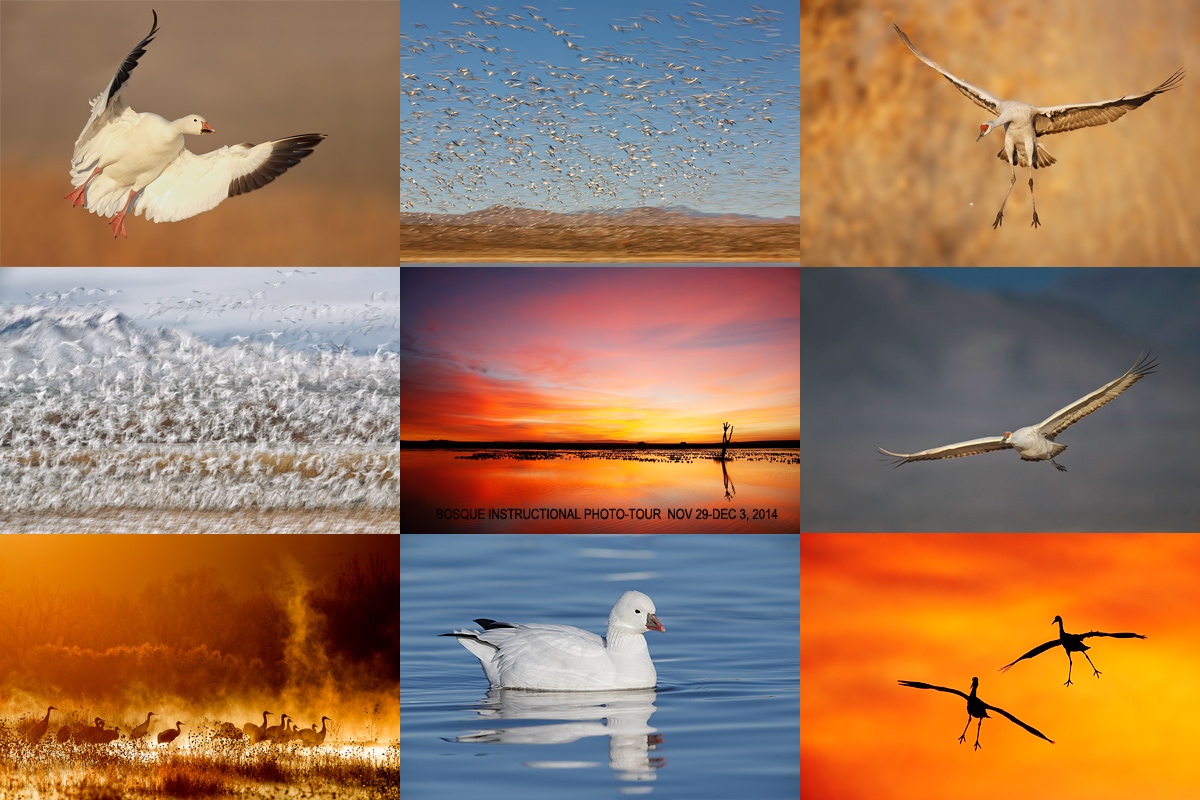
|
|
Join Denise Ippolito and me for four great days of photography and learning at one of our soul places. Please click on the card to enjoy a larger version.
|
Bosque del Apache 2014 BIRDS AS ART/A Creative Adventure Instructional Photo-Tour (IPT). NOV 29-DEC 3, 2014. Totaling 4 FULL-DAYS: $1449. Leaders: Arthur Morris and Denise Ippolito. Introductory Slide program: 7:00pm on Sunday 11/29.
There are now 9 photographers signed up!
Tens of thousand of Snow Geese, 10,000 Sandhill Cranes, ducks, amazing sunrises, sunsets, and blast-offs. Live, eat, and breathe photography with two of the world’s premier photographic educators at one of their very favorite photography locations on the planet. Top-notch in-the-field and Photoshop instruction. This will make 21 consecutive Novembers at Bosque for artie. This will be denise’s 6th workshop at the refuge. Nobody knows the place better than artie does. Join us to learn to think like a pro, to recognize situations and to anticipate them based on the weather, especially the sky conditions, the light, and the wind direction. Every time we make a move we will let you know why. When you head home being able to apply what you’ve learned on your home turf will prove to be invaluable.
This workshop includes 4 afternoon (11/29 through 12/2), 4 morning (11/30 to 12/3) photography sessions, an inspirational introductory slide program after dinner on your own on Saturday, 11/29, all lunches, and after-lunch digital workflow, Photoshop, and image critiquing sessions.
There is never a strict itinerary on a Bosque IPT as each day is tailored to the local conditions at the time and to the weather. We are totally flexible in order to maximize both the photographic and learning opportunities. We are up early each day leaving the hotel by 5:30 am to be in position for sunrise. We usually photograph until about 10:30am. Then it is back to Socorro for lunch and then a classroom session with the group most days. We head back to the refuge at about 3:30pm each day and photograph until sunset. We will be photographing lots of Snow Geese and lots of Sandhill Cranes with the emphasis on expanding both your technical skills and your creativity.
A $449 non-refundable deposit is required to hold your slot for this IPT. Your balance, payable only by check, will be due on 7/25/2014. If you cancel, we will be glad to apply a credit applicable to a future IPT for the amount you have paid less a $100 processing fee, only if the trip sells out. If we do not receive your check for the balance on or before the due date we will try to fill your spot from the waiting list. If your spot is filled, you will lose your deposit. If not, you can secure your spot by paying your balance.
Please print, complete, and sign the form that is linked to here and shoot it to us along with your deposit check (made out to “Arthur Morris.”) You can also leave your deposit with a credit card by calling the office at 863-692-0906. If you register by phone, please print, complete and sign the form as noted above and either mail it to us or e-mail the scan. If you have any questions, please feel free to contact me via e-mail.
|
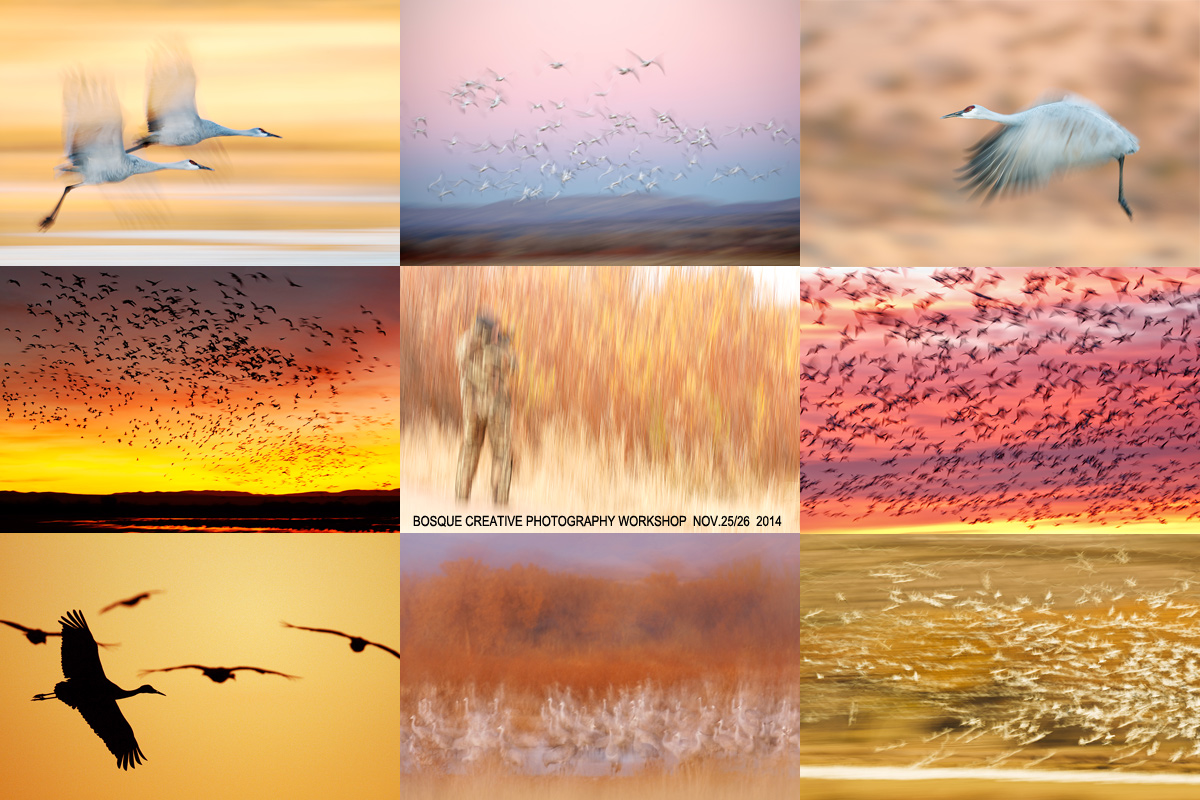
|
|
Join Denise Ippolito and me for two great days of photography, fun, and learning at one of our soul places. We will surely be taking you out of the box on this workshop. Please click on the card to enjoy a larger version.
|
Bosque del Apache 2014 A Creative Adventure/BIRDS AS ART “Creative Photography Instructional Photo-Tour.” (IPT). NOV 24-25, 2014. 2-FULL DAYS: $729. Leaders: Denise Ippolito & Arthur Morris. Introductory Slide program: 7:00pm on Sunday 11/23. 3 signed up.
Get Out of Your Box!
The Creative Bosque IPT is perfect for folks who want to learn to think outside the box, to create new and different images. This workshop is the perfect add-on for folks who are planning on attending the Festival of the Cranes. Learn to unleash your creative juices at the wondrous Bosque del Apache National Wildlife Refuge in San Antonio, New Mexico with two great leaders including the amazingly talented and creative Denise Ippolito. In-the-field instruction will include tips on gear set-up, on creating a variety of pleasing blurs, on getting the right exposure, and on designing pleasing images. And lots more. From vertical pan blurs to subject motion blurs to zoom blurs to multiple exposures we will cover it all. If conditions are perfect, we will not hesitate to take advantage of them to do some traditional bird photography. This workshop will include an inspirational introductory slide program on Sunday evening, 11/23, after dinner on your own, two morning and two afternoon photography sessions, all lunches, a digital workflow and Photoshop session after lunch on Monday, and an image critiquing session after lunch on Tuesday.
A $329 non-refundable deposit is required to hold your slot for this IPT. Your balance, payable only by check, will be due on 7/25/2014. If the trip fills, we will be glad to apply a credit applicable to a future IPT for the full amount less a $100 processing fee. If we do not receive your check for the balance on or before the due date we will try to fill your spot from the waiting list. If your spot is filled, you will lose your deposit. If not, you can secure your spot by paying your balance.
Please print, complete, and sign the form that is linked to here and shoot it to us along with your deposit check (made out to “Arthur Morris.”) You can also leave your deposit with a credit card by calling the office at 863-692-0906. If you register by phone, please print, complete and sign the form as noted above and either mail it to us or e-mail the scan. If you have any questions, please feel free to contact me via e-mail.
Support the BAA Blog. Support the BAA Bulletins: Shop B&H here!
We want and need to keep providing you with the latest free information, photography and Photoshop lessons, and all manner of related information. Show your appreciation by making your purchases immediately after clicking on any of our B&H or Amazon Affiliate links in this blog post. Remember, B&H ain’t just photography!
center>


 


Amazon
Everyone buys something from Amazon, be it a big lens or deodorant. Support the blog by starting your search by clicking on the logo-link below. No purchase is too small to be appreciated; they all add up. Why make it a habit? Because I make it a habit of bringing you new images and information on an almost daily basis.
Some folks with browser problems are not seeing the Amazon logo links. They can use the affiliate link here to support the blog.
Typos
In all blog posts and Bulletins, feel free to e-mail or to leave a comment regarding any typos, wrong words, misspellings, omissions, or grammatical errors. Just be right. 🙂
March 20th, 2014 Another Gatorland Short-Notice Saturday Full-Day In-the-Field Workshop
Right Now, It’s Just Me!
Saturday March 22, 2014. 7:15am till 10:15am & 4:00pm till dusk. Lunch, image review, and Photoshop session included. Limit 6/Openings 6. A very small group is again likely: $399.
The cost of your Gatorland Photographer’s Pass is not included.
Gatorland is so good right now that I am going back this Saturday to try for tiny Great Egret chicks in the nest. Head portraits of this species in full breeding plumage are pretty much guaranteed even with an intermediate zoom lens. Nest building and flight likely. Here’s the story: there about two dozen photographers at Gatorland on Saturday past. Aside from one photographer from Slovakia and another, from the UK, wearing a blue and white checked shirt, nobody had a clue as to how to make a good image…. Most folks just stand in one spot and point and shoot. Without regard for light angle or background. Join me on this, the 2nd Gatorland Short Notice Saturday Full-Day In-the-Field Workshop and you will learn to spot the good situations, to choose the best perspective, to see and understand the light, to get the right exposure every time after making a single test exposure, and to design pleasing images by mastering your camera’s AF system. A big part of the above is that you will learn how and why you must work in Manual mode 90% of the time at Gatorland. That is one of the things that Dana-see her e-mail below, and Chris Billman learned last Saturday.
At lunch we will review my images, take a look at five of your best images from the morning session (for those who opt to bring their laptops), and process a few of my images in Photoshop after converting them in DPP. That followed by Instructor Nap Time. Last Saturday all 3 folks had a great time and learned a ton. And the weather for this coming Saturday is looking good.
Payment in full via credit card is due upon registering. Please call Jim or Jennifer at 863-692-0906 to register. Ask for me if you have any questions.
UK Puffins & Gannet IPT
Details for this great trip have been finalized. Please e-mail me for complete info if you are interested.
111
This post marks 111 straight days with a new educational blog post. With so many folks getting in the habit of using our B&H and Amazon links why quit now? To show your appreciation for my efforts here, we do ask that you use our B&H and Amazon affiliate links for all of your B&H and Amazon purchases. Please check the availability of all photographic accessories in the BIRDS AS ART Online Store. We sell only what I use and depend on. We will not sell you junk. We know what you need to make creating great images easy and fun. And we are always glad to answer your gear questions via e-mail.
You can find the following items in the store: Gitzo tripods, Mongoose M3.6 and Wimberley heads, plates, low feet, and accessories, flash brackets, , Delkin e-film Pro Compact Flash Cards, LensCoat products, and our unique line-up of educational materials including ABP I & II, Digital Basics, Site and Set-up e-Guides, Canon and Nikon Camera Users and AF e-Guides, and MP-4 Photoshop video tutorials among others.
Note: We almost never have Mongoose M3.6 heads in stock. We sell them as fast as we get them. We had three in stock the other day. Now we have none in stock…. The best way to ensure getting one of these great heads for your intermediate or super-telephoto lens is to call Jim now and place your order. You are then ensured of getting one from our next shipment. We will not of course bill your credit card until the item ships or drop-ships.
We would of course appreciate you using our B&H and Amazon affiliate links for all of your B&H and Amazon major gear, video, electronic, household, and personal purchases. For the photographic stuff mentioned in the paragraph above we would of course greatly appreciate your business. Here is a huge thank you to the many who have been using our links on a regular basis and visiting the BAA Online store as well.
This blog post took only 1 1/2 hours to prepare. Enjoy.
Universal Advice for Better Flight Photography…
The Bad
1-Strive to keep the active AF sensor on the bird’s eye, face, neck, or upper breast.
I did not do too well in that department with the image above.
2-Pan faster to keep the bird well back in the frame.
I did not do too well in that department either with the image above.
The Ugly
The bird is too far forward in the frame and the image is not at all level.
The Good
The sharp calling immature goose. The soft light and the snow. The subject perfectly placed on the wide strip of snow.
3-Be sure to have far focus range set so that your lens does not have to search down to minimum focusing distance.
4-Pre-focus manually with your left hand until the bird is roughly in focus before activating AF; this too will speed up initial focusing acquistion.
Keep or Delete?
As you will see below, this was an easy call for me.
|
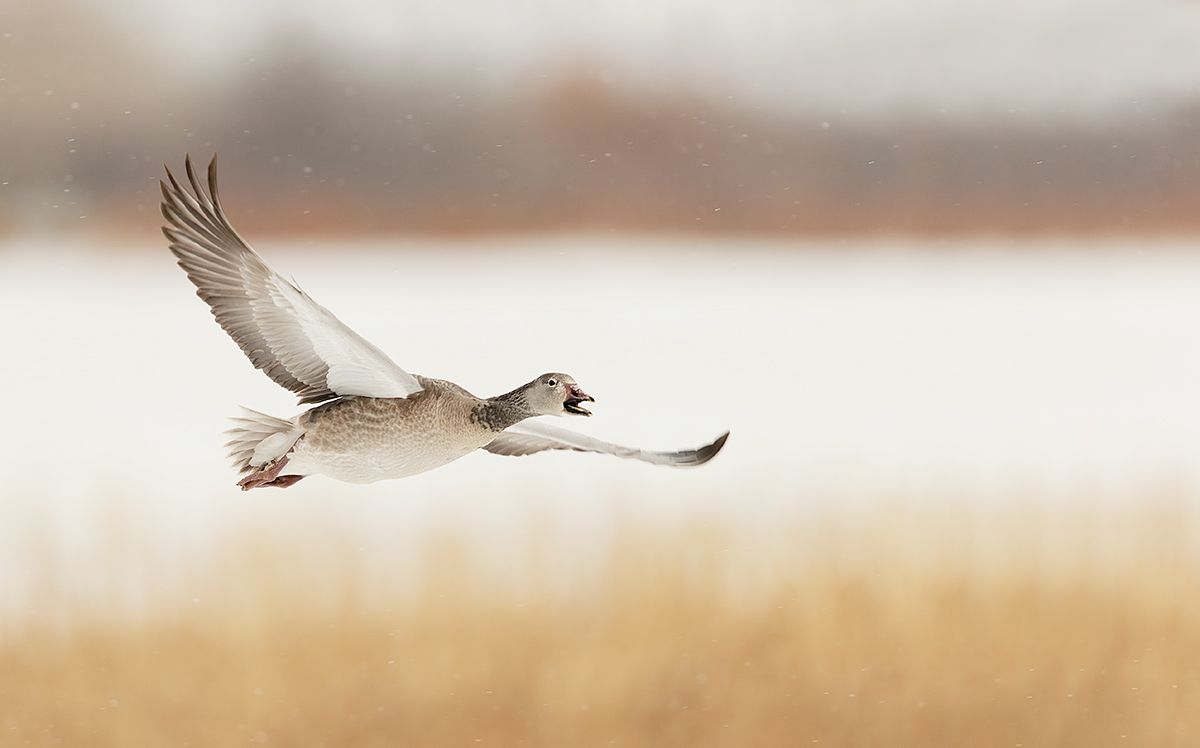
|
|
Using techniques from Digital Basics and APTATS I & II enabled me to create a pleasing sale-able image from a less than ideal image capture in less than 8 minutes.
|
Pretty Good, No?
The Image Optimization
1-convert the image in DPP.
2-level the image
3-fill in the blank canvas using the John Haedo technique.
4-repair the mess along the upper right frame-edge with the Clone Stamp Tool and the Patch Tool
5-move the bird back in the frame four times using techniques from APTATS II, blending the edges via a Regular Layer Mask.
6-use the Spot Healing Brush to eliminate now flake repeats.
7-Use the Patch Tool to eliminate broader repeats in the lower third of the frame.
8-select the bird with the Quick Selection Tool and put it on its own layer.
9-apply a layer of my NIK 50/50 custom pre-set, reduce that to 50% Opacity, and add a small contrast mask.
10-select the face and bill and run a Contrast Mask at 15/65/0 on that layer only and then lighten it is bit.
10-small increase in contrast
Done deal.
The DPP RAW Conversion Guide
After seeing the accurate colors that I get from my DPP RAW conversions, Japan in Winter co-leader Paul McKenzie switched to DPP conversions and Denise Ippolito is considering doing the same. Now that is amazing…. To learn why I use Canon’s Digital Photo Professional (DPP) to convert every image that I work on, click here.
Digital Basics
Are you tired of making your images look worse in Photoshop? Do you have no clue as to how I optimized the images above? Everything above plus tons more is detailed in my Digital Basics File, an instructional PDF that is sent via e-mail. It includes my complete digital workflow, dozens of great Photoshop tips, the use of Contrast Masks, several different ways of expanding canvas, all of my time-saving Keyboard Shortcuts, Quick Masking, Layer Masking, and NIK Color Efex Pro basics, my killer image clean-up techniques, Digital Eye Doctor, creating time-saving actions, and lots more.
APTATS I & II
Learn the details of advanced Quick Masking techniques in APTATS I. Mention this blog post and apply a $5 discount with phone orders only. Learn advanced Layer Masking Techniques in APTATS II. Mention this blog post and apply a $5 discount with phone orders only. Buy the pair, APTATS I and APTATS II and we will be glad to apply at $15 discount with phone orders only.
Flight Plan
5-Get yourself a copy of Jim Neiger’s great eGuide on photographing birds in flight here.
|

|
|
Join Denise Ippolito and me for four great days of photography and learning at one of our soul places. Please click on the card to enjoy a larger version.
|
Bosque del Apache 2014 BIRDS AS ART/A Creative Adventure Instructional Photo-Tour (IPT). NOV 29-DEC 3, 2014. Totaling 4 FULL-DAYS: $1449. Leaders: Arthur Morris and Denise Ippolito. Introductory Slide program: 7:00pm on Sunday 11/29.
There are 8 photographers signed up already!
Tens of thousand of Snow Geese, 10,000 Sandhill Cranes, ducks, amazing sunrises, sunsets, and blast-offs. Live, eat, and breathe photography with two of the world’s premier photographic educators at one of their very favorite photography locations on the planet. Top-notch in-the-field and Photoshop instruction. This will make 21 consecutive Novembers at Bosque for artie. This will be denise’s 6th workshop at the refuge. Nobody knows the place better than artie does. Join us to learn to think like a pro, to recognize situations and to anticipate them based on the weather, especially the sky conditions, the light, and the wind direction. Every time we make a move we will let you know why. When you head home being able to apply what you’ve learned on your home turf will prove to be invaluable.
This workshop includes 4 afternoon (11/29 through 12/2), 4 morning (11/30 to 12/3) photography sessions, an inspirational introductory slide program after dinner on your own on Saturday, 11/29, all lunches, and after-lunch digital workflow, Photoshop, and image critiquing sessions.
There is never a strict itinerary on a Bosque IPT as each day is tailored to the local conditions at the time and to the weather. We are totally flexible in order to maximize both the photographic and learning opportunities. We are up early each day leaving the hotel by 5:30 am to be in position for sunrise. We usually photograph until about 10:30am. Then it is back to Socorro for lunch and then a classroom session with the group most days. We head back to the refuge at about 3:30pm each day and photograph until sunset. We will be photographing lots of Snow Geese and lots of Sandhill Cranes with the emphasis on expanding both your technical skills and your creativity.
A $449 non-refundable deposit is required to hold your slot for this IPT. Your balance, payable only by check, will be due on 7/25/2014. If you cancel, we will be glad to apply a credit applicable to a future IPT for the amount you have paid less a $100 processing fee, only if the trip sells out. If we do not receive your check for the balance on or before the due date we will try to fill your spot from the waiting list. If your spot is filled, you will lose your deposit. If not, you can secure your spot by paying your balance.
Please print, complete, and sign the form that is linked to here and shoot it to us along with your deposit check (made out to “Arthur Morris.”) You can also leave your deposit with a credit card by calling the office at 863-692-0906. If you register by phone, please print, complete and sign the form as noted above and either mail it to us or e-mail the scan. If you have any questions, please feel free to contact me via e-mail.
|

|
|
Join Denise Ippolito and me for two great days of photography, fun, and learning at one of our soul places. We will surely be taking you out of the box on this workshop. Please click on the card to enjoy a larger version.
|
Bosque del Apache 2014 A Creative Adventure/BIRDS AS ART “Creative Photography Instructional Photo-Tour.” (IPT). NOV 24-25, 2014. 2-FULL DAYS: $729. Leaders: Denise Ippolito & Arthur Morris. Introductory Slide program: 7:00pm on Sunday 11/23.
Get Out of Your Box!
The Creative Bosque IPT is perfect for folks who want to learn to think outside the box, to create new and different images. This workshop is the perfect add-on for folks who are planning on attending the Festival of the Cranes. Learn to unleash your creative juices at the wondrous Bosque del Apache National Wildlife Refuge in San Antonio, New Mexico with two great leaders including the amazingly talented and creative Denise Ippolito. In-the-field instruction will include tips on gear set-up, on creating a variety of pleasing blurs, on getting the right exposure, and on designing pleasing images. And lots more. From vertical pan blurs to subject motion blurs to zoom blurs to multiple exposures we will cover it all. If conditions are perfect, we will not hesitate to take advantage of them to do some traditional bird photography. This workshop will include an inspirational introductory slide program on Sunday evening, 11/23, after dinner on your own, two morning and two afternoon photography sessions, all lunches, a digital workflow and Photoshop session after lunch on Monday, and an image critiquing session after lunch on Tuesday.
A $329 non-refundable deposit is required to hold your slot for this IPT. Your balance, payable only by check, will be due on 7/25/2014. If the trip fills, we will be glad to apply a credit applicable to a future IPT for the full amount less a $100 processing fee. If we do not receive your check for the balance on or before the due date we will try to fill your spot from the waiting list. If your spot is filled, you will lose your deposit. If not, you can secure your spot by paying your balance.
Please print, complete, and sign the form that is linked to here and shoot it to us along with your deposit check (made out to “Arthur Morris.”) You can also leave your deposit with a credit card by calling the office at 863-692-0906. If you register by phone, please print, complete and sign the form as noted above and either mail it to us or e-mail the scan. If you have any questions, please feel free to contact me via e-mail.
Support the BAA Blog. Support the BAA Bulletins: Shop B&H here!
We want and need to keep providing you with the latest free information, photography and Photoshop lessons, and all manner of related information. Show your appreciation by making your purchases immediately after clicking on any of our B&H or Amazon Affiliate links in this blog post. Remember, B&H ain’t just photography!
center>


 


Amazon
Everyone buys something from Amazon, be it a big lens or deodorant. Support the blog by starting your search by clicking on the logo-link below. No purchase is too small to be appreciated; they all add up. Why make it a habit? Because I make it a habit of bringing you new images and information on an almost daily basis.
Some folks with browser problems are not seeing the Amazon logo links. They can use the affiliate link here to support the blog.
Typos
In all blog posts and Bulletins, feel free to e-mail or to leave a comment regarding any typos, wrong words, misspellings, omissions, or grammatical errors. Just be right. 🙂
March 19th, 2014 Another Gatorland Short Notice Saturday Full-Day In-the-Field Workshop
Right Now, It’s Just Me!
Saturday March 22, 2014. 7:15am till 10:15am & 4:00pm till dusk. Lunch, image review, and Photoshop session included. Limit 6/Openings 6. A very small group is again likely: $399.
The cost of your Gatorland Photographer’s Pass is not included.
Gatorland is so good right now that I am going back this Saturday to try for tiny Great Egret chicks in the nest. Head portraits of this species in full breeding plumage are pretty much guaranteed even with an intermediate zoom lens. Nest building and flight likely. Here’s the story: there about two dozen photographers at Gatorland on Saturday past. Aside from one photographer from Slovakia and another, from the UK, wearing a blue and white checked shirt, nobody had a clue as to how to make a good image…. Most folks just stand in one spot and point and shoot. Without regard for light angle or background. Join me on this, the 2nd Gatorland Short Notice Saturday Full-Day In-the-Field Workshop and you will learn to spot the good situations, to choose the best perspective, to see and understand the light, to get the right exposure every time after making a single test exposure, and to design pleasing images by mastering your camera’s AF system. A big part of the above is that you will learn how and why you must work in Manual mode 90% of the time at Gatorland. That is one of the things that Dana-see her e-mail below, and Chris Billman learned last Saturday.
At lunch we will review my images, take a look at five of your best images from the morning session (for those who opt to bring their laptops), and process a few of my images in Photoshop after converting them in DPP. That followed by Instructor Nap Time. Last Saturday all 3 folks had a great time and learned a ton. And the weather for this coming Saturday is looking good.
Payment in full via credit card is due upon registering. Please call Jim or Jennifer at 863-692-0906 to register. Ask for me if you have any questions.
Gatorland In-the-Field Kudos
This via e-mail from Dana Campbell of Maryland who signed up virtually at the last second:
It was a wonderful day today! You taught me so much; I am still thinking about it all. I will now go back and read the archives, practice, and make some equipment changes/new purchases (Mongoose M3.6) soon. It was an honor and a pleasure to have met you and spent the day learning from you. You were so patient and generous sharing your knowledge and talent as well as a wonderfully nice and fun person! I hope to be able to join you again soon for an IPT. Thank you. Thank you. Thank you. Sincerely, Dana
UK Puffins & Gannet IPT
Details for this great trip have been finalized. Please e-mail me for complete info.
110
This post marks 110 straight days with a new educational blog post. With so many folks getting in the habit of using our B&H and Amazon links why quit now? To show your appreciation for my efforts here, we do ask that you use our B&H and Amazon affiliate links for all of your B&H and Amazon purchases. Please check the availability of all photographic accessories in the BIRDS AS ART Online Store. We sell only what I use and depend on. We will not sell you junk. We know what you need to make creating great images easy and fun. And we are always glad to answer your gear questions via e-mail.
You can find the following items in the store: Gitzo tripods, Mongoose M3.6 and Wimberley heads, plates, low feet, and accessories, flash brackets, , Delkin e-film Pro Compact Flash Cards, LensCoat products, and our unique line-up of educational materials including ABP I & II, Digital Basics, Site and Set-up e-Guides, Canon and Nikon Camera Users and AF e-Guides, and MP-4 Photoshop video tutorials among others.
Note: We almost never have Mongoose M3.6 heads in stock. We sell them as fast as we get them. We had three in stock the other day. Now we have none in stock…. The best way to ensure getting one of these great heads for your intermediate or super-telephoto lens is to call Jim now and place your order. You are then ensured of getting one from our next shipment. We will not of course bill your credit card until the item ships or drop-ships.
We would of course appreciate you using our B&H and Amazon affiliate links for all of your B&H and Amazon major gear, video, electronic, household, and personal purchases. For the photographic stuff mentioned in the paragraph above we would of course greatly appreciate your business. Here is a huge thank you to the many who have been using our links on a regular basis and visiting the BAA Online store as well.
This blog post took only 1 1/2 hours to prepare. Enjoy.
Is It Too Cute or Is It Phony? Or Both?
I’ve tricked you before. Asked if there were any tell-tale signs of Photoshop hanky panky while presenting an image that was virtually untouched. So I ask again here, do you see any signs of poor Photoshop work? Or do you think that the image file here is an accurate representation of the original capture. If the former, please be specific. Be sure to click on the image to view the larger size as you do your sleuthing.
|

|
|
Nickerson Beach 2013 IPT images and card design copyright 2013: Arthur Morris/BIRDS AS ART. From upper left to right clockwise: skimmer blur, Sanderling flock with ocean and Long Beach, LI, NY in the background, backlit skimmer landing, Common Tern chick eating baby Bluefish, displaying American Oystercatcher, Common Tern brooding chick, young oystercatcher eating sand crab, newborn tern chick, adult Common Tern in flight.
Click on the image to enjoy a larger version.
|
Nickerson Baby Beach-nesting Birds IPT: 3-Full Days/July 15-17, 2014: $1199. Introductory meet and greet: 8pm, Monday, July 14, 2014. Co-leaders Arthur Morris and Denise Ippolito
Join us on Long Island, NY next summer to photograph Black Skimmers, Common Terns with chicks, American Oystercatcher families, and possibly some just-hatched Black Skimmer chicks. The opportunities will include chances to photograph a variety of breeding behaviors including courtship feeding, display flight and combat, and copulations. Car-pooling is recommended; if we opt to return to the beach before 5pm there is a $30/vehicle parking fee that is not included so it is best to share that expense. Parking in the morning is free.
A $499 non-refundable deposit is required to hold your slot for this IPT. Your balance is due 2 months before the date of the IPT and is also non-refundable. If the trip fills, we will be glad to apply a credit applicable to a future IPT for the full amount less a $100 processing fee. If we do not receive your check for the balance on or before the due date we will try to fill your spot from the waiting list. If your spot is filled, you will lose your deposit. If not, you can secure your spot by paying your balance.
Please print, complete, and sign the form that is linked to here and shoot it to us along with your deposit check (made out to “Arthur Morris.”) Though we prefer a check, you can also leave your deposit with a credit card by calling the office at 863-692-0906. If you register by phone, please print, complete and sign the form as noted above and either mail it to us or e-mail the scan.
If you have any questions, please feel free to contact me via e-mail
|

|
|
Nickerson Beach Summer 2013 images and card design copyright 2013: Denise Ippolito/A Creative Adventure. From upper left to right clockwise: Black Skimmers battling, Piping Plover goose-stepping, Common Terns copulating, Black Skimmer chick, skimmer aerial battle, adult oystercatcher sleeping on beach, juvenile oystercatcher striding, juvenile oystercatcher with prey item, backlit skimmer chick being fed at dawn.
Click on the image to enjoy a larger version.
|
Denise’s Card
As I mentioned above, the skimmers were both low in numbers and late nesting last July. Typically there would be lots of nests and more than a few small chicks on those dates. All of Neesie’s images above were made within 2 weeks of the IPT and the skimmer chicks in particular give a much more typical picture of activity in mid-July.
Support the BAA Blog. Support the BAA Bulletins: Shop B&H here!
We want and need to keep providing you with the latest free information, photography and Photoshop lessons, and all manner of related information. Show your appreciation by making your purchases immediately after clicking on any of our B&H or Amazon Affiliate links in this blog post. Remember, B&H ain’t just photography!




 


Amazon
Everyone buys something from Amazon, be it a big lens or deodorant. Support the blog by starting your search by clicking on the logo-link below. No purchase is too small to be appreciated; they all add up. Why make it a habit? Because I make it a habit of bringing you new images and information on an almost daily basis.
Some folks with browser problems are not seeing the Amazon logo links. They can use the affiliate link here to support the blog.
Typos
In all blog posts and Bulletins, feel free to e-mail or to leave a comment regarding any typos, wrong words, misspellings, omissions, or grammatical errors. Just be right. 🙂
March 18th, 2014 Another Gatorland Short Notice Saturday Full-Day In-the-Field Workshop
Saturday March 22, 2014. 7:15am till 10:15am & 4:00pm till dusk. Lunch, image review, and Photoshop session included. Limit 6. A very small group is again likely: $399.
The cost of your Gatorland Photographer’s Pass is not included.
Gatorland is so good right now that I am going back this Saturday to try for tiny Great Egret chicks in the nest. Head portraits of this species in full breeding plumage are pretty much guaranteed even with an intermediate zoom lens. Nest building and flight likely. Here’s the story: there about two dozen photographers at Gatorland on Saturday past. Aside from one photographer from Slovakia and another, wearing a blue and white checked shirt, nobody had a clue as to how to make a good image…. Most folks just stand in one spot and point and shoot. Without regard for light angle or background. Join me on this, the 2nd Gatorland Short Notice Saturday Full-Day In-the-Field Workshop and you will learn to spot the good situations, to choose the best perspective, to see and understand the light, to get the right exposure every time after making a single test exposure, and to design pleasing images by mastering your camera’s AF system. A big part of the above is that you will learn how and why you must work in Manual mode 90% of the time at Gatorland. That is one of the things that Dana-see her e-mail below, and Chris Billman learned last Saturday.
At lunch we will review my images, take a look at five of your best images from the morning session (for those who opt to bring their laptops), and process a few of my images in Photoshop after converting them in DPP. That followed by Instructor Nap Time. Last Saturday all 3 folks had a great time and learned a ton. And the weather for this coming Saturday is looking good.
Payment in full via credit card is due upon registering. Please call Jim or Jennifer at 863-692-0906 to register. Ask for me if you have any questions.
|
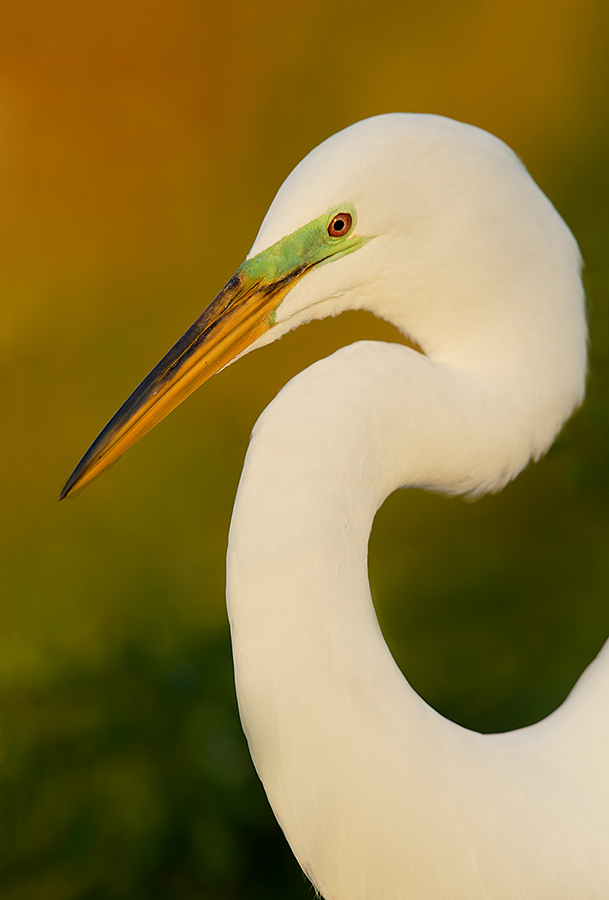
|
|
This Great Egret in breeding plumage image was created at Gatorland last Saturday with the Gitzo 3532 LS carbon fiber tripod, the Mongoose M3.6 head, the Canon EF 600mm f/4L IS II USM lens, the Canon 1.4x EF Extender III (Teleconverter), and the Canon EOS-1D X. ISO 400. Evaluative metering +1 stops as framed in early morning light: 1/320 sec. at f/5.6 in Manual mode. Color temperature: 6000K.
The three sensors that fell on the base of the bird’s bill as framed were chosen by 61-Point/AI Servo/Rear Focus AF and were of course active at the moment of exposure. Click here to see the latest version of the Rear Focus Tutorial. Click on the image to see a larger version.
Join me at Gatorland this Saturday morning for practically private instruction.
|
Gatorland In-the-Field Kudos
This via e-mail from Dana Campbell of Maryland who signed up virtually at the last second:
It was a wonderful day today! You taught me so much; I am still thinking about it all. I will now go back and read the archives, practice, and make some equipment changes/new purchases (Mongoose M3.6) soon. It was an honor and a pleasure to have met you and spent the day learning from you. You were so patient and generous sharing your knowledge and talent as well as a wonderfully nice and fun person! I hope to be able to join you again soon for an IPT. Thank you. Thank you. Thank you. Sincerely, Dana
Your Help is Still Needed
Please Help; Only 7 Folks Signed Yesterday: It takes less than a minute
Here is the short version: click here and sign the petition :).
Locations where fresh water abuts salt are often a mecca for birds. Many decades ago at many of the great east coast birding locations–Edwin B. Forsythe NWR (formerly Brigantine) in New Jersey, Bombay Hook in Delaware, and my beloved Jamaica Bay Wildlife Refuge (JBWR) in New York City, salt marsh was purposely destroyed to create fresh water impoundments in close proximity to salt water. Less notable sites like Wolfe’s Pond Park on Staten Island, NY are no less extraordinary.
At JBWR two such impoundments have existed since the early 1950s: the West Pond and one of my soul places, the East Pond. The late Max Larsen showed me my first breeding plumage Curlew Sandpiper on the West Pond well before I even thought about photographing birds. And it was there that I saw a juvenile Broad-billed Sandpiper, a mega rarity from Asia. Hurricane Sandy put the hurt on the West Pond in October 2012. The West Pond was breached and the former avian fresh water haven once again became part of Jamaica Bay which is of course completely saltwater.
Douglas Futuyma posted “Birder Action Needed to Restore Jamaica Bay WR West Pond” to the ABA (American Birding Association) blog:
New York’s famed Jamaica Bay Wildlife Refuge (JBWR) has been damaged beyond recognition. It will never again be such a wonderful resource for birds and birders unless it is repaired – and that may depend on the voice of birders (and bird photographers) everywhere.
You can read the whole thing here.
The West Pond, and The Birder’s Coalition for Gateway, needs your help. Please click here, sign the petition, and spread the word on Facebook, Twitter, and elsewhere. The petition route successfully stopped the shooting of Snowy Owls at various NYC airports. Your help here can help to get the West Pond restored to its former glory. Please take a moment to click and sign.
109
This post marks 109 straight days with a new educational blog post. With so many folks getting in the habit of using our B&H and Amazon links why quit now? To show your appreciation for my efforts here, we do ask that you use our B&H and Amazon affiliate links for all of your B&H and Amazon purchases. Please check the availability of all photographic accessories in the BIRDS AS ART Online Store. We sell only what I use and depend on. We will not sell you junk. We know what you need to make creating great images easy and fun. And we are always glad to answer your gear questions via e-mail.
This blog post took well more than 3 1/2 hours to prepare. Enjoy. And learn.
Huge Thanks!
Huge thanks to the many readers who continue to use the BAA B&H and Amazon Affiliate links for purchases large and small. March has gotten off to a great start with folks buying several Version II Super-teles, several 1D X bodies, and a 200-400. Way to go and greatly appreciated. It is wonderful to see so many folks being appreciative of the streak. Remember, every purchase helps no matter how small and getting in the habit of using the BAA links will not cost you one penny more.
|
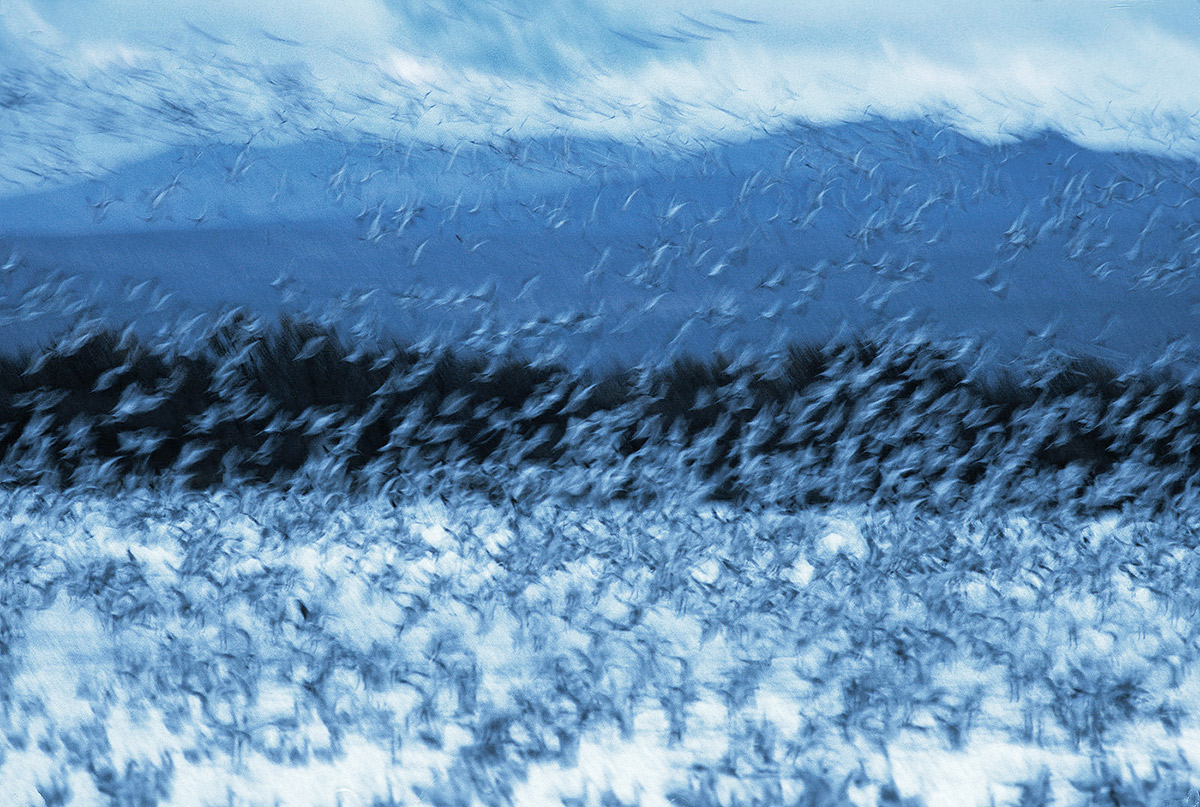
|
|
Blizzard in Blue/Snow Geese fly-out at Bosque del Apache NWR, NM. With the tripod-mounted Canon 400mm f/5.6L and the A2 body. Fuji Velvia pushed one stop to ISO 100. Evaluative metering +1/2 stop: 1/15 sec. at f/5.6.
This is the image that opened my eyes to creating pleasing blurs. Learn more in A Guide to Pleasing Blurs by Denise Ippolito and your truly. Click here to purchase either a traditional or canvas print of this iconic image for your home or office.
|
Meeting David Tipling
The image above was runner-up in Composition and Form in the 1998 BBC Wildlife Photographer of the Year Competition. It was my first of something like 8 or 9 honored images over the years in the prestigious WPOTY competitions. In those days, category winners and runners-up were invited to the awards ceremony and offered a ticket to London. As that was my first honored image, I gladly accepted.
At the time, David Tipling ran Windrush Photos, a stock agency that he had founded in the UK. He had a few thousand of my images in the collection. I am not sure how it came about but after the awards ceremony David took me on a photo tour of England, Scotland, and Wales. It was so cold in David’s flat that I slept in all of my cold weather stuff including all my clothes, a woolen watch cap, a hooded sweatshirt, and my heaviest parka. We drove for ten days in David’s Volvo and had a great time. The weather was great except when we went to Gingrin Farms to photograph Red Kite. It was so foggy both days that you could barely see your hand in front of your face….
|
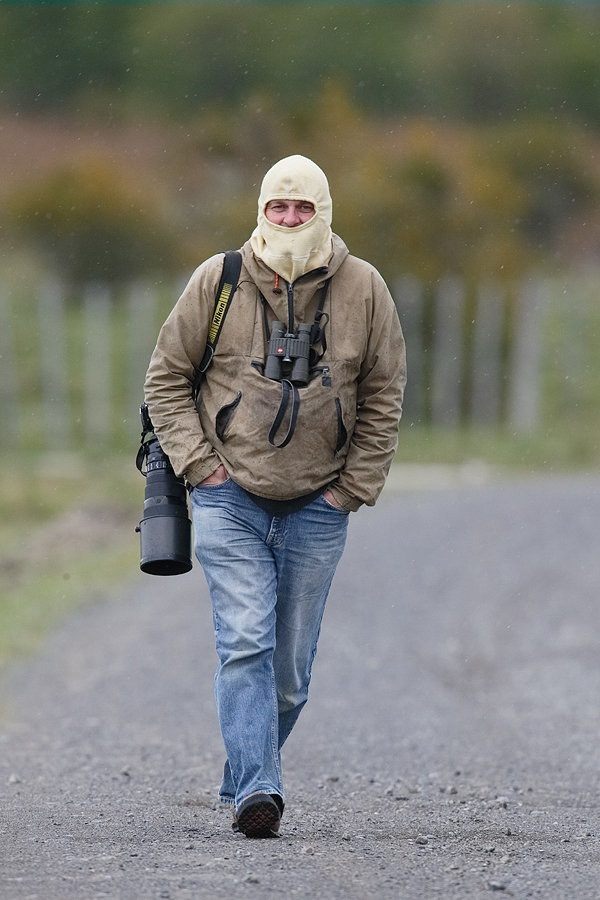
|
|
Here is David Tipling in Chilean Patagonia on the day we photographed the Chilean Swallows in the rain. You gotta love what you are doing. See my swallow images in the “With and Without: Teleconverter Versatility” blog post here.
|
Re-Connecting With an Old Friend
When Denise and I spoke at Avistar Patagonia last fall, I was thrilled to re-connect with David. Until I read the program notice, I had not realized that David’s bird photography career had really taken off. The three of us spent lots of time both during the event and during our extended stay. You can be as impressed as I was by clicking here to learn more about David.
|

|
|
Emperor Penguin and chick. Image courtesy of and copyright David Tipling Photography.
|
About David
It was a classroom encounter with a nuthatch at the age of 8 that sparked David’s interest in birds and wildlife generally. By fourteen he had picked up a camera for the first time and soon had the photography bug. But this vied for attention with a passion for fishing then latter with bird ringing (banding) that he eventually gave up to concentrate on photography. His earliest published picture was in the mid 1980s in the Kent Bird Report followed soon after by publication in British Birds Magazine, both in black and white. Today David is one of the most widely published wildlife photographers in the world. His pictures have been used on hundreds of book and magazine covers, regularly on TV, and in just about every other conceivable way from wine labels to being projected in New York’s Times Square.
David has enjoyed a long and close association with book publishing having been the author or commissioned photographer for more than 40 titles, working with Harper Collins, New Holland Publishers, Random House, Duncan Baird, Penguin, Dorling Kindersley and Mitchell Beazley to name a few. He has collaborated with some of the UK’s leading nature writers including Jonathan Elphick and Mark Cocker. It is with Mark that Birds & People the world’s largest survey of cultural attitudes to birds worldwide was published in the summer of 2013. This six year project has met with critical acclaim being voted the critic Craig Brown’s book of the Year in the Mail on Sunday. While John Burnside in the New Statesman described Birds & People as the book of the decade with “exquisite photography.”
To check out many of David’s renowned titles, you can click here
|
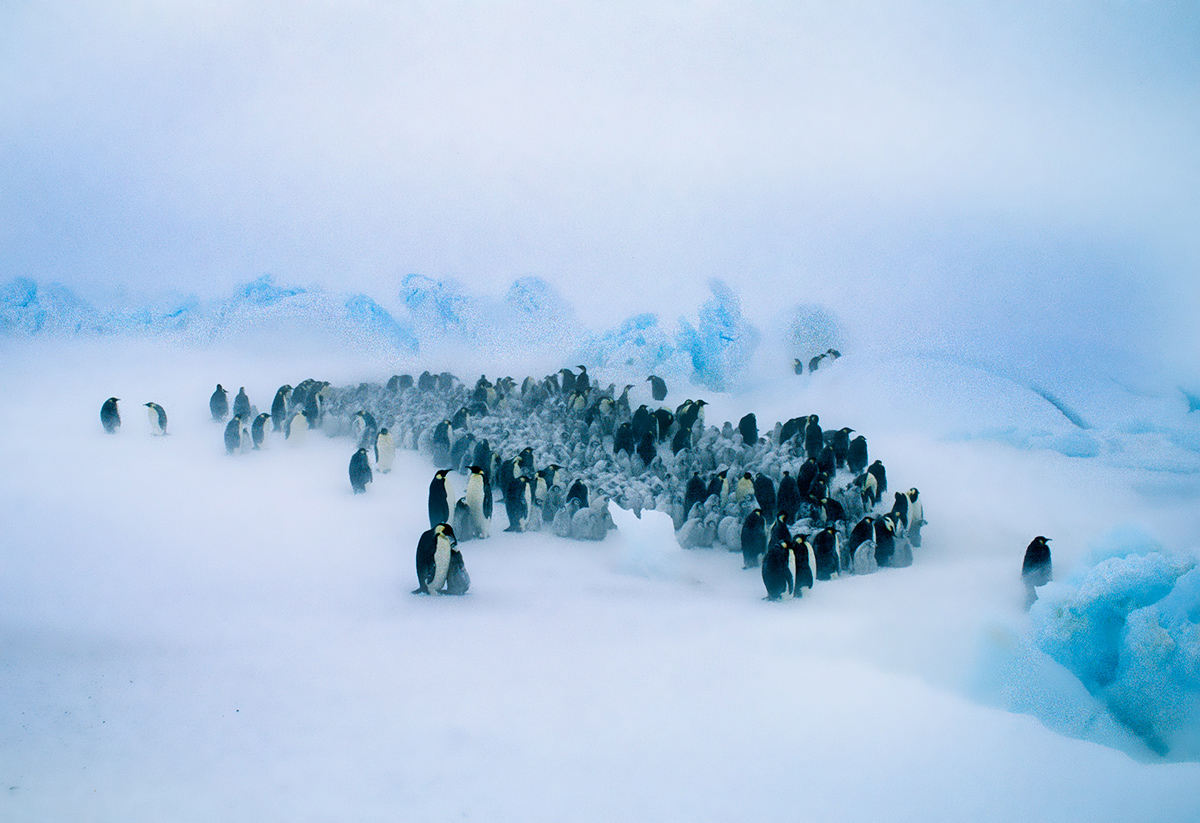
|
|
Emperor Penguin is blizzard. Image courtesy of and copyright David Tipling Photography.
|
David and the Emperors
Shortly after an epic expedition camping on sea ice next to an Emperor Penguin colony in Antarctica, Marie Claire Magazine named David one of the ten most adventurous outdoor photographers in the world. This same work on Emperor Penguins resulted in the European Nature Photographer of the Year Documentary Award. Other awards have included multiple wins in the BBC Wildlife Photographer of the Year and Nature’s Best where in 2009 David was awarded the Indigenous Cultures Award for his work on Mongolian Eagle Hunters.
David is a regular judge for photography competitions, notably British Birds Bird Photographer of the Year. He is photographic consultant for British Birds Magazine and writes a regular monthly column for East Anglia’s biggest selling paper the Eastern Daily Press in which he showcases local wildlife in pictures. He also writes a monthly column, Birds In Focus for WildPlanet Photography magazine.
When not traveling, taking pictures or writing books David relaxes by managing his 4 acre wood in the Norfolk Broads, spending time with his family and playing the didgeridoo.
|
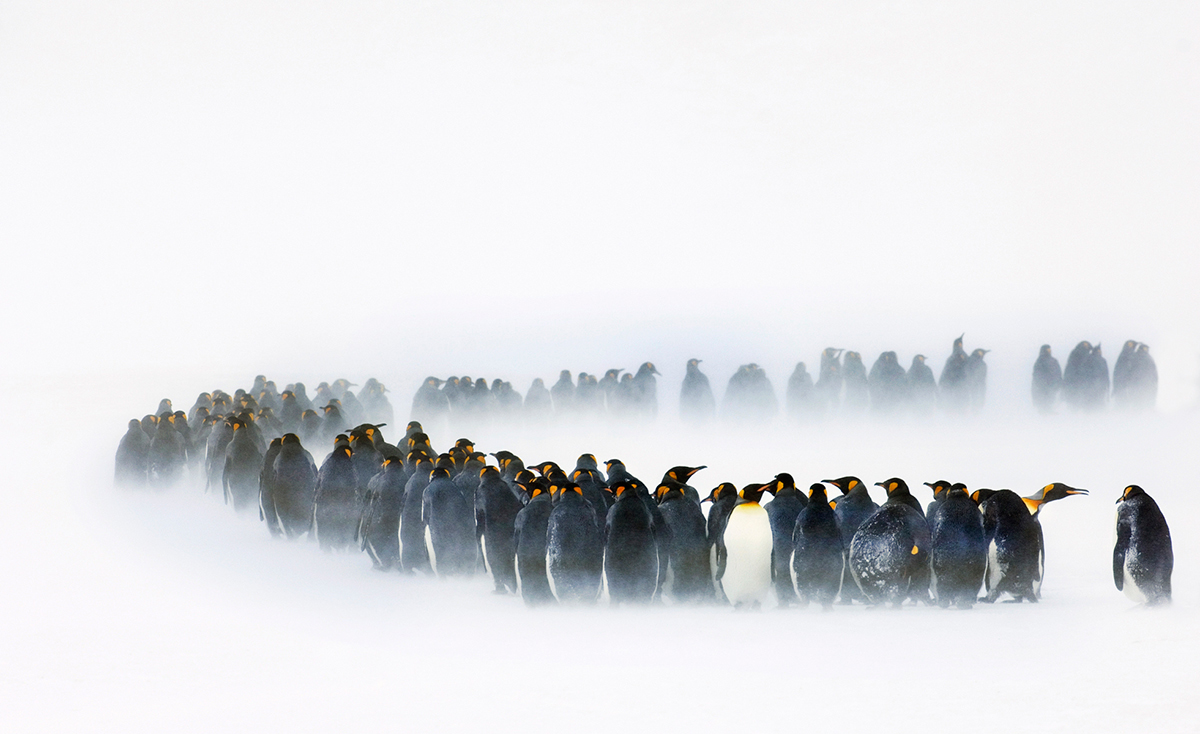
|
|
King Penguins in blowing snow. Image courtesy of and copyright David Tipling Photography.
|
My Comments
Even though you are seeing only a few of David’s images here, his skill as a photographer and his wonderful sense of composition and design are quite evident. If you spend some time surfing David’s stock galleries you will see that his world travels are likely more extensive than mine. And like me, he loves the Southern Ocean voyages.
|
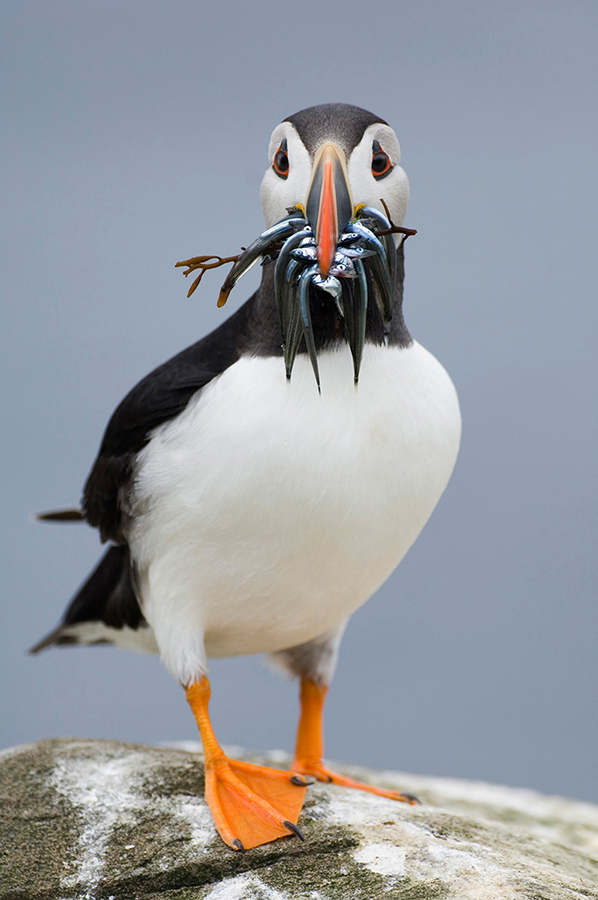
|
|
Atlantic Puffin with sand eels. Image courtesy of and copyright David Tipling Photography.
|
David and Our UK Puffins/Gannet Trip
David has been instrumental in helping Denise and me plan the soon-to-be announced UK Puffins and Gannets IPT. I am waiting to here back from the gannet boatmen and the van rental company…. Those who are interested in having their names placed on the interested list are invited to shoot me an e-mail.
The DPP RAW Conversion Guide
After seeing the accurate colors that I get from my DPP RAW conversions, Japan in Winter co-leader Paul McKenzie has switched to DPP conversions and Denise Ippolito is considering doing the same. Now that is amazing…. To learn why I use Canon’s Digital Photo Professional (DPP) to convert every image that I work on, click here.
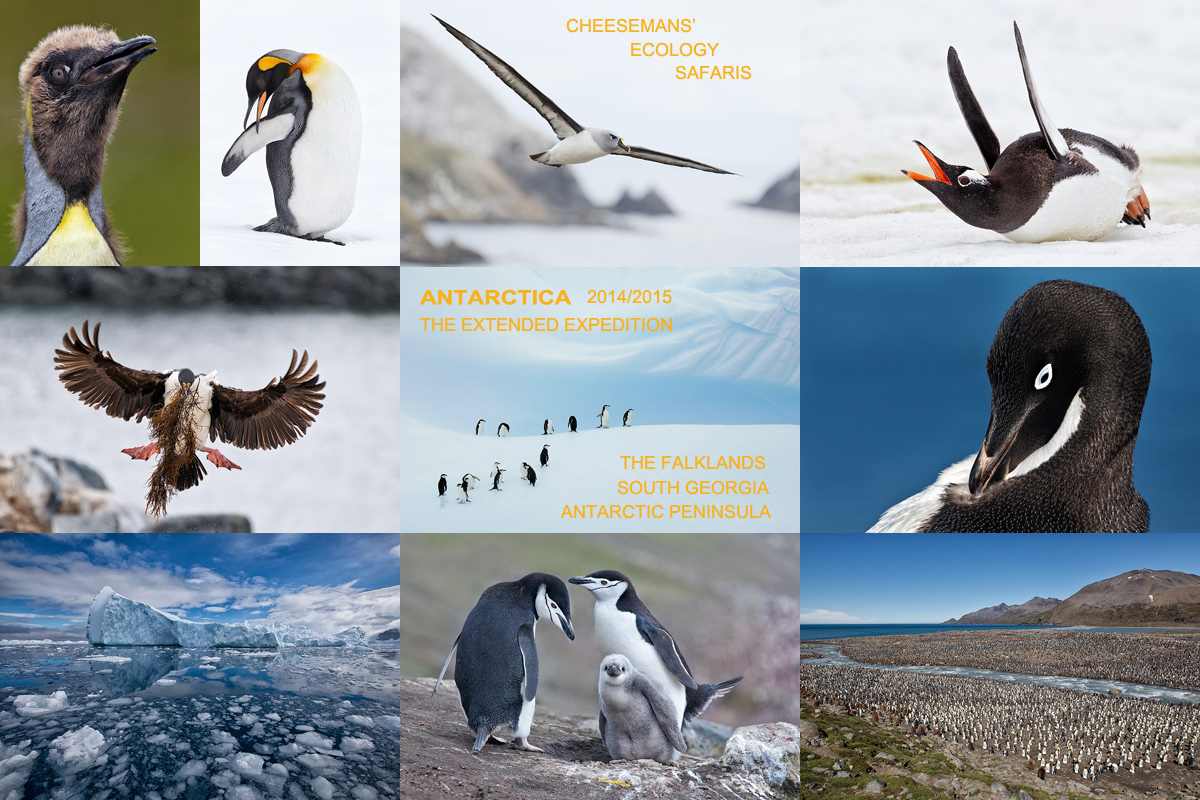
|
|
Breathe deeply, bite the bullet, and live life to its fullest; we all get only one ride on the merry-go-round… Join me on this great trip.
Click on the image to enjoy a larger version.
|
The Southern Ocean…
If you would like to explore the possibility of joining me on the Cheesemans’ Ecology Safaris Antarctica/The Extended Expedition Voyage: Antarctic Peninsula, South Georgia and Falkland Islands: December 13, 2014 to January 10, 2015, click here for additional information and then shoot me an e-mail.
Support the BAA Blog. Support the BAA Bulletins: Shop B&H here!
We want and need to keep providing you with the latest free information, photography and Photoshop lessons, and all manner of related information. Show your appreciation by making your purchases immediately after clicking on any of our B&H or Amazon Affiliate links in this blog post. Remember, B&H ain’t just photography!


 


Amazon
Everyone buys something from Amazon, be it a big lens or deodorant. Support the blog by starting your search by clicking on the logo-link below. No purchase is too small to be appreciated; they all add up. Why make it a habit? Because I make it a habit of bringing you new images and information on an almost daily basis.
Typos
In all blog posts and Bulletins, feel free to e-mail or to leave a comment regarding any typos, wrong words, misspellings, omissions, or grammatical errors. Just be right. 🙂
March 17th, 2014 Another Gatorland Short Notice Saturday Full-Day In-the-Field Workshop
Saturday March 22, 2014. 7:15am till 10:15am & 4:00pm till dusk. Lunch, image review, and Photoshop session included. Limit 6. A very small group is again likely: $399.
The cost of your Gatorland Photographer’s Pass is not included.
Gatorland is so good right now that I am going back this Saturday to try for tiny Great Egret chicks in the nest. Head portraits of this species in full breeding plumage are pretty much guaranteed even with an intermediate zoom lens. Nest building and flight likely. Here’s the story: there about two dozen photographers at Gatorland on Saturday past. Aside from one photographer from Slovakia and another, wearing a blue and white checked shirt, nobody had a clue as to how to make a good image…. Most folks just stand in one spot and point and shoot. Without regard for light angle or background. Join me on this, the 2nd Gatorland Short Notice Saturday Full-Day In-the-Field Workshop and you will learn to spot the good situations, to choose the best perspective, to see and understand the light, to get the right exposure every time after making a single test exposure, and to design pleasing images by mastering your camera’s AF system. A big part of the above is that you will learn how and why you must work in Manual mode 90% of the time at Gatorland. That is one of the things that Dana-see her e-mail below, and Chris Billman learned last Saturday.
At lunch we will review my images, take a look at five of your best images from the morning session (for those who opt to bring their laptops), and process a few of my images in Photoshop after converting them in DPP. That followed by Instructor Nap Time. Last Saturday all 3 folks had a great time and learned a ton. And the weather for this coming Saturday is looking good.
Payment in full via credit card is due upon registering. Please call Jim or Jennifer at 863-692-0906 to register. Ask for me if you have any questions.
|
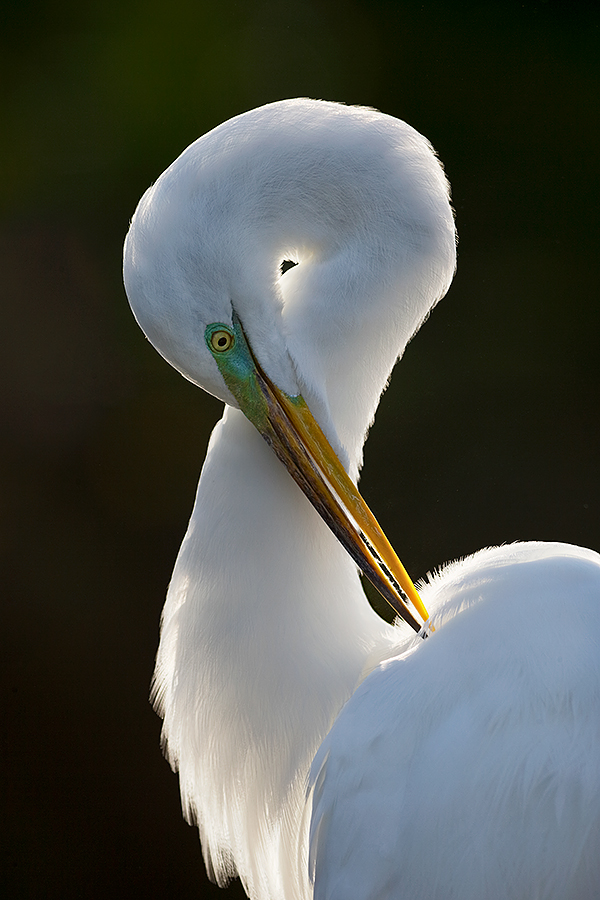
|
|
This backlit Great Egret was created last Saturday at Gatorland with the Canon EF 200-400mm f/4L IS USM Lens with Internal 1.4x Extender (hand held with the internal extender in place at 467mm) and the Canon EOS-1D X. ISO 400. Evaluative metering -1 2/3 stops as framed: 1/1000 sec. at f/7.1 in Manual mode. AWB.
Two sensors up from the central Sensor/AI Servo-Surround/Rear Focus AF on the bird’s neck active at the moment of exposure. Click here to see the latest version of the Rear Focus Tutorial. Click on the image to see a larger version.
|
Gatorland is Gatorland–Why Join Me?
I spotted the situation above from 50 yards away. It was being totally ignored by all of the other photographers. I called Dana over and she was thrilled. We went over the exposure–be sure to get just a very few blinkies on the rim lit highlights, and talking about moving up or down a bit to ensure the darkest background. Chris joined in a bit later. Most amazingly, nobody else was in the least bit curious as to what we were doing….
Join me next Saturday at Gatorland to see what you have been missing and to get your eyes opened!
Thanks to Denise Ippolito for helping me to fine-tune this image. There will be lots more on this photo here soon.
Image Question
Why did I need -1 2/3 stops for this image?
Gatorland In-the-Field Kudos
This yesterday via e-mail from Dana Campbell of Maryland who signed up virtually at the last second:
It was a wonderful day today! You taught me so much; I am still thinking about it all. I will now go back and read the archives, practice, and make some equipment changes/new purchases (Mongoose M3.6) soon. It was an honor and a pleasure to have met you and spent the day learning from you. You were so patient and generous sharing your knowledge and talent as well as a wonderfully nice and fun person! I hope to be able to join you again soon for an IPT. Thank you. Thank you. Thank you. Sincerely, Dana
Your Help is Needed
Locations where fresh water abuts salt are often a mecca for birds. Many decades ago at many of the great east coast birding locations–Edwin B. Forsythe NWR (formerly Brigantine) in New Jersey, Bombay Hook in Delaware, and my beloved Jamaica Bay Wildlife Refuge (JBWR) in New York City, salt marsh was purposely destroyed to create fresh water impoundments in close proximity to salt water. Less notable sites like Wolfe’s Pond Park on Staten Island, NY are no less extraordinary.
At JBWR two such impoundments have existed since the early 1950s: the West Pond and one of my soul places, the East Pond. The late Max Larson showed me my first breeding plumage Curlew Sandpiper on the West Pond well before I even thought about photographing birds. And it was there that I saw a juvenile Broad-billed Sandpiper, a mega rarity from Asia. Hurricane Sandy put the hurt on the West Pond in October 2012. The West Pond was breeched and the former avian fresh water haven once again became part of Jamaica Bay which is of course completely saltwater.
Douglas Futuyma posted “Birder Action Needed to Restore Jamaica Bay WR West Pond” to the ABA (American Birding Association) blog:
New York’s famed Jamaica Bay Wildlife Refuge (JBWR) has been damaged beyond recognition. It will never again be such a wonderful resource for birds and birders unless it is repaired – and that may depend on the voice of birders (and bird photographers) everywhere.
Whether by personal experience or by its reputation, birders throughout North America and beyond know the refuge. Some came from far and wide to see the Broad-billed Sandpiper, the first in the lower 48 states, in 1998; others came there to see their first Spotted Redshank, Fulvous Whistling-Duck, Sage Thrasher, White-faced Ibis, Reddish Egret, or King Eider; countless birders have enjoyed the diverse winter waterfowl, seasonal shorebirds, and summer herons and terns that a walk around the West Pond. More than 330 species of birds have been seen in the Refuge, owing to the unusual proximity of a freshwater Pond to a saltwater bay, together with saltmarsh, tidal flats and groves of trees. Five federally Endangered or Threatened species, 8 of 10 New York State Endangered species, and all 19 New York Species of Special Concern have occurred on the West Pond. Some of these have bred almost annually, and many other species use the refuge for resting and refueling during migration. BirdLife International and the National Audubon Society have designated Jamaica Bay an official Important Bird Area (IBA)
You can read the whole thing here.
The West Pond, and The Birder’s Coalition for Gateway, needs your help. Please click here, sign the petition, and spread the word on Facebook, Twitter, and elsewhere. The petition route successfully stopped the shooting of Snowy Owls at various NYC airports. Your help here can help to get the West Pond restored to its former glory. Please take a moment to click and sign.
108
This post marks 108 straight days with a new educational blog post. With so many folks getting in the habit of using our B&H and Amazon links why quit now? To show your appreciation for my efforts here, we do ask that you use our B&H and Amazon affiliate links for all of your B&H and Amazon purchases. Please check the availability of all photographic accessories in the BIRDS AS ART Online Store. We sell only what I use and depend on. We will not sell you junk. We know what you need to make creating great images easy and fun. And we are always glad to answer your gear questions via e-mail.
This blog post took well more than 3 hours to prepare. Enjoy. And learn.
Huge Thanks!
Huge thanks to the many readers who continue to use the BAA B&H and Amazon Affiliate links for purchases large and small. March has gotten off to a great start with folks buying several Version II Super-teles, several 1D X bodies, and a 200-400. Way to go and greatly appreciated. It is wonderful to see so many folks being appreciative of the streak. Remember, every purchase helps no matter how small and getting in the habit of using the BAA links will not cost you one penny more.
|
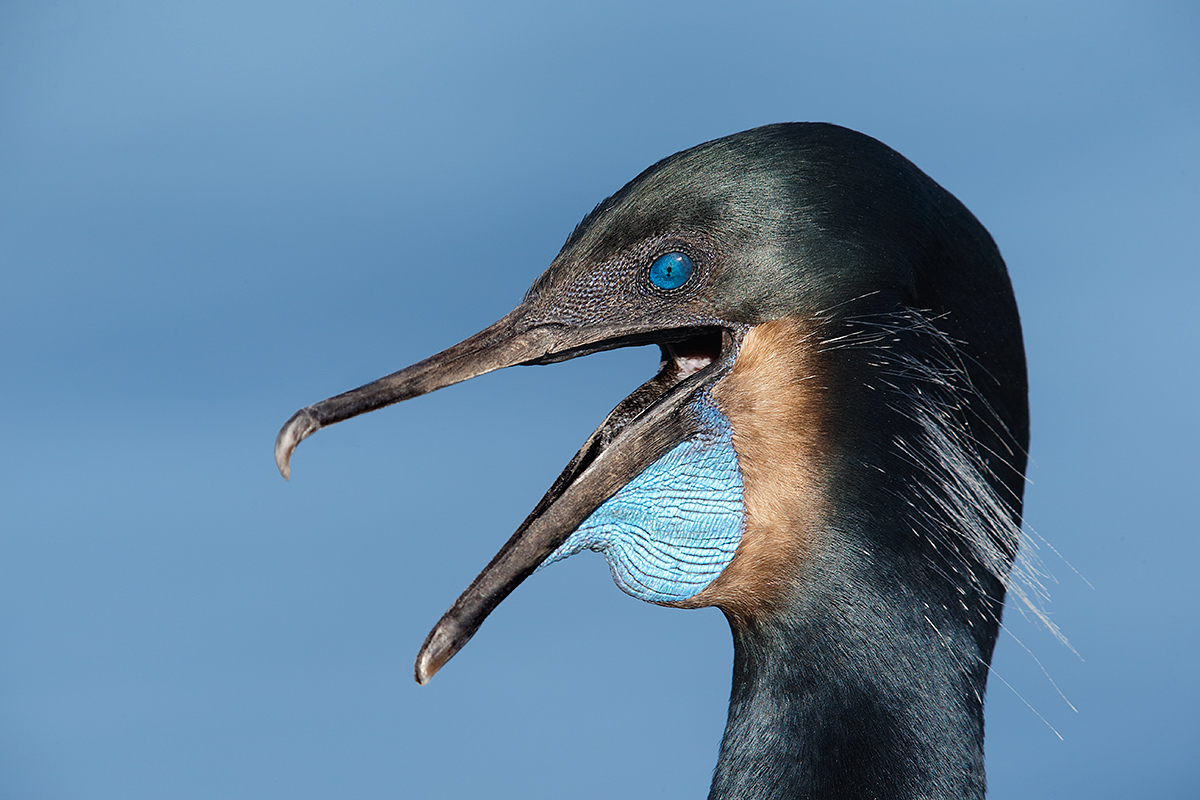
|
|
This image of a breeding plumage Brandt’s Cormorant was created at 8:59am/January 16, 2014 on the San Diego Short Notice IPT with the Gitzo 3532 LS carbon fiber tripod, the Mongoose M3.6 head, the Canon EF 600mm f/4L IS II USM lens, the Canon 2x EF Extender III (Teleconverter), and the Canon EOS-1D X Digital SLR camera. ISO 400. Evaluative metering +1/3 stop as framed: 1/400 sec. at f/11 in Manual mode. Color Temperature: AWB.
We were quite lucky on this IPT as many individuals of both species of cormorants, Double-crested and Brandt’s, were sporting all their breeding colors and dress. They were about 2-3 weeks ahead of their usual schedule.
Central sensor (by necessity) Expand/AI Servo/Rear Focus just caught the top of the proximal third of the lower mandible. Click here if you missed the Rear Focus Tutorial. Be absolutely sure to click on the image to see a larger version.
|
What’s So Funny?
When I see images like this on my laptop, I often wonder whether the bird was yakking, yawning, or gular panting. Or perhaps it was laughing….
The gular skin or pouch is the blue skin that we see in the image above. I believe that the tan feathers to the right of the gular skin may be part of the gular region. Doug Wechsler, feel free to chime in here. Digested bits of food to be fed to small chicks may be held in the gular pouch. We frequently notice the gular region when a variety of birds, most especially cormorants, are engaged in gular flutter to help keep them cool.
I had always called this behavior “gular panting” but while doing the research for this post I learned that the correct term is “gular fluttering.”
From “Patterns of Panting and Gular Flutter in Cormorants, Pelicans, Owls, and Dvoes” (Bartholomew, Lasiewski, & Crawford) here:
Most birds pant when subjected to heat stress, but some supplement evaporation from the respiratory tract by fluttering the gular area. Gular flutter occurs in at least the following taxa: cormorants, pelicans, boobies, anhingas, frigate-birds, herons, owls, doves, , roadrunners, colies, and many gallinaceous species.
They go on to note that in Double-crested Cormorant, a species closely related to the Brandt’s Cormorant depicted in the image here, that the rate of gular flutter varies from 645 to 730 per minute and was relatively constant over a wide range of ambient temperatures, body temperatures, and breathing rates.
Exposure Question
What is the primary exposure danger when creating an image like this.
Image Optimization and Bill Cleanup
Image optimization here was relatively straight-forward. After converting the image in DPP I dust-spotted the image, selected the bird’s head, face, and bill, and ran a layer of my favorite NIK 50/50 custom preset (50% Tonal Contrast & 50% Detail Extractor) and painted that out on the tan feathers using a Regular Layer Mask. Notice the difference in the detail on the face in the animated GIF above. With all the fluffy stuff on the bill, especially near the tip, bill cleanup took about 10 minutes as I need to work large and carefully. I used all of my usual cleanup tools: the Spot Healing Brush, the Clone Stamp Tool at various opacities, and the Patch Tool. I darkened the bill a bit using Selective Color on a layer after selecting the bill using the Quick Selection Tool. The bit of Eye Doctor work that I did is also evident in the animated GIF.
Digital Basics
Everything mentioned above and tons more are detailed in my Digital Basics File. Are you tired of making your images look worse in Photoshop? Do you have no clue as to what I was talking about above? Digital Basics is an instructional PDF that is sent via e-mail. It includes my complete digital workflow, dozens of great Photoshop tips, the use of Contrast Masks, several different ways of expanding canvas, all of my time-saving Keyboard Shortcuts, Quick Masking, Layer Masking, and NIK Color Efex Pro basics, my killer image clean-up techniques, Digital Eye Doctor, creating time-saving actions, and lots more.
The DPP RAW Conversion Guide
After seeing the accurate colors that I get from my DPP RAW conversions, Japan in Winter co-leader Paul McKenzie has switched to DPP conversions and Denise Ippolito is considering doing the same. Now that is amazing…. To learn why I use Canon’s Digital Photo Professional (DPP) to convert every image that I work on, click here.
Support the BAA Blog. Support the BAA Bulletins: Shop B&H here!
We want and need to keep providing you with the latest free information, photography and Photoshop lessons, and all manner of related information. Show your appreciation by making your purchases immediately after clicking on any of our B&H or Amazon Affiliate links in this blog post. Remember, B&H ain’t just photography!


 


Amazon
Everyone buys something from Amazon, be it a big lens or deodorant. Support the blog by starting your search by clicking on the logo-link below. No purchase is too small to be appreciated; they all add up. Why make it a habit? Because I make it a habit of bringing you new images and information on an almost daily basis.
Typos
In all blog posts and Bulletins, feel free to e-mail or to leave a comment regarding any typos, wrong words, misspellings, omissions, or grammatical errors. Just be right. 🙂
March 16th, 2014 Amazon Stuff 🙂
Many folks have written stating that they are confused about using our Amazon link to support my efforts here on the blog. Part of the problem is that some browsers do not show the logo links. As far as I know, all of the browsers show the logo links on the right side of each blog page. To help us out, simply click on the long skinny Amazon link that appears in the right-hand column of each blog page. Then begin your search. As long as you make all of your purchases in a single session, all will be successfully tracked to BAA. And all with be greatly appreciated.
Folks in Canada can use this link: Amazon Canada to start their searches. You can simplify things by saving the page as a favorite and then opening it each time that you shop.
Simplicity, Undoing the BLUEs, and More…
After 6 straight days with more than 2500 page views, yesterday’s post, Simplicity, Undoing the BLUEs, and More…, garnered only 2171 such views. It was a great post; if you missed it, or if you ever photograph snow on a cloudy day, you can see it “Simplicity, Undoing the BLUEs, and More…” here.
107
This post marks 107 straight days with a new educational blog post. With so many folks getting in the habit of using our B&H and Amazon links why quit now? To show your appreciation for my efforts here, we do ask that you use our B&H and Amazon affiliate links for all of your B&H and Amazon purchases. Please check the availability of all photographic accessories in the BIRDS AS ART Online Store. We sell only what I use and depend on. We will not sell you junk. We know what you need to make creating great images easy and fun. And we are always glad to answer your gear questions via e-mail.
You can find the following items in the store: Gitzo tripods, Mongoose M3.6 and Wimberley heads, plates, low feet, and accessories, flash brackets, , Delkin e-film Pro Compact Flash Cards, LensCoat products, and our unique line-up of educational materials including ABP I & II, Digital Basics, Site and Set-up e-Guides, Canon and Nikon Camera Users and AF e-Guides, and MP-4 Photoshop video tutorials among others.
Note: though we almost never have Mongoose M3.6 heads in stock we do have a few on the shelf right now. We are still waiting for more CR-X5 plates. As always, the best way to ensure getting one of these great heads for your intermediate or super-telephoto lens (if they are out of stock) or one of the great CR-X5 plates is to call Jim and place your order. You are then ensured of getting one from our next shipment. We will not of course bill your credit card until the item ships or drop-ships.
We would of course appreciate you using our B&H and Amazon affiliate links for all of your B&H and Amazon major gear, video, electronic, household, and personal purchases. For the photographic stuff mentioned in the paragraph above we would of course greatly appreciate your business. Here is a huge thank you to the many who have been using our links on a regular basis and visiting the BAA Online store as well.
This blog post took more than 4 hours to prepare. Enjoy. And learn.
Huge Thanks!
Huge thanks to the many readers who continue to use the BAA B&H and Amazon Affiliate links for purchases large and small. March has gotten off to a great start with folks buying several Version II Super-teles, several 1D X bodies, and a 200-400. Way to go and greatly appreciated. It is wonderful to see so many folks being appreciative of the streak. Remember, every purchase helps no matter how small and getting in the habit of using the BAA links will not cost you one penny more.
|

|
|
This image was created yesterday morning at Gatorland with the Canon EF 200-400mm f/4L IS USM Lens with Internal 1.4x Extender (hand held with the internal extender in place at 560mm) and the Canon EOS-1D X. ISO 400. Evaluative metering -1/3 stop framed: 1/1200 sec. at f/6.8 in Manual mode. AWB.
Two sensors to the left and two sensors above the central Sensor/AI Servo-Surround/Rear Focus AF squarely on the green lores as framed active at the moment of exposure. Click here to see the latest version of the Rear Focus Tutorial. Click on the image to see a larger version.
Image #1: Morning Light
|
Step Stool Flower Elimination…
There were lots of tame gorgeous Great Egrets in full breeding plumage yesterday for the Short Notice In-the-Field Workshop at Gatorland. Once I had the image above lined up, I noted an ugly out-of-focus white flower in the background just above the bird’s head. So I scrambled back to the gazebo, grabbed my sturdy milk crate, and created the image above. Note that since I was hand holding it was mandatory to have AF active at the moment of exposure to prevent throwing off the focus due to my moving ever so slightly.
Beating the Dead Horse
Notice the exposure compensations in the first two images. In image one with the sun out at 8:30am the meter was pretty smart. With the subject in the shade for the second image I needed to add a good amount of light to come up with a histogram that showed data 1/2 way into the rightmost box…. I repeat, with the sun out at full strength evaluative or matrix metering will be pretty smart. In shade, with cloudy or overcast conditions, and early or late on clear days, it is much dumber; the lighter the overall tonality of the image the dumber it gets. The other day we saw that a snowy hillside in pre-dawn light needed almot +4 stops EC…..
Note: Nikon folks would have needed at least -2/3 stop for Image #1 in order to avoid significant blinkies.
What Do You Think?
Feel free to critique one or more of today’s images. Let us know what you like and what you don’t like. Let us know how you think an image might have been improved. Honest critiques done gently as we do on BirdPhotographer’s.Net are preferred.
Please also let us know your favorite image of the 3.
One of My Very Favorite Situations
Subject in shade, background in sun. I just love that situation. Here the background was made up of distant, dead palm fronds across the gator moat. You will need to add varying amounts of light to come up with the correct exposure in these situations should you be lucky enough to encounter them. As always, aim to get at least some data 1/2 way into the rightmost histogram box, the fifth box on Canon cameras, the fourth box on Nikon bodies.
|
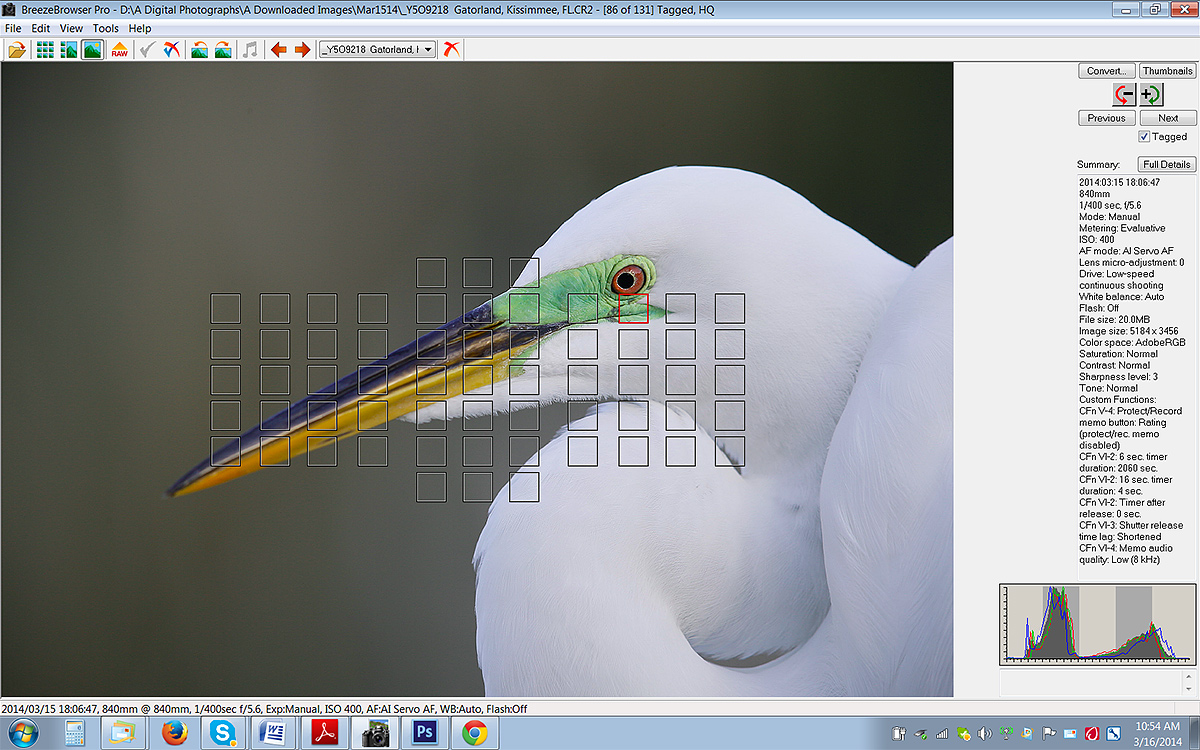
|
|
This is the BreezeBrowser Main View screen capture.
|
BreezeBrowser Main View Screen Capture
Above is the BreezeBrowser Main View screen capture for Image #2. Note that the illuminated red square just below the bird’s eye depicts the AF sensor that was active at the moment of exposure. Note: in Breezebrowser you need to check “Show Focus Points” under View to activate this feature. To see the focus points in DPP check “AF Point” under View or hit Alt L. Hit Alt M to see Highlight Alert. To learn how and why I use DPP (Canon Digital Photo Professional) to convert my RAW files, see the info on our DPP RAW Conversion Guide here.
Note the histogram with data well into the fifth box. Note that I like to bring my WHITEs into Photoshop with RGB values no greater than 130 or 235.
Whether hand holding (Image #1) or working on a tripod (Images #2 & 3) I have been making more of an effort recently to choose a sensor on or near the subject’s eye to ensure razor sharpness on the face and eye.
Regular readers know that I use and depend on BreezeBrowser every day of the year. It allows me to sort my keepers and delete the rejects faster than any other Windows browsing program. We use it on the main computer in the home office to catalog our images file-drawer style. And the companion program, Downloader Pro allows me to download my images quickly and conveniently. It automatically adds my IPTC data and the shooting location. I have it set up to create a folder named by the Month/date/year. The Breezebrowser/Downloader Pro combo saves me many hours each week. To learn more or to purchase this great PC only program, click here. As far as the BreezeBrowser/Downloader Pro Combo goes, if you are using a Windows platform and are not using these two great programs you are at best, wasting your valuable time. My understanding is that Photo Mechanic is best for Mac-users who do not opt to run Parallels or VM Ware fusion on their Macs so that they can enjoy the many advantages of BreezeBrowser. See BreezeBrowswer on a Mac for details.
Support the BAA Blog. Support the BAA Bulletins: Shop B&H here!
We want and need to keep providing you with the latest free information, photography and Photoshop lessons, and all manner of related information. Show your appreciation by making your purchases immediately after clicking on any of our B&H or Amazon Affiliate links in this blog post. Remember, B&H ain’t just photography!




 


Amazon
Everyone buys something from Amazon, be it a big lens or deodorant. Support the blog by starting your search by clicking on the logo-link below. No purchase is too small to be appreciated; they all add up. Why make it a habit? Because I make it a habit of bringing you new images and information on an almost daily basis.
Typos
In all blog posts and Bulletins, feel free to e-mail or to leave a comment regarding any typos, wrong words, misspellings, omissions, or grammatical errors. Just be right. 🙂
March 15th, 2014 106
This post marks 106 straight days with a new educational blog post. With so many folks getting in the habit of using our B&H and Amazon links why quit now? To show your appreciation for my efforts here, we do ask that you use our B&H and Amazon affiliate links for all of your B&H and Amazon purchases. Please check the availability of all photographic accessories in the BIRDS AS ART Online Store. We sell only what I use and depend on. We will not sell you junk. We know what you need to make creating great images easy and fun. And we are always glad to answer your gear questions via e-mail.
You can find the following items in the store: Gitzo tripods, Mongoose M3.6 and Wimberley heads, plates, low feet, and accessories, flash brackets, , Delkin e-film Pro Compact Flash Cards, LensCoat products, and our unique line-up of educational materials including ABP I & II, Digital Basics, Site and Set-up e-Guides, Canon and Nikon Camera Users and AF e-Guides, and MP-4 Photoshop video tutorials among others.
Note: though we almost never have Mongoose M3.6 heads in stock we do have a few on the shelf right now. We are still waiting for more CR-X5 plates. As always, the best way to ensure getting one of these great heads for your intermediate or super-telephoto lens (if they are out of stock) or one of the great CR-X5 plates is to call Jim and place your order. You are then ensured of getting one from our next shipment. We will not of course bill your credit card until the item ships or drop-ships.
We would of course appreciate you using our B&H and Amazon affiliate links for all of your B&H and Amazon major gear, video, electronic, household, and personal purchases. For the photographic stuff mentioned in the paragraph above we would of course greatly appreciate your business. Here is a huge thank you to the many who have been using our links on a regular basis and visiting the BAA Online store as well.
This blog post took about 3 hours to prepare. Enjoy. And learn.
Huge Thanks!
Huge thanks to the many readers who continue to use the BAA B&H and Amazon Affiliate links for purchases large and small. March has gotten off to a great start with folks buying several Version II Super-teles, several 1D X bodies, and a 200-400. Way to go and greatly appreciated. It is wonderful to see so many folks being appreciative of the streak. Remember, every purchase helps no matter how small and getting in the habit of using the BAA links will not cost you one penny more.
Simplicity
As we saw with the image of the two bamboo leaves in the “Special Hokkaido Treats” blog post here, simple image designs can be both powerful and artistic. Both images here illustrate that concept very nicely. I had had my eye on those little snow hills for a while and planned to do them at the end of our second uphill walk to the Monkey Park. But I had forgotten the tripod collar for my 70-200. Pat Lillich kindly loaned me whole her rig. I put it on my tripod and went to work. I created about 20 images and wound up keeping only this one, the first in the series. It is amazing how often our initial vision yields the most pleasing image design….
Image Question
Why f/20?
Why did I use a tripod for this image?
Undoing the BLUEs
After giving the Animated GIF above a few seconds to play, it is easy to see that the original image had a tremendous BLUE cast. AWB was a big mistake, but one that was easily dealt with during the image optimization process. Most of the work was done with a simple mouse click during the RAW conversion in DPP. I simply went to Click White Balance. That brought all the RGB values to within a point or two of each other. I also lightened the image nearly 2 stops; see my thoughts on getting the right exposure with snow below.
When I brought the image into Photoshop the RGB #s still looked pretty good but the image, especially the shadows, still looked BLUE. So I duplicated the entire image (Control A, Control J) and opened Hue/Saturation on that layer (Control U). I chose the BLUE channel from the dropdown menu and moved the Saturation slider to the right. The BLUE cast was obvious so I moved the Saturation slider all the way to the left to totally desaturate the BLUEs. Now the RGB values for the brightest WHITEs read 231, 231, 231. The WHITEs were now perfectly WHITE. And bright.
As I had lightened the image 1.7 stops during the DPP conversion all that was left to do was add a layer of my NIK custom 50/50 (Tonal Contrast/Detail Extractor) at 50% Opacity. Thanks again to Pat Lillich who made this image possible.
|
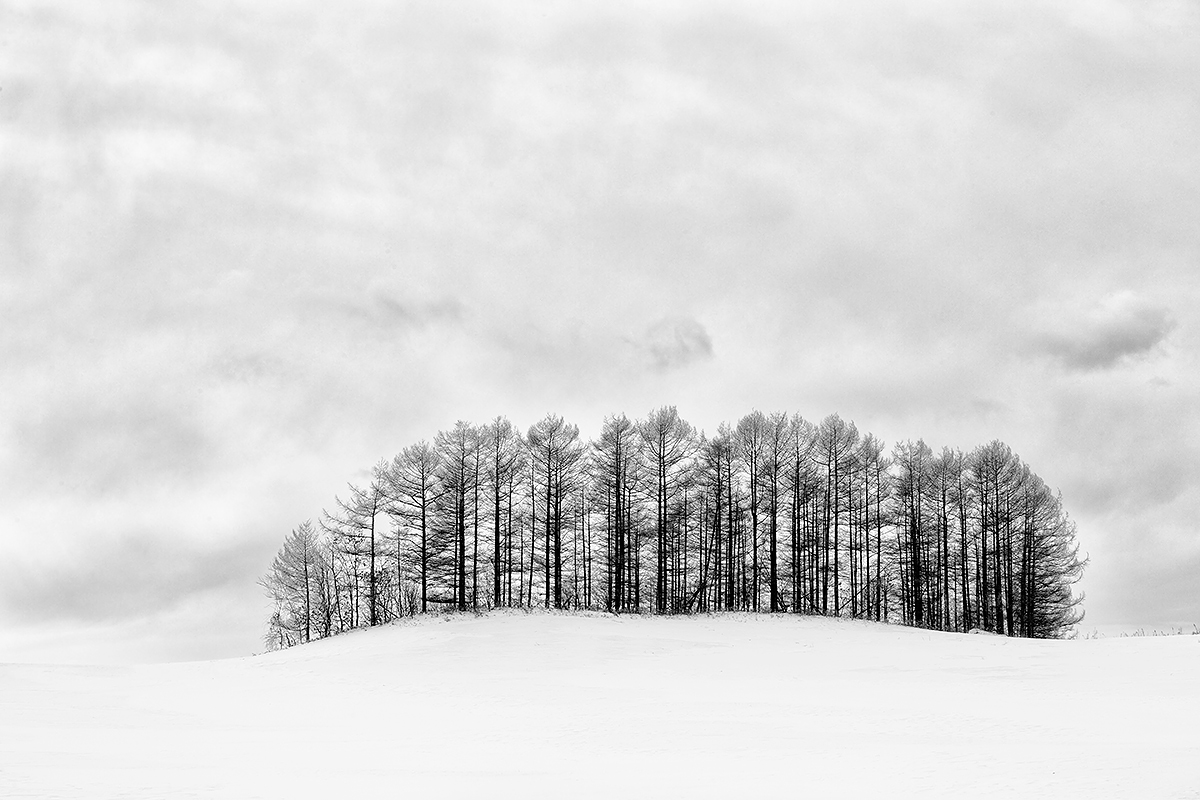
|
|
This image was created on Hokkaido on the Japan in Winter IPT with the Gitzo 3532 LS carbon fiber tripod, the Mongoose M3.6 head, the Canon EF 70-200mm f/2.8L IS II USM lens, (tripod-mounted at 70mm) and the and the Canon EOS 5D Mark III . ISO 400. Evaluative metering +1 2/3 stops as framed: 1/400 sec. at f/16 in Av mode was somewhat of an underexposure. (See the Original below.)
Central sensor/Rear Focus AI Servo AF on the trees and re-compose. Click here to see the latest version of the Rear Focus Tutorial. Click on the image to see a larger version.
Image #2: Tree Stand on Snowy Ridge
|
Tree Stand on Snowy Ridge
As you can see by looking at the original image immediately below, the success of this image is largely due to the superb image optimization. It took me quite a while to get something that looked better than decent…. See the details below. The original was about a stop underexposed and was totally flat; there was not much color and pretty much no contrast.
But again, the simple compositional approach worked very well.
|
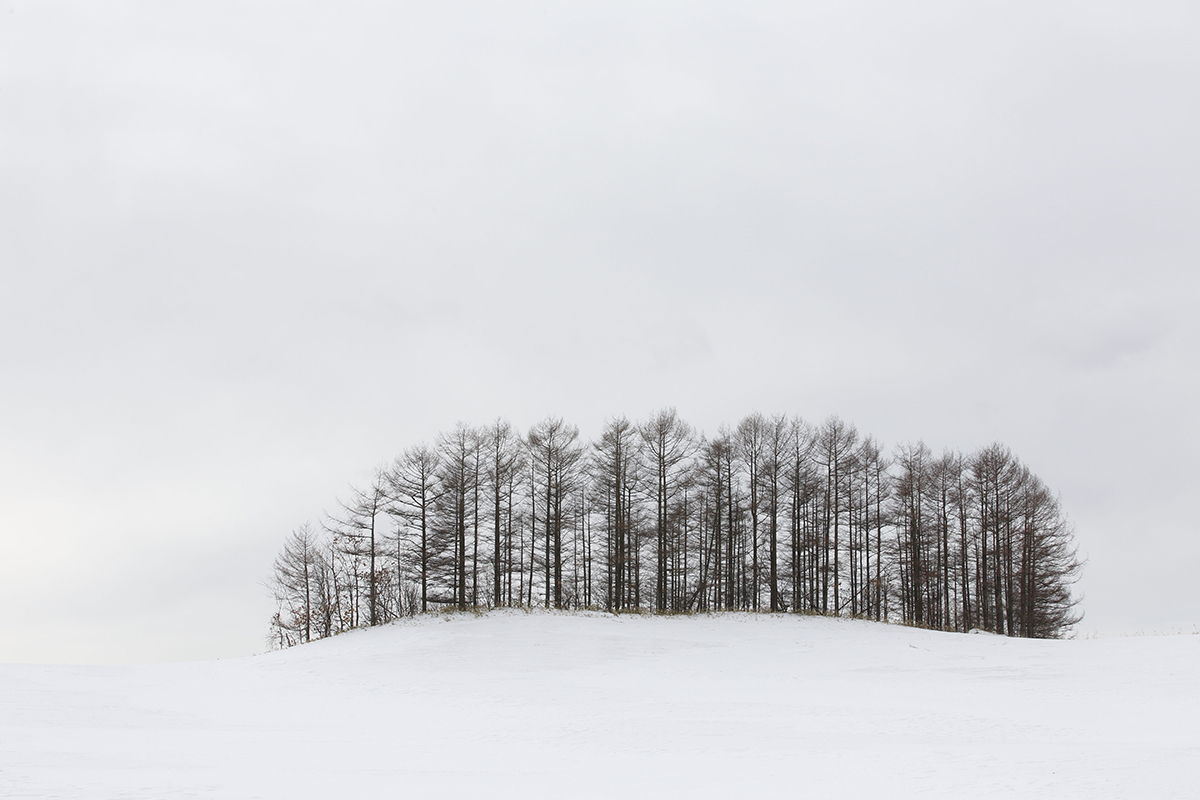
|
|
your text and adds
|
The Image Optimization Process
After lightening the image during DPP conversion I opened the image in Photoshop. As it was obvious I should go Black and White with this image I brought it into NIK Silver Efex Pro and went with High Contrast Green. Then I ran a layer of NIK Color EFEX Pro Detail Extractor, added a Regular Layer Mask, and erased the snow on the hill as I wanted to keep that white and without detail. That was followed by a layer of NIK Viveza with Structure increased to the max to bring up the detail in the clouds. Again I added a Regular Layer Mask; this time I erased the effect on the trees and the foreground hill. By now there was tons of detail in the clouds but they were looking a bit grainy so I went with Filter/Blur/Surface Blur on a layer at about 6/12, added another Regular Layer Mask, and again erased the trees and the foreground snow. Voila!
Getting the Right Exposure with Snow Scenes on Cloudy Days
Both images here were created with an EC of +1 2/3 stops. Both were underexposed. As it turned out the opening image needed nearly four stops of over-exposure. The trees image needed nearly three stops of over-exposure. In each case, I did not push the exposure far enough to the right. With the scenes being overall light-toned there were no dire effects as a result of lightening the images during conversion. But it is always better to get things right in-camera. We had several situations where the best exposure was +4 stops off the snow. Live and learn.
Note: had the sun been out the EC would have likely been +1/3 or +2/3 with Canon, 0 or -1/3 with Nikon. Why? Because the meters are a lot smarter when the sun is out at full strength than they are in cloudy, overcast, pre-dawn light or when the subject is in the shade.
Your Favorite?
Take a moment to let us know which of these two you would hang on your wall. And please let us know why. BTW, all BAA images are available as signed prints, either traditional or canvas. Click here for more info.
IPT Info
Many of our great trips are filling up. With 5 Canadians and another couple signing up for our 4-DAY Bosque IPT; that workshop is filling up quickly. See especially info on the Holland, and Nickerson Beach IPTs. Two great leaders on most trips ensure that you will receive individual attention, have all of your questions answered, and learn a ton including how to think like a pro, see the situation, and get the right exposure every time. In addition you will have fun, and make lots of great images. Click here for IPT details and general information.
|

|
|
Images copyright 2012: Denise Ippolito & Arthur Morris. Card design by Denise Ippolito. Click on the image to enjoy a spectacular larger version.
|
Holland 2014 7 1/2-Day/8-Night: A Creative Adventure/BIRDS AS ART/Tulips & A Touch of Holland IPT. April 17-April 24, 2014: $4995 Limit: 12/Openings: 5
We still have room for 5 more flower photographers on this great trip.
Join Denise Ippolito, Flower Queen and the author of “Bloomin’ Ideas,” and Arthur Morris, Canon Explorer of Light Emeritus and one of the planet’s premier photographic educators for a great trip to Holland in mid-April 2014. Day 1 of the IPT will be April 17, 2014. We will have a short afternoon get-together and then our first photographic session at the justly-famed Keukenhof. Most days we will return to the hotel for lunch, image sharing and a break. On Day 8, April 24, we will enjoy both morning and afternoon photography sessions.
The primary subjects will be tulips and orchids at Keukenhof and the spectacularly amazing tulip, hyacinth, and daffodil bulb fields around Lisse. In addition we will spend one full day in Amsterdam. There will be optional visits the Van Gogh Museum in the morning and the Anne Frank House in the afternoon; there will be plenty of time for street photography as well. And some great food. On another day we will have a wonderful early dinner at Kinderdijk and then head out with our gear to photograph the windmills and possibly some birds for those who bring their longs lenses. We will spend an afternoon in the lovely Dutch town of Edam where we will do some street photography and enjoy a superb dinner. All lodging, ground transportation, entry fees, and meals (from dinner on Day 1 through dinner on Day 8) are included. For those who will be bringing a big lens we will likely have an optional bird photography afternoon or two.
Click here for additional info or to register.
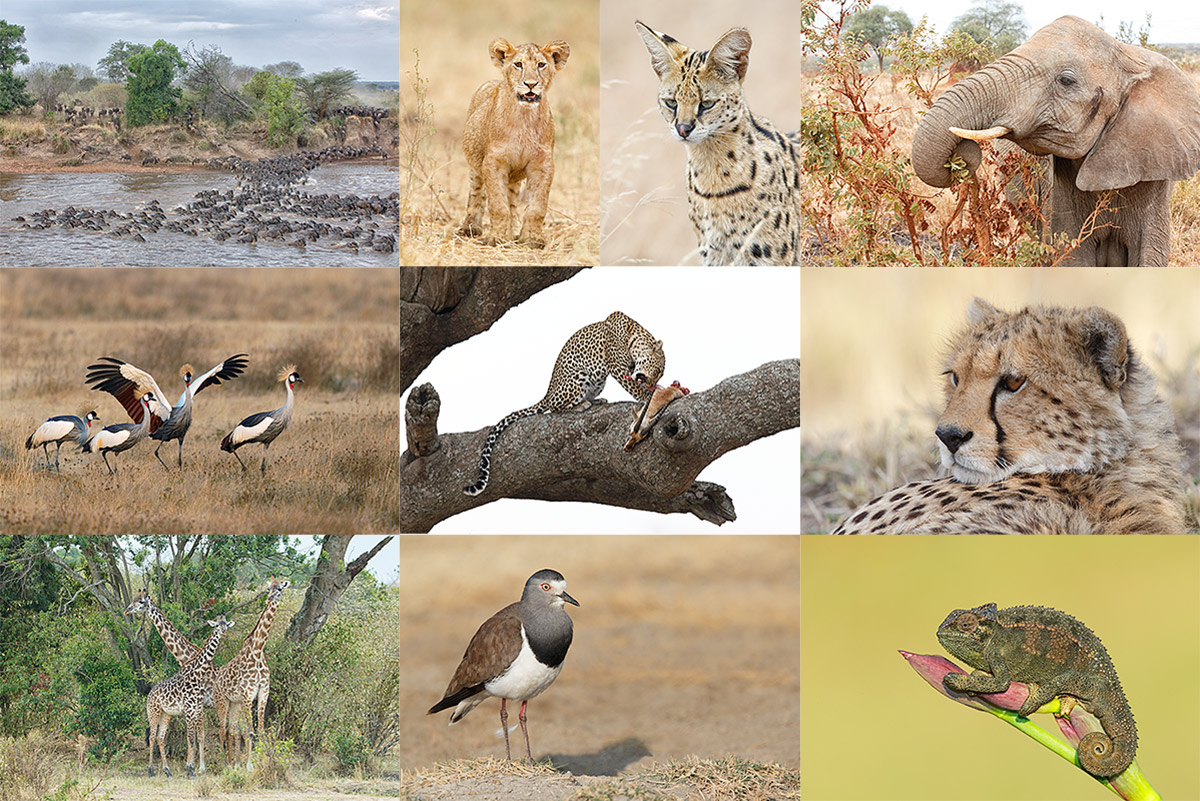
|
|
Join me for the 2014 Tanzania Summer Safari!
|
2014 Tanzania Summer Safari, 14-day African Adventure/leave the US on August 9. Fly home on August 24: $12,999.
Co-leaders Todd Gustafson & Arthur Morris. The limit is 12. Three photographers/van; you get your own row of seats. Our trip is a bit more expensive than the average safari for good reason. It is the best. We have the best driver guides with a total of decades of experience. They have been trained over the years by Todd and by me to drive with photography in mind. We have the best and most knowledgeable leaders. We stay in the best lodges and camps. We hope that you will join us for what will be Todd’s 35th African safari, and my 8th.
If you are seriously interested please e-mail me; I will be glad to send you the illustrated PDF with the complete itinerary and deposit info.
What else makes this expedition unique?
•Pre-trip consultation and camera equipment advice
•Award-winning photographers as your guides
•A seamless itinerary visiting the right locations at the best time of year
•Hands-on photography instruction in the field
•Specially designed three roof-hatch photo safari vehicles
•Proprietary materials for preparation, including free copy of “A Photographer’s Guide to Photographing in East Africa.”
•Post-safari image critiques
All-inclusive (double-occupancy) except for your flights to and from Kilamajaro Airport, bar drinks, soda & water (except at the Intimate Tented Camp where everything is free for our entire stay), tips for drivers and camp staff, personal items, and trip insurance.

|
|
Breathe deeply, bite the bullet, and live life to its fullest; we all get only one ride on the merry-go-round… Join me on this great trip.
Click on the image to enjoy a larger version.
|
The Southern Ocean…
If you would like to explore the possibility of joining me on the Cheesemans’ Ecology Safaris Antarctica/The Extended Expedition Voyage< trip: Antarctic Peninsula, South Georgia and Falkland Islands: December 13, 2014 to January 10, 2015, click here for additional information and then shoot me an e-mail.
The DPP RAW Conversion Guide
To learn why I use Canon’s Digital Photo Professional (DPP) to convert every image that I work on, click here.
Support the BAA Blog. Support the BAA Bulletins: Shop B&H here!
We want and need to keep providing you with the latest free information, photography and Photoshop lessons, and all manner of related information. Show your appreciation by making your purchases immediately after clicking on any of our B&H or Amazon Affiliate links in this blog post. Remember, B&H ain’t just photography!




 


Amazon
Everyone buys something from Amazon, be it a big lens or deodorant. Support the blog by starting your search by clicking on the logo-link below. No purchase is too small to be appreciated; they all add up. Why make it a habit? Because I make it a habit of bringing you new images and information on an almost daily basis.
Typos
In all blog posts and Bulletins, feel free to e-mail or to leave a comment regarding any typos, wrong words, misspellings, omissions, or grammatical errors. Just be right. 🙂
March 14th, 2014 105
This post marks 105 straight days with a new educational blog post. With so many folks getting in the habit of using our B&H and Amazon links why quit now? To show your appreciation for my efforts here, we do ask that you use our B&H and Amazon affiliate links for all of your B&H and Amazon purchases. Please check the availability of all photographic accessories in the BIRDS AS ART Online Store. We sell only what I use and depend on. We will not sell you junk. We know what you need to make creating great images easy and fun. And we are always glad to answer your gear questions via e-mail.
You can find the following items in the store: Gitzo tripods, Mongoose M3.6 and Wimberley heads, plates, low feet, and accessories, flash brackets, , Delkin e-film Pro Compact Flash Cards, LensCoat products, and our unique line-up of educational materials including ABP I & II, Digital Basics, Site and Set-up e-Guides, Canon and Nikon Camera Users and AF e-Guides, and MP-4 Photoshop video tutorials among others.
Note: though we almost never have Mongoose M3.6 heads in stock we do have a few on the shelf right now. We are still waiting for more CR-X5 plates. As always, the best way to ensure getting one of these great heads for your intermediate or super-telephoto lens (if they are out of stock) or one of the great CR-X5 plates is to call Jim and place your order. You are then ensured of getting one from our next shipment. We will not of course bill your credit card until the item ships or drop-ships.
We would of course appreciate you using our B&H and Amazon affiliate links for all of your B&H and Amazon major gear, video, electronic, household, and personal purchases. For the photographic stuff mentioned in the paragraph above we would of course greatly appreciate your business. Here is a huge thank you to the many who have been using our links on a regular basis and visiting the BAA Online store as well.
This blog post took about 2 1/2 hours to prepare. Enjoy.
Huge Thanks!
Huge thanks to the many readers who continue to use the BAA B&H and Amazon Affiliate links for purchases large and small. March has gotten off to a great start with folks buying several Version II Super-teles, several 1D X bodies, and a 200-400. Way to go and greatly appreciated. It is wonderful to see so many folks being appreciative of the streak. Remember, every purchase helps no matter how small and getting in the habit of using the BAA links will not cost you one penny more.
|

|
|
This Great Egret head portrait was created at Gatorland, Kissimmee, FL with the Gitzo 3532 LS carbon fiber tripod, the Mongoose M3.6 head, the Canon EF 800mm f/5.6L IS USM lens, and the EOS-1D Mark IV now replaced by the Canon EOS-1D X. ISO 400. Evaluative metering as framed: 1/320 sec. at f/9 in soft light in Manual mode.
Central Sensor/Rear Focus AI Servo-Expand as framed active at the moment of exposure. Click here to see the latest version of the Rear Focus Tutorial. Click on the image to see a larger version.
|
Gatorland Short Notice Saturday Full-Day In-the-Field Workshop
Last Chance/Call Today
Saturday March 15, 2014. 7:15am till 10:15am & 3:30pm till dusk. Lunch, image review, and Photoshop session included. Limit 6/Openings: 4. A very small group is likely: $399.
The cost of your Gatorland Photographer’s Pass is not included.
For the past few years the Great Egrets have been nesting earlier and earlier. Head portraits of this species in full breeding plumage are very likely. Nest building and flight likely. In the field you will learn to spot good situations, to choose the best perspective, to see and understand the light, to get the right exposure every time after making a single test exposure, and to design pleasing images by mastering your camera’s AF system.
At lunch we will review my images, take a look at five of your best images from the morning session (for those who opt to bring their laptops), and process a few of my images in Photoshop after converting them in DPP. That followed by Instructor Nap Time.
Payment in full via credit card is due upon registering. Please call Jim or Jennifer at 863-692-0906 to register. Ask for me if you have any questions.
|
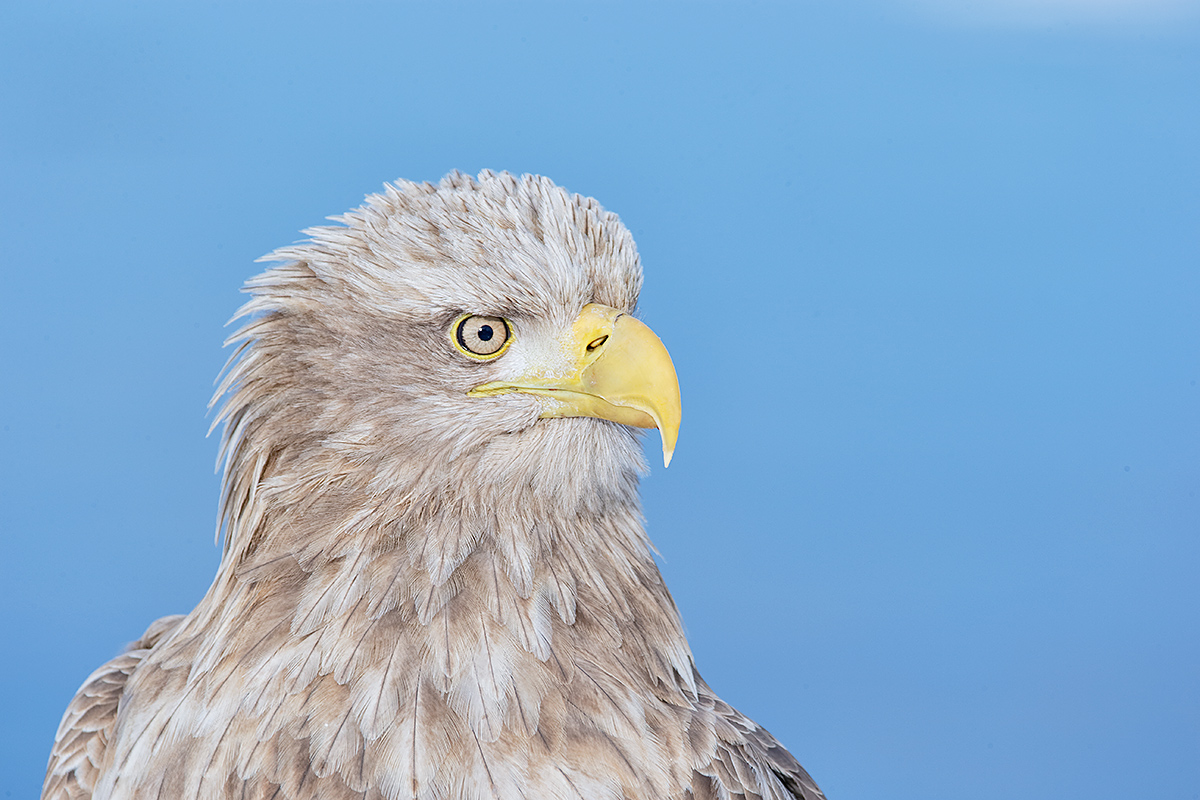
|
|
This White-tailed Sea Eagle head portrait was created on the morning of February 21, 2014 at 8:03am on the Japan in Winter IPT with the Canon EF 200-400mm f/4L IS USM Lens with Internal 1.4x Extender, an external Canon Extender EF 1.4X III (hand held at the maximum 784mm) and the Canon EOS-1D X. ISO 400. Evaluative metering +1 stop as framed: 1/400 sec. at f/10 in Av mode. AWB.
Central Sensor (by necessity)/AI Servo-Surround/Rear Focus AF on the middle of the bird’s bill was active at the moment of exposure. Click here to see the latest version of the Rear Focus Tutorial. Click on the image to see a larger version.
Image #1: White-tailed Sea Eagle Head Portrait
|
White-tailed: the Under-Appreciated Sea Eagle Species…
We made 3 eagle boat trips on the Japan in Winter IPT. We did so well on those that we skipped the fourth one (sorry artie, no refunds) so that we could get back to our lodge with time to pack for our flights back to Tokyo the following day. That necessary because of the several day blizzard-in-Rausu delay. In any case, I must admit that with dozens of spectacular Steller’s Sea Eagles flying around the boat and perched nearby on the sea ice I barely paid any attention at all to the numerous White-tailed Sea Eagles. Time after time they would fly by the boat at close range and I would just stand there with my lens by my side in the rest position waiting for yet another Steller’s….
I was on hand holding for the image above having added an external 1.4X TC so that I could do tight head and shoulders portraits of the Steller’s on ice when I noticed this bird off to my left with the boat drifting slowly towards it. What can I say? I could not resist the powder-puff blue background…. This image is un-cropped.
|
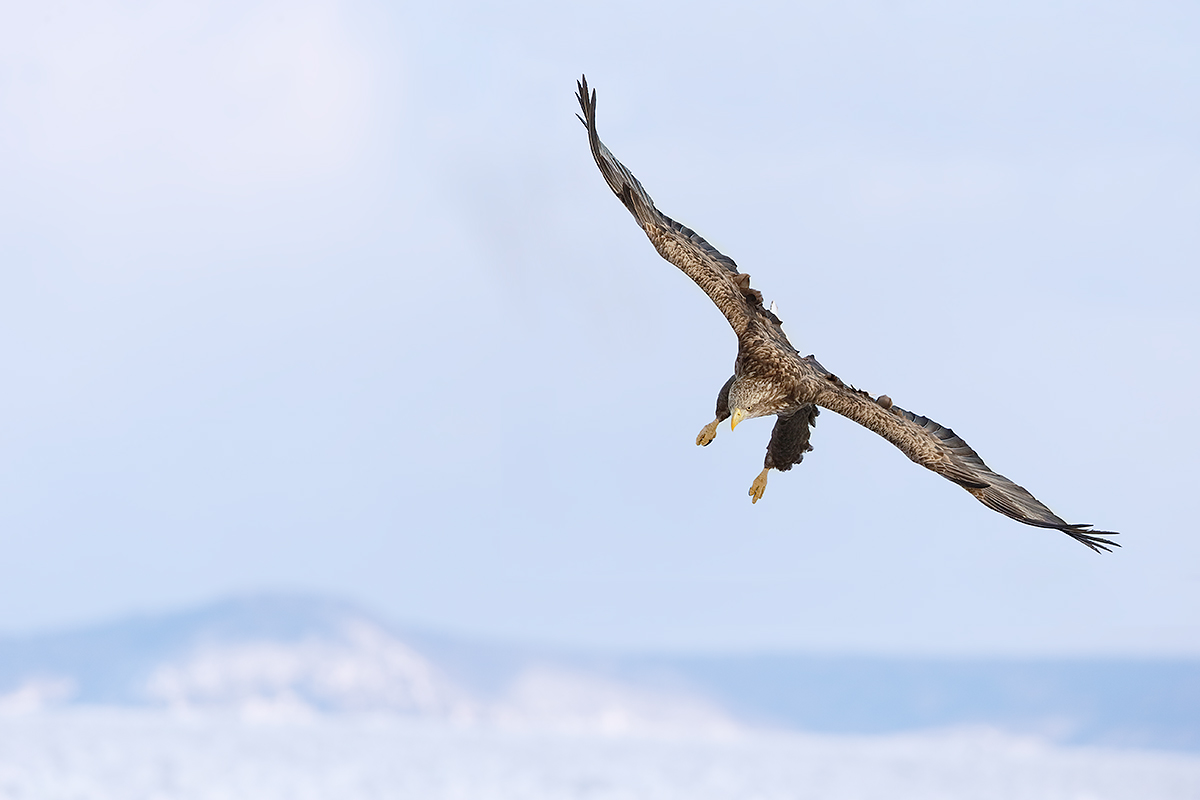
|
|
This image of a White-tailed Sea Eagle on approach was created at 2:23pm on the afternoon of February 21, 2014 on the Japan in Winter IPT with the Canon EF 200-400mm f/4L IS USM Lens with Internal 1.4x Extender (hand held with the internal extender in place at 442mm) and the Canon EOS-1D X. ISO 400. Evaluative metering +1 2/3 stops off the light toned sky in soft sunlight: 1/1250 sec. at f/6.3 in Manual mode. AWB.
Central Sensor/AI Servo-Surround/Rear Focus AF on the spot where the bird’s far wing meets the body as originally framed was active at the moment of exposure. Click here to see the latest version of the Rear Focus Tutorial. Click on the image to see a larger version.
Image #2: White-tailed Sea Eagle Above Distant Mountain Ridges
|
Add Mountains Whenever Possible
When photographing large birds in flight, be it Sandhill Cranes or flocks of geese at Bosque or Steller’s and White-tailed Sea Eagles in Rausu, Japan, it pays to keep and eye on the mountains in the distance and try to time the shutter release so as to include some peaks in the background. In general, you want the mountain ridges to occupy the bottom third of the frame with the bird above them. Or, you can create some nice images with the ridge taking up 2/3 or more of the frame and having the subject in the lower half of the frame. Worst case is having the top of the ridge bisect the bird.
|
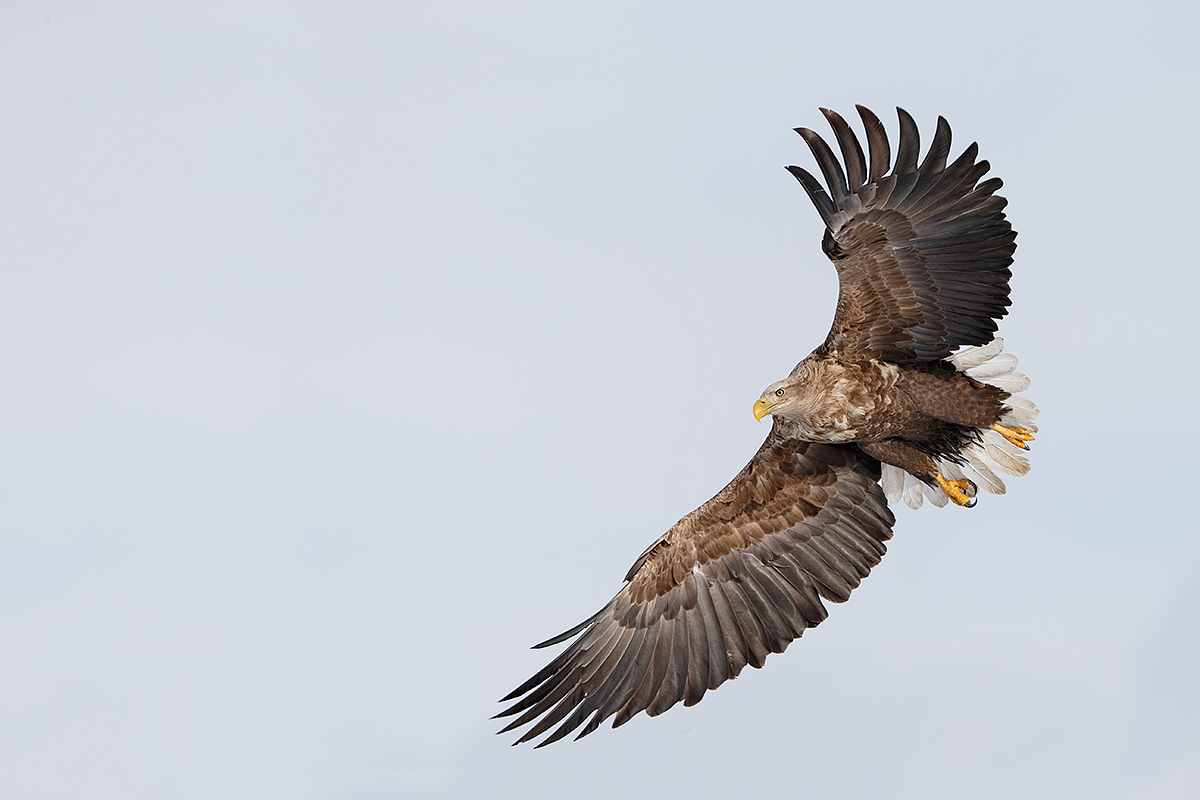
|
|
This White-tailed Sea Eagle flight image was was created at 2:40pm on the afternoon of February 21, 2014 on the Japan in Winter IPT with the Canon EF 200-400mm f/4L IS USM Lens with Internal 1.4x Extender (hand held with the internal extender in place at 442mm) and the Canon EOS-1D X. ISO 400. Evaluative metering +1 1/3 stops off the light toned sky in hazy sunlight: 1/1600 sec. at f/6.3 in Manual mode. AWB.
Central Sensor/AI Servo-Surround/Rear Focus AF on the spot where the bird’s near wing meets the body as originally framed was active at the moment of exposure. Click here to see the latest version of the Rear Focus Tutorial. Click on the image to see a larger version.
Image #3: White-tailed Sea Eagle in Flight
|
Flight Photography Composition
Take a peek at the two original frames below. Notice that in each image the bird was too centered. Why does that happen so often? Because the central AF sensor is the most sensitive and provides the most accurate tracking. At times–depending on the size and position of the bird in the frame it is possible to create a perfectly composed image using the central senor. But as we see below, using the central sensor often results in the subject being too centered. Note: if your panning speed does not keep up with the speed of the bird in flight the bird will wind up too far forward in the frame. This presents more problems than having the bird dead centered in the frame.
In the optimized version of Image #2 note how the bird has been moved back and up in the frame with the subject on the upper right side of the frame balancing nicely with the largest mountain peak on the lower left side of the frame. In the optimized version of Image #3 note that the subject has been moved well back in the frame and moved up just a bit. This leaves the bird pleasingly on the right side of the frame with lots of room on the left for the bird to fly into.
Your Favorite?
Consider taking a moment and letting us know which of today’s 3 images is best. And as always do let us know why you made your choice.
|
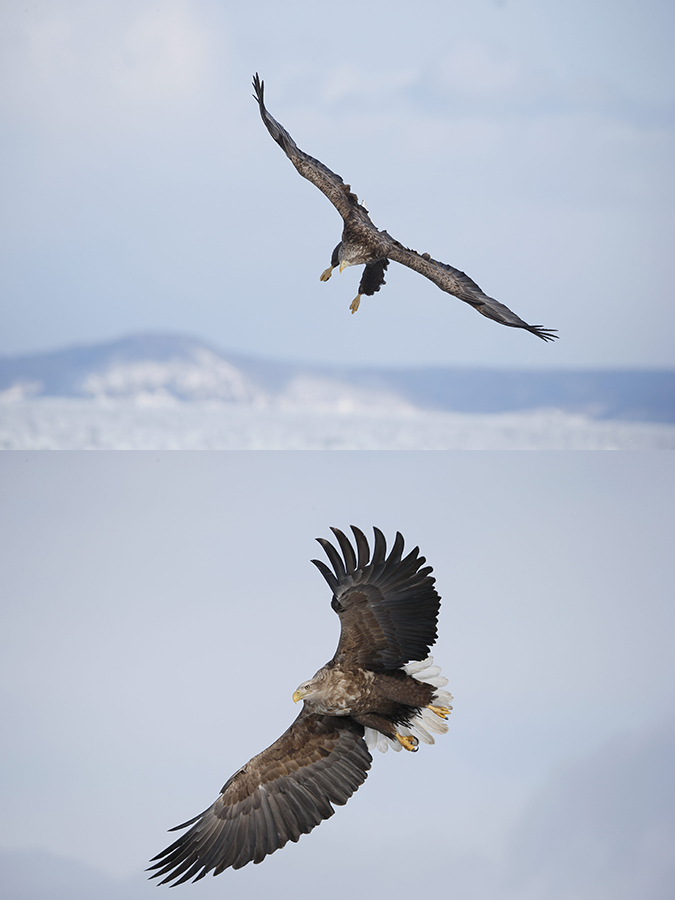
|
Top: the original for Image #2
Bottom: the original for Image #3
|
The Image Optimizations
All of the images here were converted in DPP. I applied my custom 50/50 (Tonal Contrast/Detail Extractor) layer to the bird only for each image reducing that about 50%. I selectively sharpened the face only in Image #1 and the whole bird in Images #2 & #3 with a Contrast Mask–Unsharp Mask 1t 15/65/0. The birds in #2 & #3 were moved in the frame using techniques detailed in APTATS I (advanced Quick Masking) and APTATS II (advanced Layer Masking).
The DPP RAW Conversion Guide
After seeing the accurate colors that I get from my DPP RAW conversions, Japan in Winter co-leader Paul McKenzie is switching to DPP conversions and Denise Ippolito is considering doing the same. Now that is amazing…. To learn why I use Canon’s Digital Photo Professional (DPP) to convert every image that I work on, click here.
Digital Basics
Are you tired of making your images look worse in Photoshop? Do you have no clue as to how I optimized the images above? Everything above plus tons more is detailed in my Digital Basics, an instructional PDF that is sent via e-mail. It includes my complete digital workflow, dozens of great Photoshop tips, the use of Contrast Masks, several different ways of expanding canvas, all of my time-saving Keyboard Shortcuts, Quick Masking, Layer Masking, and NIK Color Efex Pro basics, my killer image clean-up techniques, Digital Eye Doctor, creating time-saving actions, and lots more.
APTATS I & II
Learn the details of advanced Quick Masking techniques in APTATS I. Mention this blog post and apply a $5 discount with phone orders only. Learn advanced Layer Masking Techniques in APTATS II. Mention this blog post and apply a $5 discount with phone orders only. Buy the pair, APTATS I and APTATS II and we will be glad to apply at $15 discount with phone orders only.
IPT Info
Many of our great trips are filling up. With 5 Canadians and another couple recently signing up for our 4-DAY Bosque IPT, that workshop is filling up quickly. See also the info on the South Florida and Nickerson Beach IPTs. Two great leaders on most trips ensure that you will receive individual attention, have all of your questions answered, and learn a ton including how to think like a pro, see the situation, read the light and the wind direction, and get the right exposure every time. In addition you will have fun, and make lots of great images. Click here for IPT details and general information.
Support the BAA Blog. Support the BAA Bulletins: Shop B&H here!
We want and need to keep providing you with the latest free information, photography and Photoshop lessons, and all manner of related information. Show your appreciation by making your purchases immediately after clicking on any of our B&H or Amazon Affiliate links in this blog post. Remember, B&H ain’t just photography!




 


Amazon
Everyone buys something from Amazon, be it a big lens or deodorant. Support the blog by starting your search by clicking on the logo-link below. No purchase is too small to be appreciated; they all add up. Why make it a habit? Because I make it a habit of bringing you new images and information on an almost daily basis.
Typos
In all blog posts and Bulletins, feel free to e-mail or to leave a comment regarding any typos, wrong words, misspellings, omissions, or grammatical errors. Just be right. 🙂
March 13th, 2014 104
This post marks 104 straight days with a new educational blog post. With so many folks getting in the habit of using our B&H and Amazon links why quit now? To show your appreciation for my efforts here, we do ask that you use our B&H and Amazon affiliate links for all of your B&H and Amazon purchases. Please check the availability of all photographic accessories in the BIRDS AS ART Online Store. We sell only what I use and depend on. We will not sell you junk. We know what you need to make creating great images easy and fun. And we are always glad to answer your gear questions via e-mail.
You can find the following items in the store: Gitzo tripods, Mongoose M3.6 and Wimberley heads, plates, low feet, and accessories, flash brackets, , Delkin e-film Pro Compact Flash Cards, LensCoat products, and our unique line-up of educational materials including ABP I & II, Digital Basics, Site and Set-up e-Guides, Canon and Nikon Camera Users and AF e-Guides, and MP-4 Photoshop video tutorials among others.
Note: though we almost never have Mongoose M3.6 heads in stock we do have a few on the shelf right now. We are still waiting for more CR-X5 plates. As always, the best way to ensure getting one of these great heads for your intermediate or super-telephoto lens (if they are out of stock) or one of the great CR-X5 plates is to call Jim and place your order. You are then ensured of getting one from our next shipment. We will not of course bill your credit card until the item ships or drop-ships.
We would of course appreciate you using our B&H and Amazon affiliate links for all of your B&H and Amazon major gear, video, electronic, household, and personal purchases. For the photographic stuff mentioned in the paragraph above we would of course greatly appreciate your business. Here is a huge thank you to the many who have been using our links on a regular basis and visiting the BAA Online store as well.
This blog post took about 3 hours to prepare. Enjoy.
Huge Thanks!
Huge thanks to the many readers who continue to use the BAA B&H and Amazon Affiliate links for purchases large and small. March has gotten off to a great start with folks buying several Version II Super-teles, several 1D X bodies, and a 200-400. Way to go and greatly appreciated. It is wonderful to see so many folks being appreciative of the streak. Remember, every purchase helps no matter how small and getting in the habit of using the BAA links will not cost you one penny more.
We Meet
I first met Srdjan Mitrovic and his wife, Zorica Kovacevik, on a pre-voyage bus trip to Tierra del Feugo National Park, Argentina, the day before we boarded the ship for my first Cheesemans’s Extended Southern Ocean Expedition (The Falklands, South Georgia, and Antarctica). It was my 2nd such trip.
We were with a large group of birders hot to find a Magellanic Woodpecker. Then bingo, there was a group of 3 right in front of us pecking away at a rotted log on the ground. With so many folks in close proximity it was impossible to make an image and getting close was not an option unless we wanted to risk getting lynched. The birders all checked the species off their lists and when the birds flew off the birders dispersed.
As the only serious photographers Srdj and Zorica and I were the only ones left. I think that it was Zorica who said, Too bad, I would have loved to have gotten a good photograph. After introducing myself Zorica exclaimed, “Oh my God, are you really the Arthur Morris? I can’t believe it!” “Yup, that’s me,” I said, ” but listen up. The birds came down once to feed it is highly likely that they will repeat the same behavior. Let’s follow them.”
We did. And for the next three hours we photographed the group at close range.
Image Question
In the image above, how did I wind up at ISO 2500?
|
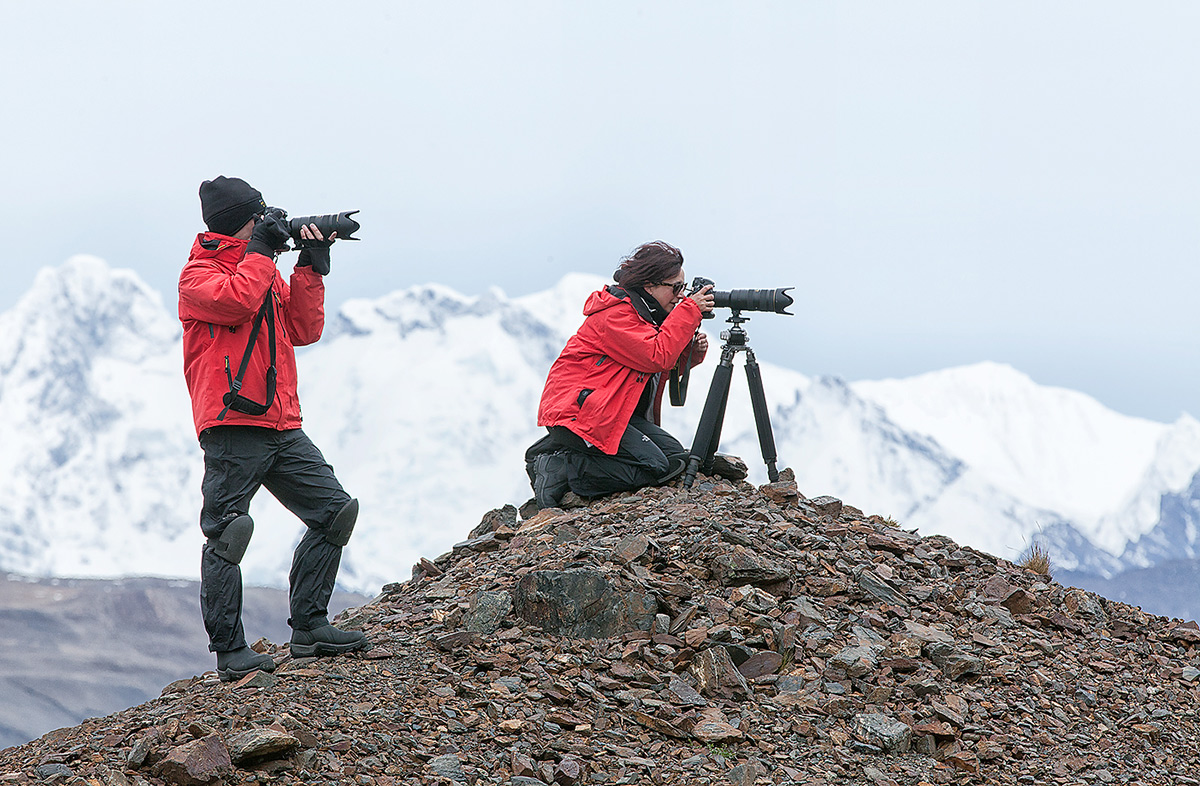
|
|
This image was created with the Canon EF 70-200mm f/2.8L IS II USM lens, the Canon Extender EF 1.4X III (hand held at 280mm), and the and the EOS-5D Mark II (now replaced by the Canon EOS 5D Mark III . ISO 400. Evaluative metering +1 1/3 stops as framed: 1/400 sec. at f/11 in Manual mode.
Central sensor/Rear Focus AI Servo AF on the photographer on the left and recompose. Click here to see the latest version of the Rear Focus Tutorial. Click on the image to see a larger version.
|
The Voyage
Though I spent a lot of money to make the first Cheesemans’ trip and had no clients, I found myself–as expected–doing lots of teaching both in the field and on the ship during image reviews and Photoshop sessions. Srdj and Zorica often stuck close by. We has a ton of fun. After I met Zorica at Keukenhof in 2013, we reconnected and she and Srdjan wound up joining me on the recently concluded Japan in Winter IPT.
I created the image above of them at Fortuna Bay, South Georgia in late December 2012 as they photographed from atop a small rocky knoll.
|
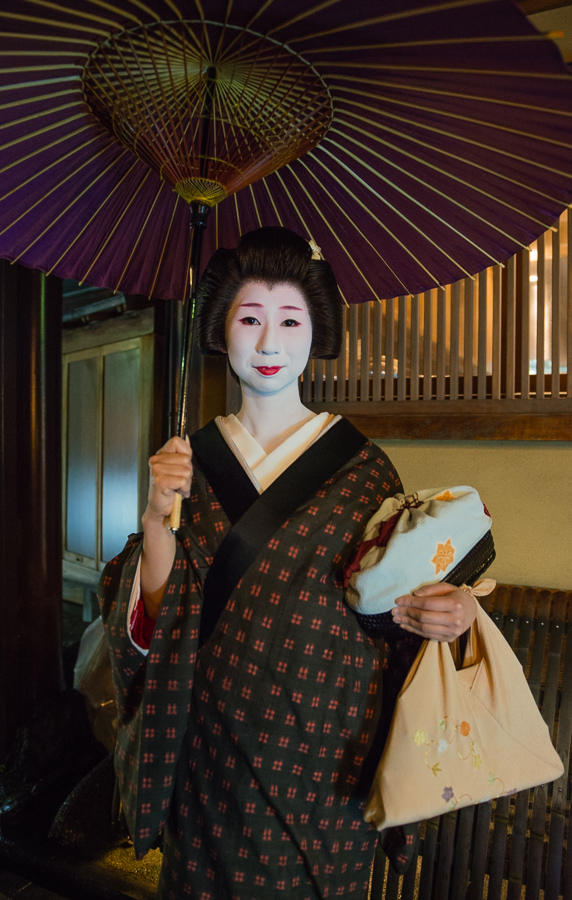
|
|
Image copyright 2014 and courtesy of Zorica Kovacevic.
|
The Geisha Connection
When the Japan in Winter IPT concluded, seven of us continued on the Kyoto to soak up some Japanese culture. From the get-go Zorica talked of going to the geisha districts, or possibly seeing a geisha. We did lots of walking tours. One night, as we were looking for a restaurant, a geisha accompanied by two Japanese gentlemen, was walking down the narrow street coming right at us.
I was amazed when a very excited Zorica took out her cell phone, touched the woman’s arm to get her attention, and asked if she could take her picture. I was more amazed when the geisha said yes. The two men stood off to the side and took a few snaps. Zorica kindly sent me three images; my favorite is above.
Though many folks routinely trash Wikipedia I often find the entries helpful. There is lots of confusion as to exactly what a Geisha is. I found the Wikipedia Geisha entry here quite helpful.
|
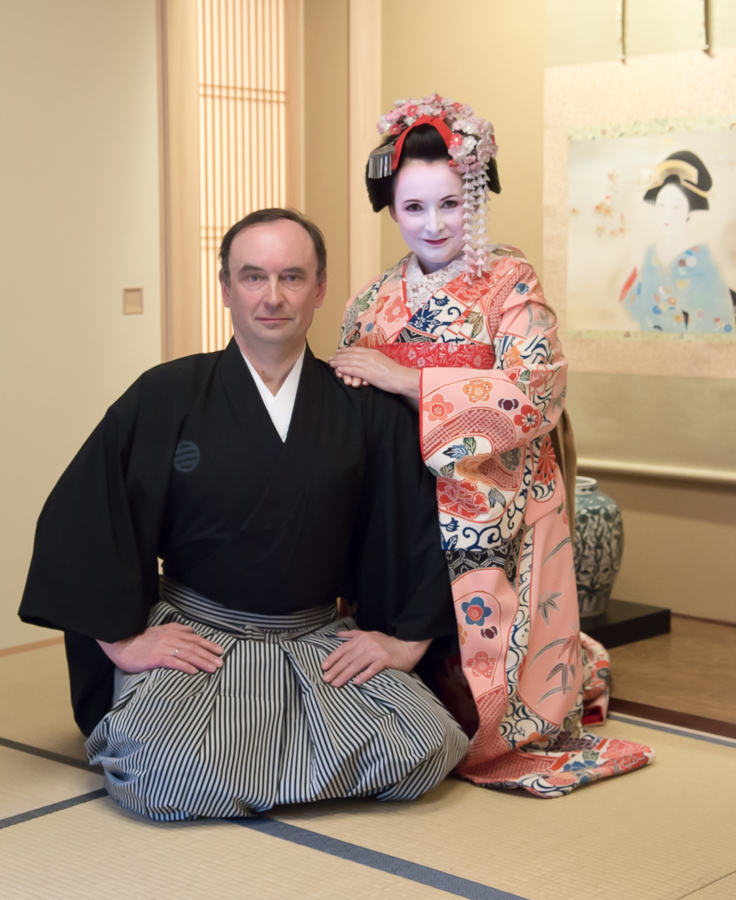
|
|
Image courtesy of Srdjan Mitrovic and Zorica Kovacevik. Copyright 2014: Maiko Transformation Studio Shiki.
|
Maiko Transformation Studio Shiki
Everyone is familiar with the brochure racks in most tourist hotels. Zorica found a brochure advertising the Maiko Transformation Studio Shiki, a place that would transform any woman into a Geisha and any man into a Samurai with full make-up and costumes. They made an appointment online and off they went. I thank them profusely for giving me permission to use the images here. And you gotta admit, they look pretty darned good.
Me thinks that most folks (including me) would be too self-conscious to do something like this. Heck, I am scared to get on a dance floor unless I am drunk and I have not been drunk in several decades…
|
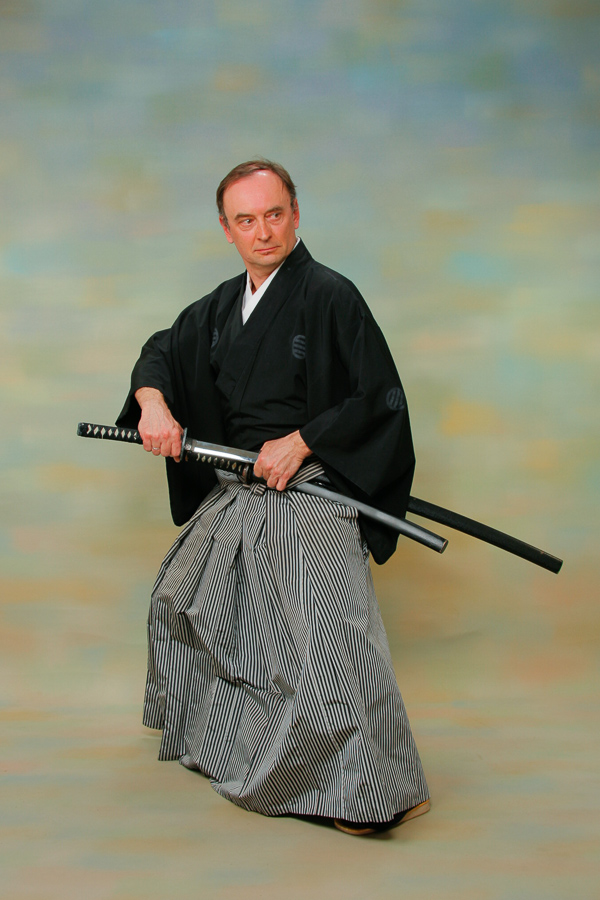
|
|
Image courtesy of Srdjan Mitrovic and Zorica Kovacevik. Copyright 2014: Maiko Transformation Studio Shiki.
|
Amazingly Courageous & Loving Life and Each Other
To me, getting transformed was a courageous act. I am curious, how many of you out there would try something like this without trepidation? Please leave a comment and let us know.
Srdjan, a software engineer for Google, is one of the nicest men you could ever hope to meet. He is funny–not sure if I mentioned the Saturday Night Hans and Franz connection, but we spent a good deal of time laughing. He routinely treats Zorica like his queen, granting her every request with a loving smile. And they always treat each other with uncommon respect, always smiling and laughing. And holding hands.
|
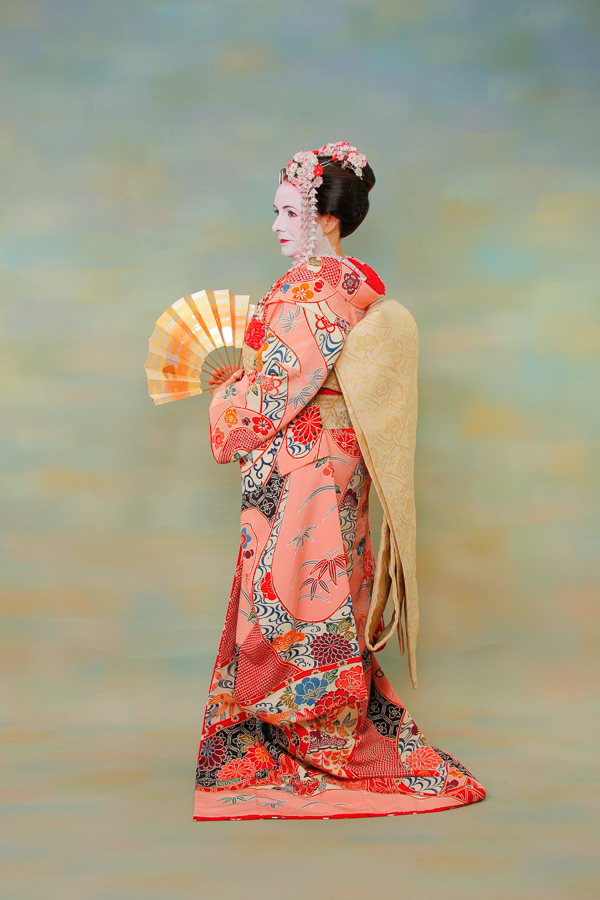
|
|
Image courtesy of Srdjan Mitrovic and Zorica Kovacevik. Copyright 2014: Maiko Transformation Studio Shiki.
|
…..

|
|
Breathe deeply, bite the bullet, and live life to its fullest; we all get only one ride on the merry-go-round… Join me on this great trip.
Click on the image to enjoy a larger version.
|
The Southern Ocean…
If you would like to explore the possibility of joining me on the Cheesemans’ Ecology Safaris Antarctica/The Extended Expedition Voyage: Antarctic Peninsula, South Georgia and Falkland Islands: December 13, 2014 to January 10, 2015, click here for additional information and then shoot me an e-mail.
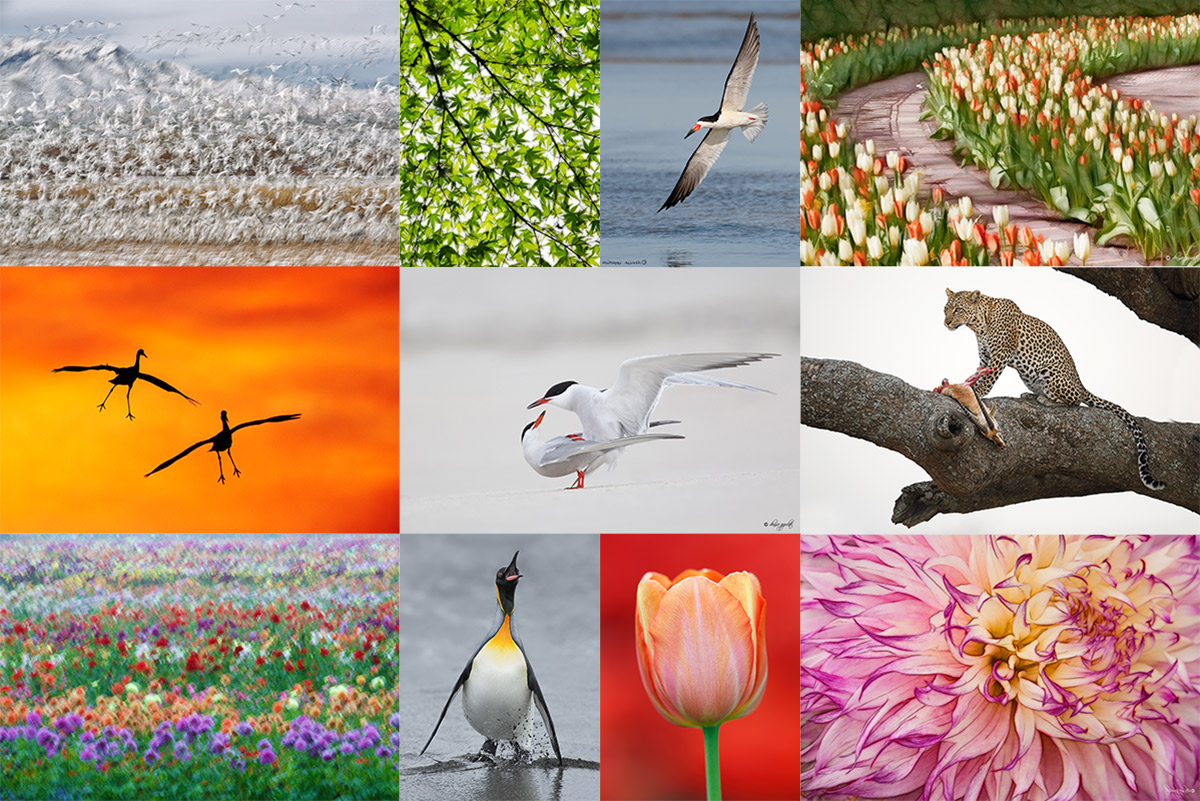
|
|
If you’d like to learn from the two folks who created the images in the composite above do consider one of the trips below. Denise Ippolito’s images: Japanese leaf painting, skimmer in flight, curved Keukenhof paths with tulips, copulating terns, & pink dahlia. Artie’s images: Snow Geese snowstorm blur, crane landing silhouettes, Leopard with prey in tree, King Penguin, & vertical tulip. Note: Denise alone will be leading the Torres del Paine workshop.
|
A Creative Adventure/BIRDS AS ART Instructional Photo-Tours (IPTs)/Two great leaders: Arthur Morris & Denise Ippolito.
Arthur Morris/BIRDS AS ART www.BIRDSASART-blog.com for the latest images, info, & education
Denise Ippolito/A Creative Adventure www.deniseippolito.com: get yourself out of the box!
Denise’s e-books: Bloomin’ Ideas, A Guide to Filters & Effects, The Softer Side of Macro, & more. Free Monthly Creative MiniMag: www.deniseippolito.com/magazine
Nickerson Baby Beach-nesting Birds IPT, Long Island, NY: 3-Full Days/July 22-24, 2014: $1199.
Black Skimmers, Common Terns with chicks, American Oystercatcher & Piping Plover families; breeding behaviors including courtship feeding, display flight and combat, and copulations. Gulls and shorebirds.
UK Puffins IPT. Early July, 2014.
Details TBA. Please e-mail to be placed on the interested list.
Tanzania Serengeti Summer Safari: Leave US: August 9—return: August 24, 2014: $12,999.
Co-leaders: Arthur Morris & Todd Gustafson. Wildebeest/The Great Migration, cats, elephant, giraffe, zebra, birds & more. Please e-mail for brochure.
Swan Island Dahlia Farm IPT, Canby, OR, September 8-12, 2014: 5 FULL DAYS: $1699.
Leader: Denise Ippolito. 40 acres with 350+dazzling varieties of dahlias in a plethora of colors, shapes and sizes. Sharpen your technical skills and boost your creative juices. Daily assignments, image sharing, and Photoshop sessions.
Bosque del Apache 2014 A Creative Adventure/BIRDS AS ART “Creative Photography Instructional Photo-Tour.” (IPT). NOV 24-25, 2014. 2-FULL DAYS: $729.
Leaders: Denise Ippolito & Arthur Morris. Introductory Slide program: 7:00pm on Sunday 11/23. This IPT is perfect for folks who want to learn to think outside the box, to create new and different images. Learn to unleash your creative juices at the wondrous Bosque del Apache, NWR in San Antonio, NM.
Bosque del Apache 2014 BIRDS AS ART/A Creative Adventure Instructional Photo-Tour (IPT). NOV 29-DEC 3, 2014. Totaling 4 FULL-DAYS: $1449
Leaders: Arthur Morris and Denise Ippolito. Introductory Slide program: 7:00pm on Sunday 11/29. Tens of thousand of Snow Geese, 10,000 Sandhill Cranes, ducks, amazing sunrises, sunsets, and blast-offs. Live, eat, and breathe photography with two of the world’s premier photographic educators at one of their very favorite photography locations on the planet.
Antarctica/The Extended Expedition Voyage: Antarctic Peninsula, South Georgia and Falkland Islands: December 13, 2014 to January 10, 2015.
Please e-mail for details.
BAA offers a wide range of books, e-Guides, and educational materials and photographic accessories at the lowest prices around—25+ years of experience, and the best advice you can get. We will not sell you junk. Access the BAA Store here or call us at 1-863-692-0906.
Questions? Please e-mail us at birdsasart@verizon.net or photographybydenise221@gmail.com.
Support the BAA Blog. Support the BAA Bulletins: Shop B&H here!
We want and need to keep providing you with the latest free information, photography and Photoshop lessons, and all manner of related information. Show your appreciation by making your purchases immediately after clicking on any of our B&H or Amazon Affiliate links in this blog post. Remember, B&H ain’t just photography!




 


Amazon
Everyone buys something from Amazon, be it a big lens or deodorant. Support the blog by starting your search by clicking on the logo-link below. No purchase is too small to be appreciated; they all add up. Why make it a habit? Because I make it a habit of bringing you new images and information on an almost daily basis.
Typos
In all blog posts and Bulletins, feel free to e-mail or to leave a comment regarding any typos, wrong words, misspellings, omissions, or grammatical errors. Just be right. 🙂
March 12th, 2014 103
This post marks 103 straight days with a new educational blog post. With so many folks getting in the habit of using our B&H and Amazon links why quit now? To show your appreciation for my efforts here, we do ask that use our B&H and Amazon affiliate links for all of your B&H and Amazon purchases. Please check the availability of all photographic accessories in the BIRDS AS ART Online Store. We sell only what I use and depend on. We will not sell you junk. We know what you need to make creating great images easy and fun. And we are always glad to answer your gear questions via e-mail.
You can find the following items in the store: Gitzo tripods, Mongoose M3.6 and Wimberley heads, plates, low feet, and accessories, flash brackets, , Delkin e-film Pro Compact Flash Cards, LensCoat products, and our unique line-up of educational materials including ABP I & II, Digital Basics, Site and Set-up e-Guides, Canon and Nikon Camera Users and AF e-Guides, and MP-4 Photoshop video tutorials among others.
Note: we almost never have Mongoose M3.6 heads in stock. We sell them as fast as we get them. The best way to ensure getting one of these great heads for your intermediate or super-telephoto lens is to call Jim and place your order. You are then ensured of getting one from our next shipment. We will not of course bill your credit card until the item ships or drop-ships.
We would of course appreciate you using our B&H and Amazon affiliate links for all of your B&H and Amazon major gear, video, electronic, household, and personal purchases. For the photographic stuff mentioned in the paragraph above we would of course greatly appreciate your business. Here is a huge thank you to the many who have been using our links on a regular basis and visiting the BAA Online store as well.
This blog post took about 2 1/2 hours to prepare. Enjoy.
|

|
|
This Great Egret head portrait was created at Gatorland, Kissimmee, FL with the Gitzo 3532 LS carbon fiber tripod, the Mongoose M3.6 head, the Canon EF 800mm f/5.6L IS USM lens, and the EOS-1D Mark IV now replaced by the Canon EOS-1D X. ISO 400. Evaluative metering as framed: 1/320 sec. at f/9 in soft light in Manual mode.
Central Sensor/Rear Focus AI Servo-Expand as framed active at the moment of exposure. Click here to see the latest version of the Rear Focus Tutorial. Click on the image to see a larger version.
|
Gatorland Short Notice Saturday Full-Day In-the-Field Workshop
Saturday March 15, 2014. 7:15am till 10:15am & 3:30pm till dusk. Lunch, image review, and Photoshop session included. Limit 6/Openings: 4. A very small group is likely: $399.
The cost of your Gatorland Photographer’s Pass is not included.
For the past few years the Great Egrets have been nesting earlier and earlier. Head portraits of this species in full breeding plumage are very likely. Nest building and flight likely. In the field you will learn to spot good situations, to choose the best perspective, to see and understand the light, to get the right exposure every time after making a single test exposure, and to design pleasing images by mastering your camera’s AF system.
At lunch we will review my images, take a look at five of your best images from the morning session (for those who opt to bring their laptops), and process a few of my images in Photoshop after converting them in DPP. That followed by Instructor Nap Time.
Payment in full via credit card is due upon registering. Please call Jim or Jennifer at 863-692-0906 to register. Ask for me if you have any questions.
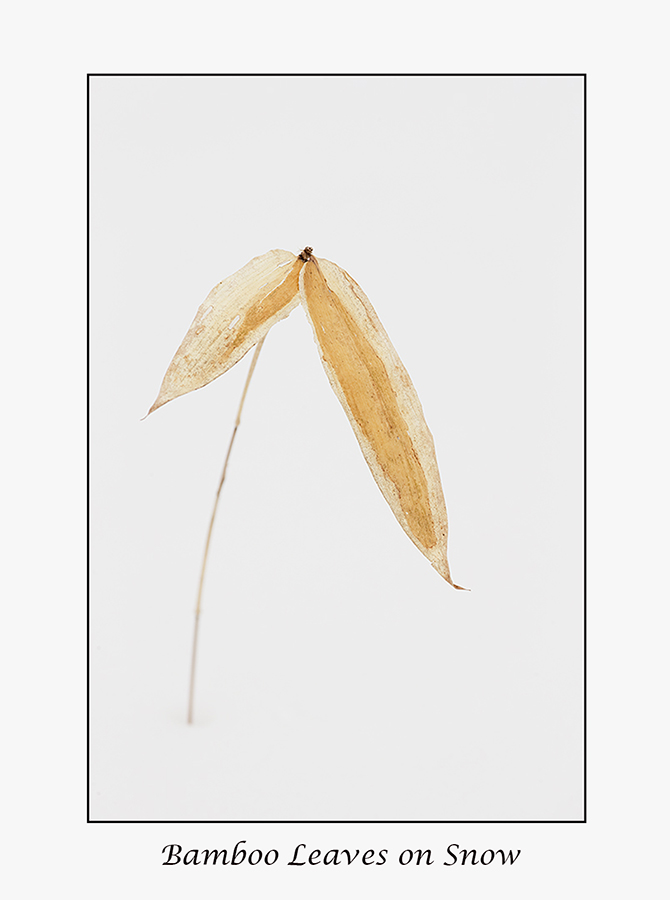
|
|
These new bamboo shoots were photographed on the Japan in Winter IPT with the Canon EF 200-400mm f/4L IS USM lens with Internal 1.4x Extender (hand held with the internal TC engaged at 506mm) and the Canon EOS-1D X. ISO 400. Evaluative metering +1 2/3 stops as framed: 1/640 sec. at f/8 in Manual mode. Color temperature: AWB. Click White Balance during the RAW conversion in DPP yielded pretty much perfectly WHITE snow with the three RGB values within a single digit of each other.
Five sensors up from the Central Sensor/AI Servo-Surround/Rear Focus AF as framed was active at the moment of exposure. Click here to see the latest version of the Rear Focus Tutorial. Click on the image to see a larger version.
The technique for creating the framed flower print look was taught to me by Denise Ippolito.
|
Remiss
I have been somewhat remiss on the blog in not following up on questions from previous posts (as I do here today). Do note that I will often comment on your answers (or questions) by leaving a comment at the post so be sure to check back often.
Best-Ever Hand Holding AF Tip
I have been stressing this super-important point both here on the blog and in seminars and on IPTs for years. In the recent Not Done Yet: Special Hokkaido Treats blog post I asked why it was important for me to be in AI Servo AF with AF active at the moment of exposure while creating the sublime bamboo leaves image. Though some folks eventually got to the point with their comments, it seems that most folks simply do not yet have the concept down pat:
When you are hand holding while standing and photographing a static subject it is pretty much mandatory that you be in AI Servo AF and have autofocus active at the moment of exposure. Why? Most folks cannot stay still enough to create razor sharp images if AF is not active. Our bodies move as we breathe and many folks including and especially me sway constantly.
If you are seated or otherwise able to brace your left forearm on something (like your left knee while seated for example), you can work set the (rear) focus or use One Shot AF and re-compose. Otherwise you need to be in AI Servo AF with AF active in order to in ensure accurate focus.
For years George Lepp has been able to stay relatively still enough to create sharp images without having AF active, and Denise Ippolito is incredibly skilled at doing the same. But in both instances they are working with relatively short macro lenses. It was Denise who taught me at Swan Island to press the shutter
button when the subject comes into sharp focus as I sway back and forth. Scroll down here for info on Denise’s September 2014 Swan Island Dahlia Farm Workshop.
My Favorite?
Like Michelle T, I liked both images a lot. The Ural Owl for the lovely bird and image design and the bamboo leaves image for the soft light and its simple yet powerful composition.
|
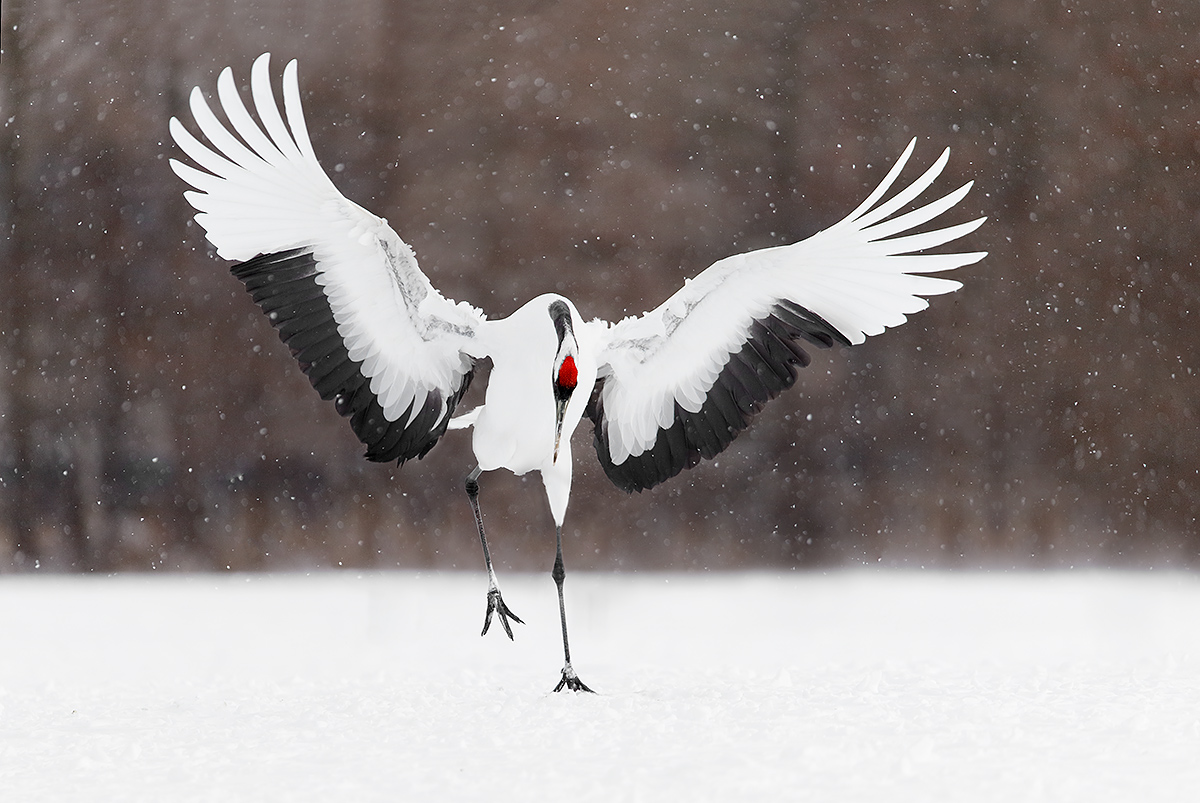
|
|
For me, the one hour that I spent on this image was indeed well worth it. You can see the original here.
|
What to Do?
In the What to Do? blog post, I asked, was it worth it? For me the answer of course was an obvious yes. Why? See the image immediately above…. The truth is that even though the Photoshop work there was exemplary pretty much anyone can learn to improve their post processing skills with a bit of study and practice. Best advice? Get yourself a copy of Digital Basics, an instructional PDF that is sent via e-mail. It includes my complete digital workflow, dozens of great Photoshop tips, the use of Contrast Masks, several different ways of expanding canvas, all of my time-saving Keyboard Shortcuts, Quick Masking, Layer Masking, and NIK Color Efex Pro basics, my killer image clean-up techniques, Digital Eye Doctor, creating time-saving actions, and lots more.
One Yakety Yakker Too Many?
In One Yakety Yakker Too Many? I actually liked the image with the two heads in the frame better than the image with the second yakking bird removed. Why? The original version coneys in part the fact that when one bird began calling that the others joined in and became part of a raucous chorus.
My Favorite?
I was alone in preferring the image of the young swan yakking. Why? The soft light, the sharpness, and the whimsical mood.
The Faces of ???
In the very popular The Faces of ??? post, I asked,
a-what do you think the monkey was thinking and feeling at the moment the image was created?
b-what do you think it was doing at the time the image was made?
c-can you think of a great title for the image?
Only a few folks opted to join in the fun.
Here you go:
Image 1.
a-Oh, Lord, does that feel good.
b-The monkey was being groomed by another in the onsen (the man made hot springs pool).
c-“Tranquility”
Image 2.
a-Ho, ho, that was a good one!
b-Hooting at a monkey that came too close.
c-:Too Funny!”
Image 3.
a-Whoa, this is a tough decision.
b-Staring straight ahead.
c-“Serious.”
Exposure Questions
In the same post I asked,” Why was the EC (exposure compensation) for the first image +1 2/3 stops while the EC for the second image was only +1 stop?”
The first image needed more + compensation in the soft light because the image as framed was much lighter in overall tonality than the 2nd image. Had the sun been out for both images I would have gone with +1/3 stop for the first image and zero for the second image. Please leave a comment if you think that you know why.
Bamboo-zled
In Bamboo-zled, my favorite images were #4 (above) and #6, the bamboo forest fish eye. Nobody but me chose #4? Why did I? It was created in the BAA style, tight, clean, and graphic. I loved the fish eye image for its unique perspective and because I worked so hard at creating it. (Yeah, I know, that is not supposed to matter….)
IPT Info
Many of our great trips are filling up. With 5 Canadians and another couple signing up for our 4-DAY Bosque IPT; that workshop is filling up quickly. See especially info on the Holland, and Nickerson Beach IPTs. Two great leaders on most trips ensure that you will receive individual attention, have all of your questions answered, and learn a ton including how to think like a pro, see the situation, and get the right exposure every time. In addition you will have fun, and make lots of great images. Click here for IPT details and general information.
|

|
|
Images copyright 2012: Denise Ippolito & Arthur Morris. Card design by Denise Ippolito. Click on the image to enjoy a spectacular larger version.
|
Holland 2014 7 1/2-Day/8-Night: A Creative Adventure/BIRDS AS ART/Tulips & A Touch of Holland IPT. April 17-April 24, 2014: $4995 Limit: 12/Openings: 5
We still have room for 5 more flower photographers on this great trip.
Join Denise Ippolito, Flower Queen and the author of “Bloomin’ Ideas,” and Arthur Morris, Canon Explorer of Light Emeritus and one of the planet’s premier photographic educators for a great trip to Holland in mid-April 2014. Day 1 of the IPT will be April 17, 2014. We will have a short afternoon get-together and then our first photographic session at the justly-famed Keukenhof. Most days we will return to the hotel for lunch, image sharing and a break. On Day 8, April 24, we will enjoy both morning and afternoon photography sessions.
The primary subjects will be tulips and orchids at Keukenhof and the spectacularly amazing tulip, hyacinth, and daffodil bulb fields around Lisse. In addition we will spend one full day in Amsterdam. There will be optional visits the Van Gogh Museum in the morning and the Anne Frank House in the afternoon; there will be plenty of time for street photography as well. And some great food. On another day we will have a wonderful early dinner at Kinderdijk and then head out with our gear to photograph the windmills and possibly some birds for those who bring their longs lenses. We will spend an afternoon in the lovely Dutch town of Edam where we will do some street photography and enjoy a superb dinner. All lodging, ground transportation, entry fees, and meals (from dinner on Day 1 through dinner on Day 8) are included. For those who will be bringing a big lens we will likely have an optional bird photography afternoon or two.
Click here for additional info or to register.

|
|
Join me for the 2014 Tanzania Summer Safari!
|
2014 Tanzania Summer Safari, 14-day African Adventure/leave the US on August 9. Fly home on August 24: $12,999.
Co-leaders Todd Gustafson & Arthur Morris. The limit is 12. Three photographers/van; you get your own row of seats. Our trip is a bit more expensive than the average safari for good reason. It is the best. We have the best driver guides with a total of decades of experience. They have been trained over the years by Todd and by me to drive with photography in mind. We have the best and most knowledgeable leaders. We stay in the best lodges and camps. We hope that you will join us for what will be Todd’s 35th African safari, and my 8th.
If you are seriously interested please e-mail me; I will be glad to send you the illustrated PDF with the complete itinerary and deposit info.
What else makes this expedition unique?
•Pre-trip consultation and camera equipment advice
•Award-winning photographers as your guides
•A seamless itinerary visiting the right locations at the best time of year
•Hands-on photography instruction in the field
•Specially designed three roof-hatch photo safari vehicles
•Proprietary materials for preparation, including free copy of “A Photographer’s Guide to Photographing in East Africa.”
•Post-safari image critiques
All-inclusive (double-occupancy) except for your flights to and from Kilamajaro Airport, bar drinks, soda & water (except at the Intimate Tented Camp where everything is free for our entire stay), tips for drivers and camp staff, personal items, and trip insurance.

|
|
Breathe deeply, bite the bullet, and live life to its fullest; we all get only one ride on the merry-go-round… Join me on this great trip.
Click on the image to enjoy a larger version.
|
The Southern Ocean…
If you would like to explore the possibility of joining me on the Cheesemans’ Ecology Safaris Antarctica/The Extended Expedition Voyage< trip: Antarctic Peninsula, South Georgia and Falkland Islands: December 13, 2014 to January 10, 2015, click here for additional information and then shoot me an e-mail.
The DPP RAW Conversion Guide
To learn why I use Canon’s Digital Photo Professional (DPP) to convert every image that I work on, click here.
Support the BAA Blog. Support the BAA Bulletins: Shop B&H here!
We want and need to keep providing you with the latest free information, photography and Photoshop lessons, and all manner of related information. Show your appreciation by making your purchases immediately after clicking on any of our B&H or Amazon Affiliate links in this blog post. Remember, B&H ain’t just photography!




 


Amazon
Everyone buys something from Amazon, be it a big lens or deodorant. Support the blog by starting your search by clicking on the logo-link below. No purchase is too small to be appreciated; they all add up. Why make it a habit? Because I make it a habit of bringing you new images and information on an almost daily basis.
Typos
In all blog posts and Bulletins, feel free to e-mail or to leave a comment regarding any typos, wrong words, misspellings, omissions, or grammatical errors. Just be right. 🙂
March 11th, 2014 102
This post marks 102 straight days with a new educational blog post. With so many folks getting in the habit of using our B&H and Amazon links why quit now? To show your appreciation for my efforts here, we do ask that use our B&H and Amazon affiliate links for all of your B&H and Amazon purchases. Please check the availability of all photographic accessories in the BIRDS AS ART Online Store. We sell only what I use and depend on. We will not sell you junk. We know what you need to make creating great images easy and fun. And we are always glad to answer your gear questions via e-mail.
You can find the following items in the store: Gitzo tripods, Mongoose M3.6 and Wimberley heads, plates, low feet, and accessories, flash brackets, , Delkin e-film Pro Compact Flash Cards, LensCoat products, and our unique line-up of educational materials including ABP I & II, Digital Basics, Site and Set-up e-Guides, Canon and Nikon Camera Users and AF e-Guides, and MP-4 Photoshop video tutorials among others.
Note: we almost never have Mongoose M3.6 heads in stock. We sell them as fast as we get them. The best way to ensure getting one of these great heads for your intermediate or super-telephoto lens is to call Jim and place your order. You are then ensured of getting one from our next shipment. We will not of course bill your credit card until the item ships or drop-ships.
We would of course appreciate you using our B&H and Amazon affiliate links for all of your B&H and Amazon major gear, video, electronic, household, and personal purchases. For the photographic stuff mentioned in the paragraph above we would of course greatly appreciate your business. Here is a huge thank you to the many who have been using our links on a regular basis and visiting the BAA Online store as well.
This blog post took about 1 1/2 hours to prepare. Enjoy.
|

|
|
This Great Egret head portrait was created at Gatorland, Kissimmee, FL with the Gitzo 3532 LS carbon fiber tripod, the Mongoose M3.6 head, the Canon EF 800mm f/5.6L IS USM lens, and the EOS-1D Mark IV now replaced by the Canon EOS-1D X. ISO 400. Evaluative metering as framed: 1/320 sec. at f/9 in soft light in Manual mode.
Central Sensor/Rear Focus AI Servo-Expand as framed active at the moment of exposure. Click here to see the latest version of the Rear Focus Tutorial. Click on the image to see a larger version.
|
Gatorland Short Notice Saturday Full-Day In-the-Field Workshop
Saturday March 15, 2014. 7:15am till 10:15am & 3:30pm till dusk. Lunch, image review, and Photoshop session included. Limit 6/Openings: 4. A very small group is likely: $399.
The cost of your Gatorland Photographer’s Pass is not included.
For the past few years the Great Egrets have been nesting earlier and earlier. Head portraits of this species in full breeding plumage are very likely. Nest building and flight likely. In the field you will learn to spot good situations, to choose the best perspective, to see and understand the light, to get the right exposure every time after making a single test exposure, and to design pleasing images by mastering your camera’s AF system.
At lunch we will review my images, take a look at five of your best images from the morning session (for those who opt to bring their laptops), and process a few of my images in Photoshop after converting them in DPP. That followed by Instructor Nap Time.
Payment in full via credit card is due upon registering. Call me all day on Sunday at 863-692-0906. If I am in the pool or napping, please shoot me an e-mail with a call back time and number. Weekdays you will get Jim or Jen. Ask for me if you have any questions.
|
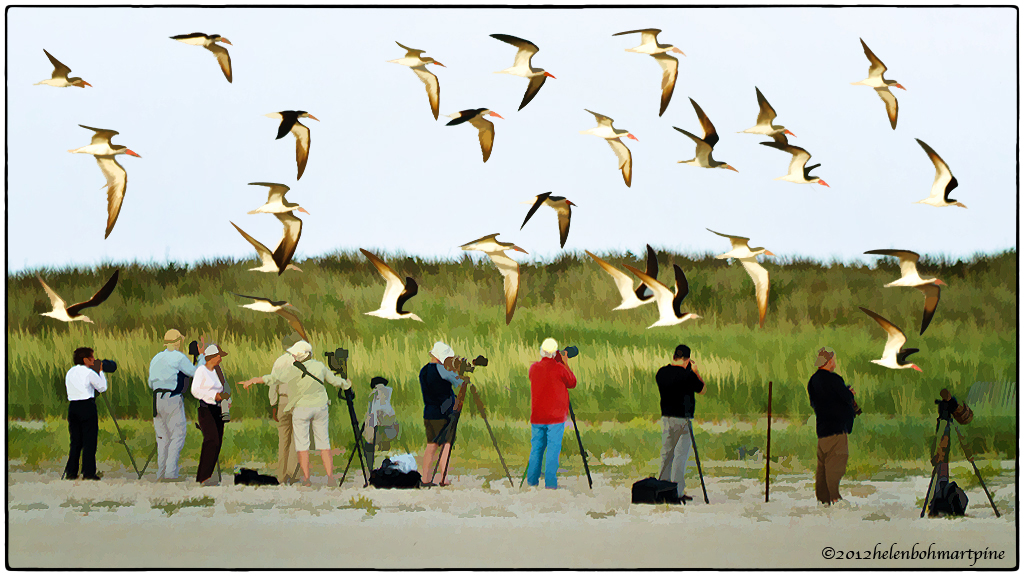
|
|
Artie and Denise & the 2012 Nickerson Beach IPT Crew. Image courtesy of and copyright 2012: Helen Bohmart Pine.
From left to right: Kitty Kono, yours truly, denise, Macolm MacKenzie (I think), Dierdre Sheer Gross (pointing), Michael Goodman, Stanley Goldberg, unknown photographer, & Tim Thompson. My favorite part: Helen made me look tall and thin!
|
BAA’s Economic Survival
In 2001, BAA sold the rights to images for more than $220,000 with VIREO (Visual Resources in Ornithology) as our only stock sales outlet. In other words, we sold lots of images ourselves. In tax year 2011, with images with Corbis and Visuals Unlimited, the total for image sales dropped to under $20,000. No matter how you slice it that represent a decline of more than 90%. Today, it is difficult to sell an image. With the handwriting on the wall I knew that we would need to adapt to survive. We have. We grew the mail order business via the BAA Online Store, we realized that creating income by selling information in digital form (PDFs)and MP4 Video Tutorials) would help save me from becoming a WalMart greeter, and we came to depend on the workshop business in the form of BIRDS AS ART Instructional Photo-Tours to remain more than solvent.
More recently our B&H and Amazon Affiliate link have done well and provided significant income as more and more folks have been using them in appreciation for my somewhat insane efforts here on the blog. As always, my #1 goal is to help folks become better photographers.
|

|
|
Nickerson Beach 2013 IPT images and card design copyright 2013: Arthur Morris/BIRDS AS ART. From upper left to right clockwise: skimmer blur, Sanderling flock with ocean and Long Beach, LI, NY in the background, backlit skimmer landing, Common Tern chick eating baby Bluefish, displaying American Oystercatcher, Common Tern brooding chick, young oystercatcher eating sand crab, newborn tern chick, adult Common Tern in flight.
Click on the image to enjoy a larger version.
|
It’s a Strange, Strange Business Indeed
Of late, the tour business has been hard to figure out. Here is a current example. In 2012 denise and I sold out our Nickerson Beach Workshop–see the opening image above. In 2013 it was a sell-out plus one over the limit. We were joined by John Van de Graaff, Doug West, Allan and Pat Lillich, Mike Goldhamer, Harry Hersh, Geri George, Lawrence Tawa, Paul Pinto Jr and his Dad, Brent Bridges, John Haedo, Tim Thompson, and Mark Hardymon. Though the season was late and as nature would have it, Black Skimmers were in short supply, we all had a great time with the Common Terns (especially the small chicks) and the American Oystercatcher families. Everyone went home smarter, more skilled, and very happy.
It is interesting to note that of the 13 folks, there were only 2 newcomers, the talented Paul Pinto Jr. and Larry Tawa from the West Coast. Larry signed up for Bosque last year but had to cancel at the last minute. We began advertising our 2014 Nickerson trip about 6 months ago. One old friend has been threatening to sign up but so far we have no registrants. As I said, things have been strange.
Two years ago I scheduled a San Diego IPT. When nobody signed up, I scrapped it. This year I planned a short-notice trip there and sold it out within one week. Go figure.
International Trips
International trips are just as strange. We sold out Holland with 12 last year, this year we have 7. Interested folks should sign up soon as we need to release the extra hotel rooms. Peter Kes will be joining us for the weekend. I sold out the recent Japan trip by invitation only in one day and am in the process of doing same with my 2016 Japan in Winter IPT. Galapagos 2015 is filling nicely. On the other hand, after doing a Camargue horses trip last year, dozens of folks e-mailed denise expressing interest. We put together a great trip but after several months with nobody signing up we were forced to cancel. Within a week of taking the trip down we received more than a dozen e-mails from folks ready and anxious to leave a deposit. Last year the Tanzania summer safari that I co-led with Todd Gustafson went with a group of 14. We are going again this year, right now with one client. I expect the UK puffins and gannets trip to sell out within days, but in reality, who knows?
As I’ve said, Go figure.
|

|
|
Nickerson Beach Summer 2013 images and card design copyright 2013: Denise Ippolito/A Creative Adventure. From upper left to right clockwise: Black Skimmers battling, Piping Plover goose-stepping, Common Terns copulating, Black Skimmer chick, skimmer aerial battle, adult oystercatcher sleeping on beach, juvenile oystercatcher striding, juvenile oystercatcher with prey item, backlit skimmer chick being fed at dawn.
Click on the image to enjoy a larger version.
|
Denise’s Card
As I mentioned above, the skimmers were both low in numbers and late nesting last July. Typically there would be lots of nests and more than a few small chicks on those dates. All of Neesie’s images above were made within 2 weeks of the IPT and the skimmer chicks in particular give a much more typical picture of activity in mid-July.
Nickerson Baby Beach-nesting Birds IPT: 3-Full Days/July 15-17, 2014: $1199. Introductory meet and greet: 8pm, Monday, July 14, 2014. Co-leaders Arthur Morris and Denise Ippolito
Join us on Long Island, NY next summer to photograph Black Skimmers, Common Terns with chicks, American Oystercatcher families, and possibly some just-hatched Black Skimmer chicks. The opportunities will include chances to photograph a variety of breeding behaviors including courtship feeding, display flight and combat, and copulations. Car-pooling is recommended; if we opt to return to the beach before 5pm there is a $30/vehicle parking fee that is not included so it is best to share that expense. Parking in the morning is free.
A $499 non-refundable deposit is required to hold your slot for this IPT. Your balance is due 4 months before the date of the IPT and is also non-refundable. If the trip fills, we will be glad to apply a credit applicable to a future IPT for the full amount less a $100 processing fee. If we do not receive your check for the balance on or before the due date we will try to fill your spot from the waiting list. If your spot is filled, you will lose your deposit. If not, you can secure your spot by paying your balance.
Please print, complete, and sign the form that is linked to here and shoot it to us along with your deposit check (made out to “Arthur Morris.”) Though we prefer a check, you can also leave your deposit with a credit card by calling the office at 863-692-0906. If you register by phone, please print, complete and sign the form as noted above and either mail it to us or e-mail the scan.
If you have any questions, please feel free to contact me via e-mail

|
|
Join Denise Ippolito and me for four great days of photography and learning at one of our soul places. Please click on the card to enjoy a larger version.
|
The Business of Bosque Workshops
Perhaps a dozen years ago I ran four 3-DAY Bosque IPTs with a limit of 16 photographers. They always sold out well in advance. As the years went by I cut down on the number of Bosque Workshops, made them longer, and reduced the group size. Until last year the plan was working fabulously well with my traditional Thanksgiving dates. Last year I had only a single photographer along for the whole ride with several more signing up for the short version after the holiday. In contrast, the 4-day Bosque 2014 IPT already has 8 folks signed up. Go figure….
As noted here previously, pretty much anyone with a camera is now qualified to lead a photography tour. While some appreciate great leaders with decades of experience, others are not. From where I sit, it is all about value. For now, I am doing just fine. Who knows what the future will bring? I surely don’t but I suspect that I will continue to do just fine. And so will denise.
Click here for the Instructional Photo-Tour schedule and complete IPT details.
Support the BAA Blog. Support the BAA Bulletins: Shop B&H here!
We want and need to keep providing you with the latest free information, photography and Photoshop lessons, and all manner of related information. Show your appreciation by making your purchases immediately after clicking on any of our B&H or Amazon Affiliate links in this blog post. Remember, B&H ain’t just photography!




 


Amazon
Everyone buys something from Amazon, be it a big lens or deodorant. Support the blog by starting your search by clicking on the logo-link below. No purchase is too small to be appreciated; they all add up. Why make it a habit? Because I make it a habit of bringing you new images and information on an almost daily basis.
Typos
In all blog posts and Bulletins, feel free to e-mail or to leave a comment regarding any typos, wrong words, misspellings, omissions, or grammatical errors. Just be right. 🙂
March 10th, 2014 101
This post marks 101 straight days with a new educational blog post. With so many folks getting in the habit of using our B&H and Amazon links why quit now? To show your appreciation for my efforts here, we do ask that use our B&H and Amazon affiliate links for all of your B&H and Amazon purchases. Please check the availability of all photographic accessories in the BIRDS AS ART Online Store. We sell only what I use and depend on. We will not sell you junk. We know what you need to make creating great images easy and fun. And we are always glad to answer your gear questions via e-mail.
You can find the following items in the store: Gitzo tripods, Mongoose M3.6 and Wimberley heads, plates, low feet, and accessories, flash brackets, , Delkin e-film Pro Compact Flash Cards, LensCoat products, and our unique line-up of educational materials including ABP I & II, Digital Basics, Site and Set-up e-Guides, Canon and Nikon Camera Users and AF e-Guides, and MP-4 Photoshop video tutorials among others.
Note: we almost never have Mongoose M3.6 heads in stock. We sell them as fast as we get them. The best way to ensure getting one of these great heads for your intermediate or super-telephoto lens is to call Jim and place your order. You are then ensured of getting one from our next shipment. We will not of course bill your credit card until the item ships or drop-ships.
We would of course appreciate you using our B&H and Amazon affiliate links for all of your B&H and Amazon major gear, video, electronic, household, and personal purchases. For the photographic stuff mentioned in the paragraph above we would of course greatly appreciate your business. Here is a huge thank you to the many who have been using our links on a regular basis and visiting the BAA Online store as well.
This blog post took about 1 1/2 hours to prepare. Enjoy.
|
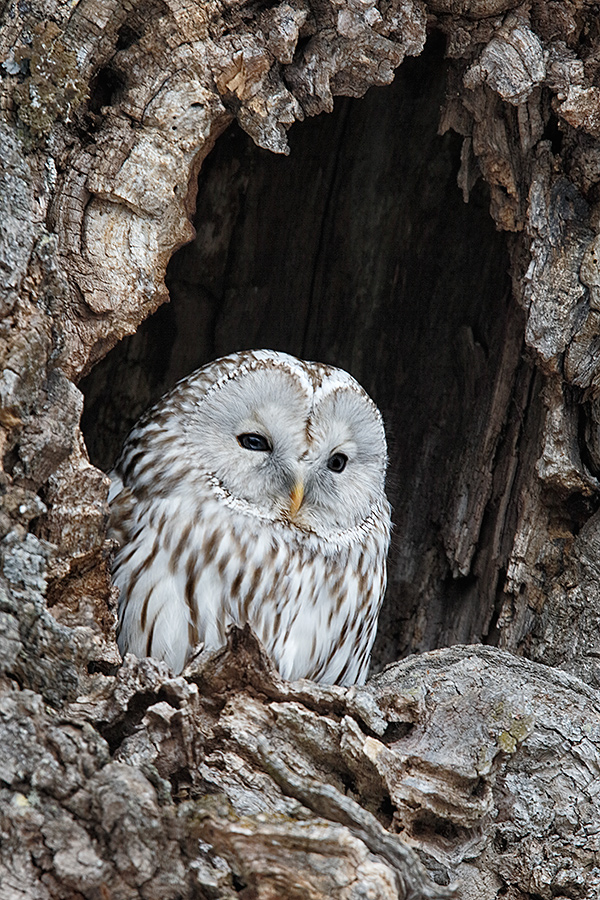
|
|
This Ural Owl image was created on the 2014 Japan in Winter with the Gitzo 3532 LS carbon fiber tripod, the Mongoose M3.6 head, the Canon EF 600mm f/4L IS II USM lens, the Canon 2x EF Extender III (Teleconverter), and the Canon EOS-1D X Digital SLR camera. ISO 400. Evaluative metering -1/3 stop as framed: 1/125 sec. at f/13 in Manual mode. Color Temperature: AWB.
The exposure here was about 1/2 stop too dark. I wanted to save some shutter speed as we were precariously positioned on a sloped, muddy hillside. ISO 800 would likely have been a better choice….
Central sensor (by necessity) Expand/AI Servo/Rear Focus on the bird’s eye and re-compose. Click here if you missed the Rear Focus Tutorial. Click on the image to see a larger version.
|
Special Hokkaido Treats
Owls are always special photographic subjects. As soon as our guide mentioned Ural Owl, everyone was chomping at the bit. One cloudy morning on the way back from somewhere he said, “We go to Ural Owl.” Because of the sensitivity of the site we split the group in two. We all enjoyed about 30 minutes with this beautiful bird. The owl, by the way, was totally unconcerned with our presence as we stayed very quiet and nobody slid down the hill…
|

|
|
These new bamboo shoots were photographed on the Japan in Winter IPT with the Canon EF 200-400mm f/4L IS USM lens with Internal 1.4x Extender (hand held with the internal TC engaged at 506mm) and the Canon EOS-1D X. ISO 400. Evaluative metering +1 2/3 stops as framed: 1/640 sec. at f/8 in Manual mode. Color temperature: AWB. Click White Balance during the RAW conversion in DPP yielded pretty much perfectly WHITE snow with the three RGB values within a single digit of each other.
Five sensors up from the Central Sensor/AI Servo-Surround/Rear Focus AF as framed was active at the moment of exposure. Click here to see the latest version of the Rear Focus Tutorial. Click on the image to see a larger version.
|
Bamboo Leaves
We saw hillsides of what I assume were new bamboo shoots, just a couple of leaves about 4-6 inches tall in all. Nothing like the fully grown trees that soar towards the heavens. (See Bamboo-zled, especially the fish eye image at the bottom of the blog post.) I was in the first Ural Owl group. As we were waiting for the other van to bring the rest of the group, I noted lots of small bamboo shoots poking out of the snow alongside the road. These two leaves screamed out to me, “See how pretty we are! Please take a picture of us.” The simple arrangement was so beautiful that I grabbed the 200-400 and went to work. I went to f/8 for a bit of extra depth-of field.
Here’s the rub: which is the more beautiful image? The owl, well done and a much desired subject? Or the simple image of the bamboo shoots in the snow? Which image do you like best? Be sure to let us know why.
Image Technique Question
In the bamboo shoot situation noted above, why was it mandatory to have AI Servo AF active at the moment of exposure?
The DPP RAW Conversion Guide
To learn why I use Canon’s Digital Photo Professional (DPP) to convert every image that I work on, click here.
|

|
|
This Great Egret head portrait was created at Gatorland, Kissimmee, FL with the Gitzo 3532 LS carbon fiber tripod, the Mongoose M3.6 head, the Canon EF 800mm f/5.6L IS USM lens, and the EOS-1D Mark IV now replaced by the Canon EOS-1D X. ISO 400. Evaluative metering as framed: 1/320 sec. at f/9 in soft light in Manual mode.
Central Sensor/Rear Focus AI Servo-Expand as framed active at the moment of exposure. Click here to see the latest version of the Rear Focus Tutorial. Click on the image to see a larger version.
|
Gatorland Short Notice Saturday Full-Day In-the-Field Workshop
Saturday March 15, 2014. 7:15am till 10:15am & 3:30pm till dusk. Lunch, image review, and Photoshop session included. Limit 6/Openings: 4. A very small group is likely: $399.
The cost of your Gatorland Photographer’s Pass is not included.
For the past few years the Great Egrets have been nesting earlier and earlier. Head portraits of this species in full breeding plumage are very likely. Nest building and flight likely. In the field you will learn to spot good situations, to choose the best perspective, to see and understand the light, to get the right exposure every time after making a single test exposure, and to design pleasing images by mastering your camera’s AF system.
At lunch we will review my images, take a look at five of your best images from the morning session (for those who opt to bring their laptops), and process a few of my images in Photoshop after converting them in DPP. That followed by Instructor Nap Time.
Payment in full via credit card is due upon registering. Call me all day on Sunday at 863-692-0906. If I am in the pool or napping, please shoot me an e-mail with a call back time and number. Weekdays you will get Jim or Jen. Ask for me if you have any questions.
IPT Info
Many of our great trips are filling up. With 5 Canadians and another couple signing up for our 4-DAY Bosque IPT; that workshop is filling up quickly. See especially info on the Holland, and Nickerson Beach IPTs. Two great leaders on most trips ensure that you will receive individual attention, have all of your questions answered, and learn a ton including how to think like a pro, see the situation, and get the right exposure every time. In addition you will have fun, and make lots of great images. Click here for IPT details and general information.
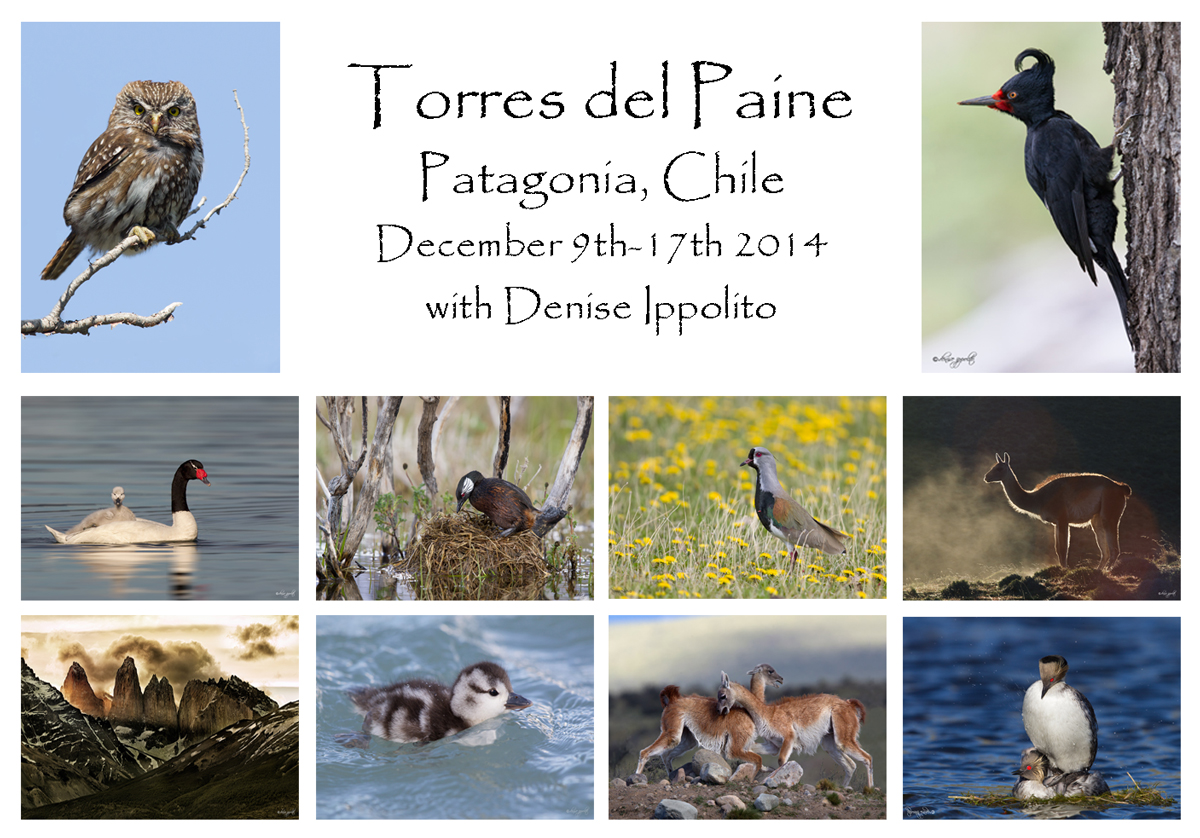
|
|
Image and card design copyright 2103: Denise Ippolito/A Creative Adventure
|
A Rare Photographic Opportunity
Torres del Paine/A Creative Adventure Workshop
Join Denise Ippolito for her first ever Torres del Paine workshop. As many of you know, she presented a program to Avistar Patagonia in November of 2013. We spent our days traveling to the famed Torres del Paine National Park in Chile. After the workshop was over Denise joined David Tipling and me for a few days of photography on our own at Torres del Paine. Once David left Denise and I met up with two professional guides and stayed inside the park for a week scouting and photographing on our own. She fell in love with the place and knew immediately that she would return with clients as this place has something for everyone. We will enjoy landscape photography, wildlife photography, bird photography and creative photography.
Participants will fly to the airport in Santiago, Chile (SCL) and take a connecting flight to Punta Arenas (PUQ). There we will be picked up by hotel van; these transfers are included. It is a four hour drive and most hotels do not include this pricey transfer. Once we reach our hotel we will check in and everything will be included: all meals, open bar, bilingual guides, transfers to and from the park, horseback riding if you want- or simply just photographing the horses. Note: your round trip airfare to and from Punta Arenas, Chile is not included in the trip fee. Denise has arranged for a private photo shoot of the horses running with gauchos. Anyone wishing to bring a spouse may; the price for a spouse or companion is the same. There will be other excursions, treks, and activities available as options. The group will photograph together in the mornings and again in the late afternoons (weather permitting). Free time can be enjoyed relaxing at the award-winning hotel, taking advantage of some of the amazingly plush amenities, downloading and reviewing images. or participating in small group image critique or Photoshop sessions with Denise.
Her goal is to help you create the best images at every stop of the journey. This will be an adventurous photography tour and Denise will be there to help you with your camera settings, lens selection, creative techniques and much more. December is the month that the Guanacos have their young; this may attract the Pumas into photographic range. We will hope to see Puma but our trip will not be based on that quest. December is one of the best times to visit the park for wildlife.
Torres del Paine/A Creative Adventure Photographic Workshop: December 9th- 17th. 2014: $6120 USD double occupancy.
This trip needs a minimum of 12 people to run; six down, six to go. You will need to wait until you hear from Denise before booking your flights. Travel insurance with TSI is recommended. Click here for more information or to register. Please let Denise know that BIRDS AS ART sent you. 🙂
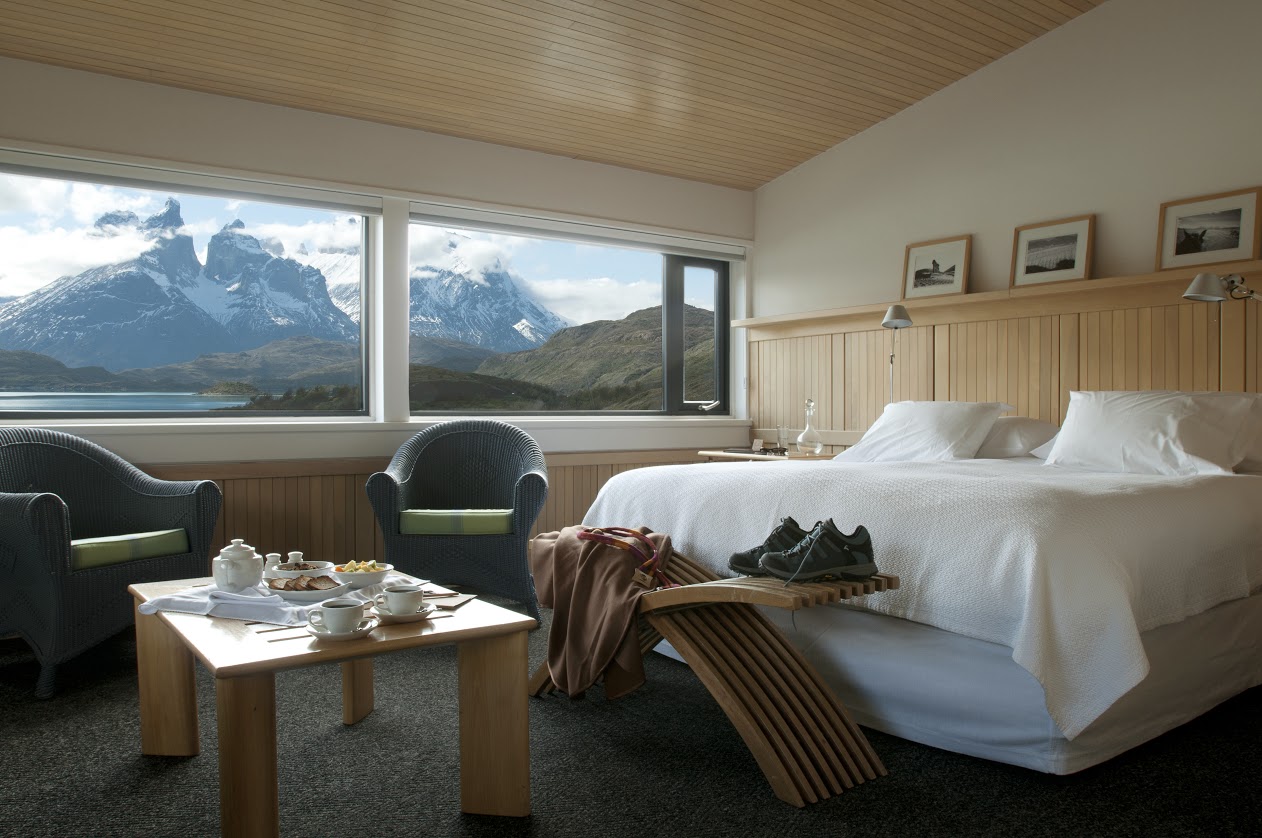
|
|
Image courtesy of and copyright Explora Patagonia.
|
The lodge/hotel, Explora Patagonia/Hotel Salto Chico). is the only hotel located in the heart of the extraordinary Torres del Paine National Park in central Patagonia. It is on the banks of the Salto Chico waterfall where we will have excellent view of the unique Paine Massif and two of the three impressive torres, or towers, that give the park its name. Situated on a 7.4-acre site, Explora Patagonia has 49 comfortable rooms, all with captivating views. The sophisticated design incorporates native lenga wood and cypress brought from the Guaitecas Archipelago, while the floor is made of almond wood. Each room has a small living area, hydromassage bath, and beds designed for deep, pleasurable sleep after a day of exploration.
The hotel is the only lodge in the area with its own horses, horses that have been bred and trained especially to be ridden by gringos. Denise loves being outdoors experiencing nature in its rawest form, however, a clean, comfortable bed in a luxurious hotel with gourmet food is a nice way to end the day! The coffee is great! Denise does not know if that matters to you but it matters to her 🙂

|
|
If you’d like to learn from the two folks who created the images in the composite above do consider one of the trips below. Denise Ippolito’s images: Japanese leaf painting, skimmer in flight, curved Keukenhof paths with tulips, copulating terns, & pink dahlia. Artie’s images: Snow Geese snowstorm blur, crane landing silhouettes, Leopard with prey in tree, King Penguin, & vertical tulip. Note: Denise alone will be leading the Torres del Paine workshop.
|
A Creative Adventure/BIRDS AS ART Instructional Photo-Tours (IPTs)/Two great leaders: Arthur Morris & Denise Ippolito.
Arthur Morris/BIRDS AS ART www.BIRDSASART-blog.com for the latest images, info, & education
Denise Ippolito/A Creative Adventure www.deniseippolito.com: get yourself out of the box!
Denise’s e-books: Bloomin’ Ideas, A Guide to Filters & Effects, The Softer Side of Macro, & more. Free Monthly Creative MiniMag: www.deniseippolito.com/magazine
Nickerson Baby Beach-nesting Birds IPT, Long Island, NY: 3-Full Days/July 22-24, 2014: $1199.
Black Skimmers, Common Terns with chicks, American Oystercatcher & Piping Plover families; breeding behaviors including courtship feeding, display flight and combat, and copulations. Gulls and shorebirds.
UK Puffins IPT. Early July, 2014.
Details TBA. Please e-mail to be placed on the interested list.
Tanzania Serengeti Summer Safari: Leave US: August 9—return: August 24, 2014: $12,999.
Co-leaders: Arthur Morris & Todd Gustafson. Wildebeest/The Great Migration, cats, elephant, giraffe, zebra, birds & more. Please e-mail for brochure.
Swan Island Dahlia Farm IPT, Canby, OR, September 8-12, 2014: 5 FULL DAYS: $1699.
Leader: Denise Ippolito. 40 acres with 350+dazzling varieties of dahlias in a plethora of colors, shapes and sizes. Sharpen your technical skills and boost your creative juices. Daily assignments, image sharing, and Photoshop sessions.
Bosque del Apache 2014 A Creative Adventure/BIRDS AS ART “Creative Photography Instructional Photo-Tour.” (IPT). NOV 24-25, 2014. 2-FULL DAYS: $729.
Leaders: Denise Ippolito & Arthur Morris. Introductory Slide program: 7:00pm on Sunday 11/23. This IPT is perfect for folks who want to learn to think outside the box, to create new and different images. Learn to unleash your creative juices at the wondrous Bosque del Apache, NWR in San Antonio, NM.
Bosque del Apache 2014 BIRDS AS ART/A Creative Adventure Instructional Photo-Tour (IPT). NOV 29-DEC 3, 2014. Totaling 4 FULL-DAYS: $1449
Leaders: Arthur Morris and Denise Ippolito. Introductory Slide program: 7:00pm on Sunday 11/29. Tens of thousand of Snow Geese, 10,000 Sandhill Cranes, ducks, amazing sunrises, sunsets, and blast-offs. Live, eat, and breathe photography with two of the world’s premier photographic educators at one of their very favorite photography locations on the planet.
Antarctica/The Extended Expedition Voyage: Antarctic Peninsula, South Georgia and Falkland Islands: December 13, 2014 to January 10, 2015.
Please e-mail for details.
BAA offers a wide range of books, e-Guides, and educational materials and photographic accessories at the lowest prices around—25+ years of experience, and the best advice you can get. We will not sell you junk. Access the BAA Store here or call us at 1-863-692-0906.
Questions? Please e-mail us at birdsasart@verizon.net or photographybydenise221@gmail.com.
Support the BAA Blog. Support the BAA Bulletins: Shop B&H here!
We want and need to keep providing you with the latest free information, photography and Photoshop lessons, and all manner of related information. Show your appreciation by making your purchases immediately after clicking on any of our B&H or Amazon Affiliate links in this blog post. Remember, B&H ain’t just photography!


 


Amazon
Everyone buys something from Amazon, be it a big lens or deodorant. Support the blog by starting your search by clicking on the logo-link below. No purchase is too small to be appreciated; they all add up. Why make it a habit? Because I make it a habit of bringing you new images and information on an almost daily basis.
Typos
In all blog posts and Bulletins, feel free to e-mail or to leave a comment regarding any typos, wrong words, misspellings, omissions, or grammatical errors. Just be right. 🙂
March 9th, 2014 The Streak Gets to 100
This post marks 100 straight days with a new blog post. Who’d of thunk it? Not me for sure. The streak may be extended for at least another day or so, or not. Or more…. To show your appreciation for my efforts here, we ask that use our B&H and Amazon affiliate links for all of your B&H and Amazon purchases. Please check the availability of all photographic accessories in the BIRDS AS ART Online Store. We sell only what I use and depend on. We will not sell you junk. We know what you need to make creating great images easy and fun. And we are always glad to answer your gear questions via e-mail.
You can find the following items in the store: Gitzo tripods, Mongoose M3.6 and Wimberley heads, plates, low feet, and accessories, flash brackets, , Delkin e-film Pro Compact Flash Cards, LensCoat products, and our unique line-up of educational materials including ABP I & II, Digital Basics, Site and Set-up e-Guides, Canon and Nikon Camera Users and AF e-Guides, and MP-4 Photoshop video tutorials among others.
Note: we almost never have Mongoose M3.6 heads in stock. We sell them as fast as we get them. The best way to ensure getting one of these great heads for your intermediate or super-telephoto lens is to call Jim and place your order. You are then ensured of getting one from our next shipment. We will not of course bill your credit card until the item ships or drop-ships.
We would of course appreciate you using our B&H and Amazon affiliate links for all of your B&H and Amazon major gear, video, electronic, household, and personal purchases. For the photographic stuff mentioned in the paragraph above we would of course greatly appreciate your business. Here is a huge thank you to the many who have been using our links on a regular basis and visiting the BAA Online store as well.
This blog post took about 1 1/2 hours to prepare. Enjoy.
Floored!
A decade ago I spend a good deal of my waking time engaged in online piss-fights. Many of them got quite ugly. I remember an Italian guy posting something to the effect that it was simply not possible to create a sharp image with a telephoto lens and a teleconverter. What I had to say was not pretty. And it went on back and forth for days. I was doing my best at the time, but….
That in mind I was absolutely floored to receive the following BPN Private Message from John Haig:
I wanted to take a moment to thank you, for all the lessons over the years. They started way back, reading your articles and with the purchase of “The Art of Bird Photography”. They have continued through your newsletter/blog and forum posts. I have learned a lot of great technical details from you. More importantly, I learned to really think about the images I make.
But that’s not why I want to thank you…or at least not the main reason. The most valuable lesson I have learned from you is from your truly exemplary debating skills, both in these forums, and on your blog. You state your points eloquently and with clarity. More importantly, you respond to challenges with dignity and a singular focus on points and facts that is truly masterful.
I know I’ve been engaged in debates and found myself asking “what would Arthur Morris do?” Thank you for always speaking your mind and being true to yourself. You’re the kind of person I think best exemplifies why I love Americans…because as similar in many aspects as we Canadians are, we are not nearly as good at free speech, and I believe that’s our great loss.
Be well, and I will continue to enjoy your work, both as a photographer and a teacher.
Best Regards, John
The Work
When I read John’s PM I had to read it again to make sure that he was talking about me. He was. And yes, I was floored. At times we continue to see our old selves being unable to note or acknowledge personal growth. It was great to receive John’s PM. In retrospect, my growth began after I started doing The Work of Byron Katie: Who would you be without your story?. I learned of Byron Katie from my good friend, my health and personal adviser, Dr. Cliff Oliver of San Diego, CA. Simply put, The Work helps you learn to love what is by asking four simple questions and turning them around. It was not until I began doing The Work on my late-wife Elaine’s death–breast cancer in 1994–that I came to be completely at peace with it. But doing The Work spun off to other areas of my daily life; most especially, it helped me learn to stay out of those energy-sapping, time consuming, totally worthless online confrontations. I still slip every once in a while, but I pretty much avoid them. You will never convince the nay-sayers, especially the very few bitter unhappy folks who derive pleasure from spreading their poison.
Loving what is is a great way to be. I hope that before they put me in a box that I have the opportunity to attend a Byron Katie event and to give her a hug. Two of her can’t miss works are “Loving What Is: Four Questions That Can Change Your Life” and “I Need Your Love – Is That True?: How to Stop Seeking Love, Approval, and Appreciation and Start Finding Them Instead.” I am still working on the latter :). In any case I am much more at peace than I was six years ago. And it’s nice to have someone notice it so thanks John!
Do The Work For Free
Learn more about the work here. You can get started doing the work for free by downloading the “Judge Your Neighbor” worksheet here. Answer the four questions at the bottom of the sheet and do the turn-arounds. You will be well on your way to finding peace.
|

|
|
This Great Egret head portrait was created at Gatorland, Kissimmee, FL with the Gitzo 3532 LS carbon fiber tripod, the Mongoose M3.6 head, the Canon EF 800mm f/5.6L IS USM lens, and the EOS-1D Mark IV now replaced by the Canon EOS-1D X. ISO 400. Evaluative metering as framed: 1/320 sec. at f/9 in soft light in Manual mode.
Central Sensor/Rear Focus AI Servo-Expand as framed active at the moment of exposure. Click here to see the latest version of the Rear Focus Tutorial. Click on the image to see a larger version.
|
Gatorland Short Notice Saturday Full-Day In-the-Field Workshop
Saturday March 15, 2014. 7:15am till 10:15am & 3:30pm till dusk. Lunch, image review, and Photoshop session included. Limit 6. A very small group is likely: $399.
The cost of your Gatorland Photographer’s Pass is not included.
For the past few years the Great Egrets have been nesting earlier and earlier. Head portraits of this species in full breeding plumage are very likely. Nest building and flight likely. In the field you will learn to spot good situations, to choose the best perspective, to see and understand the light, to get the right exposure every time after making a single test exposure, and to design pleasing images by mastering your camera’s AF system.
At lunch we will review my images, take a look at five of your best images from the morning session (for those who opt to bring their laptops), and process a few of my images in Photoshop after converting them in DPP. That followed by Instructor Nap Time.
Payment in full via credit card is due upon registering. Call me all day on Sunday at 863-692-0906. If I am in the pool or napping, please shoot me an e-mail with a call back time and number. Weekdays you will get Jim or Jen. Ask for me if you have any questions.
IPT Info
Many of our great trips are filling up. With 5 Canadians and another couple signing up for our 4-DAY Bosque IPT; that workshop is filling up quickly. See especially info on the Holland, and Nickerson Beach IPTs. Two great leaders on most trips ensure that you will receive individual attention, have all of your questions answered, and learn a ton including how to think like a pro, see the situation, and get the right exposure every time. In addition you will have fun, and make lots of great images. Click here for IPT details and general information.
|

|
|
Images copyright 2012: Denise Ippolito & Arthur Morris. Card design by Denise Ippolito. Click on the image to enjoy a spectacular larger version.
|
Holland 2014 7 1/2-Day/8-Night: A Creative Adventure/BIRDS AS ART/Tulips & A Touch of Holland IPT. April 17-April 24, 2014: $4995 Limit: 12/Openings: 5
We still have room for 5 more flower photographers on this great trip.
Join Denise Ippolito, Flower Queen and the author of “Bloomin’ Ideas,” and Arthur Morris, Canon Explorer of Light Emeritus and one of the planet’s premier photographic educators for a great trip to Holland in mid-April 2014. Day 1 of the IPT will be April 17, 2014. We will have a short afternoon get-together and then our first photographic session at the justly-famed Keukenhof. Most days we will return to the hotel for lunch, image sharing and a break. On Day 8, April 24, we will enjoy both morning and afternoon photography sessions.
The primary subjects will be tulips and orchids at Keukenhof and the spectacularly amazing tulip, hyacinth, and daffodil bulb fields around Lisse. In addition we will spend one full day in Amsterdam. There will be optional visits the Van Gogh Museum in the morning and the Anne Frank House in the afternoon; there will be plenty of time for street photography as well. And some great food. On another day we will have a wonderful early dinner at Kinderdijk and then head out with our gear to photograph the windmills and possibly some birds for those who bring their longs lenses. We will spend an afternoon in the lovely Dutch town of Edam where we will do some street photography and enjoy a superb dinner. All lodging, ground transportation, entry fees, and meals (from dinner on Day 1 through dinner on Day 8) are included. For those who will be bringing a big lens we will likely have an optional bird photography afternoon or two.
Click here for additional info or to register.

|
|
Join me for the 2014 Tanzania Summer Safari!
|
2014 Tanzania Summer Safari, 14-day African Adventure/leave the US on August 9. Fly home on August 24: $12,999.
Co-leaders Todd Gustafson & Arthur Morris. The limit is 12. Three photographers/van; you get your own row of seats. Our trip is a bit more expensive than the average safari for good reason. It is the best. We have the best driver guides with a total of decades of experience. They have been trained over the years by Todd and by me to drive with photography in mind. We have the best and most knowledgeable leaders. We stay in the best lodges and camps. We hope that you will join us for what will be Todd’s 35th African safari, and my 8th.
If you are seriously interested please e-mail me; I will be glad to send you the illustrated PDF with the complete itinerary and deposit info.
What else makes this expedition unique?
•Pre-trip consultation and camera equipment advice
•Award-winning photographers as your guides
•A seamless itinerary visiting the right locations at the best time of year
•Hands-on photography instruction in the field
•Specially designed three roof-hatch photo safari vehicles
•Proprietary materials for preparation, including free copy of “A Photographer’s Guide to Photographing in East Africa.”
•Post-safari image critiques
All-inclusive (double-occupancy) except for your flights to and from Kilamajaro Airport, bar drinks, soda & water (except at the Intimate Tented Camp where everything is free for our entire stay), tips for drivers and camp staff, personal items, and trip insurance.

|
|
Breathe deeply, bite the bullet, and live life to its fullest; we all get only one ride on the merry-go-round… Join me on this great trip.
Click on the image to enjoy a larger version.
|
The Southern Ocean…
If you would like to explore the possibility of joining me on the Cheesemans’ Ecology Safaris Antarctica/The Extended Expedition Voyage< trip: Antarctic Peninsula, South Georgia and Falkland Islands: December 13, 2014 to January 10, 2015, click here for additional information and then shoot me an e-mail.
The DPP RAW Conversion Guide
To learn why I use Canon’s Digital Photo Professional (DPP) to convert every image that I work on, click here.
Support the BAA Blog. Support the BAA Bulletins: Shop B&H here!
We want and need to keep providing you with the latest free information, photography and Photoshop lessons, and all manner of related information. Show your appreciation by making your purchases immediately after clicking on any of our B&H or Amazon Affiliate links in this blog post. Remember, B&H ain’t just photography!


 


Amazon
Everyone buys something from Amazon, be it a big lens or deodorant. Support the blog by starting your search by clicking on the logo-link below. No purchase is too small to be appreciated; they all add up. Why make it a habit? Because I make it a habit of bringing you new images and information on an almost daily basis.
Typos
In all blog posts and Bulletins, feel free to e-mail or to leave a comment regarding any typos, wrong words, misspellings, omissions, or grammatical errors. Just be right. 🙂
March 8th, 2014 Jet Lag Update
Again following the melatonin protocol that I described yesterday, I had another 8+ hours of great sleep with only one pit stop. I was remiss in not mentioning that after meeting Cliff Oliver on a Bosque IPT probably 18 years ago he helped me get on a new path and begin taking care of my health. Without his guidance I would surely be resting in a rotting wooden box somewhere. Of that I have no doubt as I had been doing a great job of killing myself with food for more than four decades. Learn more about my San Diego health guru Dr. Cliff Oliver by clicking here. Or like Cliff on Facebook and learn a ton about Wellness here.
The Streak
This post marks 99 straight days with a new blog post, a record by far that should be extended for at least another day or so, or not. Or more…. To show your appreciation for my efforts here, we ask that use our B&H and Amazon affiliate links for all of your B&H and Amazon purchases. Please check the availability of all photographic accessories in the BIRDS AS ART Online Store. We sell only what I use and depend on. We will not sell you junk. We know what you need to make creating great images easy and fun. And we are always glad to answer your gear questions via e-mail.
You can find the following items in the store: Gitzo tripods, Mongoose M3.6 and Wimberley heads, plates, low feet, and accessories, flash brackets, , Delkin e-film Pro Compact Flash Cards, LensCoat products, and our unique line-up of educational materials including ABP I & II, Digital Basics, Site and Set-up e-Guides, Canon and Nikon Camera Users and AF e-Guides, and MP-4 Photoshop video tutorials among others.
We would of course appreciate you using our B&H and Amazon affiliate links for all of your B&H and Amazon major gear, video, electronic, household, and personal purchases. For the photographic stuff mentioned in the paragraph above we would of course greatly appreciate your business. Here is a huge thank you to the many who have been using our links on a regular basis and visiting the BAA Online store as well.
This blog post took about 2 1/2 hours to prepare. Enjoy and learn.
|
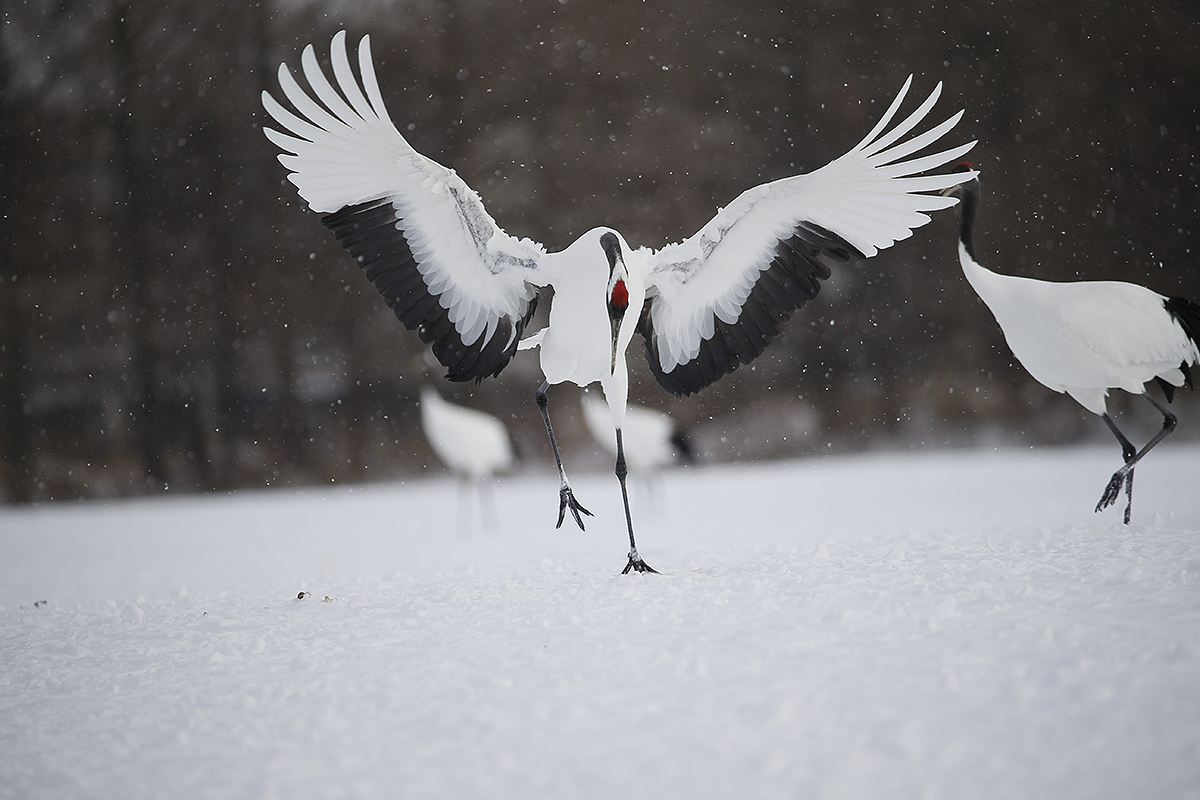
|
|
This image was created at Itoh on the Japan in Winter IPT with the hand held Canon EF 200-400mm f/4L IS USM Lens with Internal 1.4x Extender (at 560mm with the Internal TC in place) and the Canon EOS-1D X. ISO 400. Evaluative metering +2 1/3 stops off the snow: 1/1250 sec. at f/5.6 in Manual mode. Color temperature: AWB.
Central Sensor/AI Servo-Surround/Rear Focus AF on the top of the bird’s right thigh active at the moment of exposure; there is no way to tell whether or not the active sensor above the central sensor caught the end of the bird’s bill, but no worries, the image is very sharp on the head. Click here to see the latest version of the Rear Focus Tutorial. Click on the image to see a larger version.
|
What to Do?
You traveled all the way to Japan. You are in the right place at the right time with the wind behind you, blowing snow, and soft light. You are tracking an incoming crane and as the bird starts to land it beings to display. You are hoping that the bird lands clean, but as you press the shutter button you see that that is not to be. When you view the image on your laptop, you note that the image is not level, that it is slightly underexposed, and that parts of three other cranes are merged with the subject. All in all a pretty much worst case situation…. But, the display is gorgeous and the image is sharp.
What to do? Do you delete the image and move on?
|

|
|
This, the optimized version, was created from the original image above in Photoshop after the RAW conversion was done in DPP.
|
The Image Optimization
What to do? Get to work.
Lighten the image during the RAW conversion in DPP. Open it in Photoshop. Level and crop it. Fill in the long skinny triangle left along the upper right frame edge with the Clone Stamp Tool working small and being careful to avoid obvious repeats. (I tried the John Heado Content Aware Fill method but the filled in area lacked texture so I went to the Clone Stamp.) Eliminate the visible parts of the two cranes directly behind the subject using Denise Ippolito’s great Protect and Defend Cloning with Layers technique that is described on page 92 of Digital Basics. Again, be sure to work small and strive to avoid obvious repeats. Avoiding all snow flake pattern repeats is impossible. Those that are noted can be dealt with with the Spot Healing Brush (J). Get rid of the head of the larger crane on the right by again using Denise Ippolito’s Protect and Defend Cloning with Layers technique Cover the body with several Quick Masks that and fine-tune them with Regular Layer Masks. Clean up the snow/woods demarcation line with a 40% Clone Stamp Tool.
Make the image pop with a Levels Adjustment on its own Layer as described in detail in the “Keep It” blog post here. Sharpen, lighten, and brighten the colors of the head, face, and the black on the neck after selecting those areas carefully with the Quick Selection Tool. (Sharpen with a Contrast Mask, lighten via Control M–Curves on a Layer, and brighten the colors with a Vibrance Adjustment.) Lastly eliminate the slight BLUE cast in the snow with a Hue/Saturation on a layer adjustment (Control U) of the BLUE channel only (by moving the BLUE saturation slider to -100. Save and named. Create your JPEG.
The image optimization probably took close to one hour. Was it worth it?
Truth in Captioning
Whenever I do anything more than minimal clean-up I believe in captioning the images appropriately; here is the caption for this image: Red-crowned Crane landing display–parts of 3 cranes removed _Y5O7632 Hokkaido, Japan.tif. This image could not be entered in the BBC Wildlife Photographer of the Year Competition as they allow only “minor clean-up.” It could, however, be entered in the BIRDS AS ART International Bird Photography Competition. Judging of this year’s contest is currently underway.
Digital Basics
Are you tired of making your images look worse in Photoshop? Do you have no clue as to how I optimized the image above? Everything above plus tons more is detailed in my Digital Basics, an instructional PDF that is sent via e-mail. It includes my complete digital workflow, dozens of great Photoshop tips, the use of Contrast Masks, several different ways of expanding canvas, all of my time-saving Keyboard Shortcuts, Quick Masking, Layer Masking, and NIK Color Efex Pro basics, my killer image clean-up techniques, Digital Eye Doctor, creating time-saving actions, and lots more.
APTATS I & II
Learn the details of advanced Quick Masking techniques in APTATS I. Mention this blog post and apply a $5 discount with phone orders only. Learn advanced Layer Masking Techniques in APTATS II. Mention this blog post and apply a $5 discount with phone orders only. Buy the pair, APTATS I and APTATS II and we will be glad to apply at $15 discount with phone orders only.
The DPP RAW Conversion Guide
After seeing the accurate colors that I get from my DPP RAW conversions, Japan in Winter co-leader Paul McKenzie is switching to DPP conversions and Denise Ippolito is considering doing the same. Now that is amazing…. To learn why I use Canon’s Digital Photo Professional (DPP) to convert every image that I work on, click here.
IPT Info
Many of our great trips are filling up. With 5 Canadians and another couple recently signing up for our 4-DAY Bosque IPT, that workshop is filling up quickly. See also the info on the South Florida and Nickerson Beach IPTs. Two great leaders on most trips ensure that you will receive individual attention, have all of your questions answered, and learn a ton including how to think like a pro, see the situation, read the light and the wind direction, and get the right exposure every time. In addition you will have fun, and make lots of great images. Click here for IPT details and general information.
|

|
|
If you’d like to learn from the two folks who created the images in the composite above do consider one of the trips below. Denise Ippolito’s images: Japanese leaf painting, skimmer in flight, curved Keukenhof paths with tulips, copulating terns, & pink dahlia. Artie’s images: Snow Geese snowstorm blur, crane landing silhouettes, Leopard with prey in tree, King Penguin, & vertical tulip.
|
A Creative Adventure/BIRDS AS ART Instructional Photo-Tours (IPTs)/Two great leaders: Arthur Morris & Denise Ippolito.
Arthur Morris/BIRDS AS ART www.BIRDSASART-blog.com for the latest images, info, & education
Denise Ippolito/A Creative Adventure www.deniseippolito.com: get yourself out of the box!
Denise’s e-books: Bloomin’ Ideas, A Guide to Filters & Effects, The Softer Side of Macro, & more. Free Monthly Creative MiniMag: www.deniseippolito.com/magazine
Holland 2014 7 1/2-Day/8-Night: A Creative Adventure/BIRDS AS ART/Tulips & A Touch of Holland IPT. April 17-April 24, 2014: $4995 Limit: 12/Openings: 5
We still have room for 5 more flower photographers on this great trip.
Join Denise Ippolito, Flower Queen and the author of “Bloomin’ Ideas,” and Arthur Morris, Canon Explorer of Light Emeritus and one of the planet’s premier photographic educators for a great trip to Holland in mid-April 2014. Day 1 of the IPT will be April 17, 2014. We will have a short afternoon get-together and then our first photographic session at the justly-famed Keukenhof. Most days we will return to the hotel for lunch, image sharing and a break. On Day 8, April 24, we will enjoy both morning and afternoon photography sessions.
The primary subjects will be tulips and orchids at Keukenhof and the spectacularly amazing tulip, hyacinth, and daffodil bulb fields around Lisse. In addition we will spend one full day in Amsterdam. There will be optional visits the Van Gogh Museum in the morning and the Anne Frank House in the afternoon; there will be plenty of time for street photography as well. And some great food. On another day we will have a wonderful early dinner at Kinderdijk and then head out with our gear to photograph the windmills and possibly some birds for those who bring their longs lenses. We will spend an afternoon in the lovely Dutch town of Edam where we will do some street photography and enjoy a superb dinner. All lodging, ground transportation, entry fees, and meals (from dinner on Day 1 through dinner on Day 7) are included. For those who will be bringing a big lens we will likely have an optional bird photography afternoon or two.
Click here for additional info or to register.
Nickerson Baby Beach-nesting Birds IPT, Long Island, NY: 3-Full Days/July 22-24, 2014: $1199.
Black Skimmers, Common Terns with chicks, American Oystercatcher & Piping Plover families; breeding behaviors including courtship feeding, display flight and combat, and copulations. Gulls and shorebirds.
UK Puffins IPT. Early July, 2014.
Details TBA. Please e-mail to be placed on the interested list.
Tanzania Serengeti Summer Safari: Leave US: August 9—return: August 24, 2014: $12,999.
Co-leaders: Arthur Morris & Todd Gustafson. Wildebeest/The Great Migration, cats, elephant, giraffe, zebra, birds & more. Please e-mail for brochure.
Swan Island Dahlia Farm IPT, Canby, OR, September 8-12, 2014: 5 FULL DAYS: $1699.
Leader: Denise Ippolito. 40 acres with 350+dazzling varieties of dahlias in a plethora of colors, shapes and sizes. Sharpen your technical skills and boost your creative juices. Daily assignments, image sharing, and Photoshop sessions.
Bosque del Apache 2014 A Creative Adventure/BIRDS AS ART “Creative Photography Instructional Photo-Tour.” (IPT). NOV 24-25, 2014. 2-FULL DAYS: $729.
Leaders: Denise Ippolito & Arthur Morris. Introductory Slide program: 7:00pm on Sunday 11/23. This IPT is perfect for folks who want to learn to think outside the box, to create new and different images. Learn to unleash your creative juices at the wondrous Bosque del Apache, NWR in San Antonio, NM.
Bosque del Apache 2014 BIRDS AS ART/A Creative Adventure Instructional Photo-Tour (IPT). NOV 29-DEC 3, 2014. Totaling 4 FULL-DAYS: $1449
Leaders: Arthur Morris and Denise Ippolito. Introductory Slide program: 7:00pm on Sunday 11/29. Tens of thousand of Snow Geese, 10,000 Sandhill Cranes, ducks, amazing sunrises, sunsets, and blast-offs. Live, eat, and breathe photography with two of the world’s premier photographic educators at one of their very favorite photography locations on the planet.
Antarctica/The Extended Expedition Voyage: Antarctic Peninsula, South Georgia and Falkland Islands: December 13, 2014 to January 10, 2015.
Please e-mail for details.
BAA offers a wide range of books, e-Guides, and educational materials and photographic accessories at the lowest prices around—25+ years of experience, and the best advice you can get. We will not sell you junk. Access the BAA Store here or call us at 1-863-692-0906.
Questions? Please e-mail us at birdsasart@verizon.net or photographybydenise221@gmail.com.
Support the BAA Blog. Support the BAA Bulletins: Shop B&H here!
We want and need to keep providing you with the latest free information, photography and Photoshop lessons, and all manner of related information. Show your appreciation by making your purchases immediately after clicking on any of our B&H or Amazon Affiliate links in this blog post. Remember, B&H ain’t just photography!


 


Amazon
Everyone buys something from Amazon, be it a big lens or deodorant. Support the blog by starting your search by clicking on the logo-link below. No purchase is too small to be appreciated; they all add up. Why make it a habit? Because I make it a habit of bringing you new images and information on an almost daily basis.
Typos
In all blog posts and Bulletins, feel free to e-mail or to leave a comment regarding any typos, wrong words, misspellings, omissions, or grammatical errors. Just be right. 🙂
March 7th, 2014 Jet Lag Update
After reading comments left on the last two blog posts (big time thanks to Jerry Murray and Colin Bradshaw), I consulted my San Diego health guru, Dr. Cliff Oliver. He suggested getting some time-release melatonin and taking a small dose at bed-time. I could not get the time release stuff in Lake Wales so I got the regular in the 3mg dose. I cut one tablet in half, took that just before bedtime–11:00pm, made one pit stop during which I took the remaining 1/2 of the pill, fell quickly back to sleep, and woke up refreshed at 7:30am. It was one of my best night’s sleep in a decade. (My ice baths, which I began when I got back, always help with sleep via fewer pit stops.) Like Cliff on Facebook and learn a ton about Wellness here.
The Streak
This post marks 98 straight days with a new blog post, a record by far that should be extended for at least another day or so, or not. Or more…. To show your appreciation for my efforts here, we ask that use our B&H and Amazon affiliate links for all of your B&H and Amazon purchases. Please check the availability of all photographic accessories in the BIRDS AS ART Online Store. We sell only what I use and depend on. We will not sell you junk. We know what you need to make creating great images easy and fun. And we are always glad to answer your gear questions via e-mail.
You can find the following items in the store: Gitzo tripods, Mongoose M3.6 and Wimberley heads, plates, low feet, and accessories, flash brackets, , Delkin e-film Pro Compact Flash Cards, LensCoat products, and our unique line-up of educational materials including ABP I & II, Digital Basics, Site and Set-up e-Guides, Canon and Nikon Camera Users and AF e-Guides, and MP-4 Photoshop video tutorials among others.
We would of course appreciate you using our B&H and Amazon affiliate links for all of your B&H and Amazon major gear, video, electronic, household, and personal purchases. For the photographic stuff mentioned in the paragraph above we would of course greatly appreciate your business. Here is a huge thank you to the many who have been using our links on a regular basis and visiting the BAA Online store as well.
This blog post took about 1 1/2 hours to prepare. Enjoy.
|

|
|
Images copyright 2012: Denise Ippolito & Arthur Morris. Card design by Denise Ippolito. Click on the image to enjoy a spectacular larger version.
|
Gear Bag for Holland
Now that I am back from Japan, I am looking forward to the Holland IPT. I will be traveling light. For me at least 🙂 Here, is the gear that I will be bringing along with an explanation of why for each item:
Canon EF 100mm f/2.8L Macro IS USM lens. This will likely be my most used lens on the tripod. I will hand hold it using the techniques that Denise Ippolito taught the group on the last Tulip IPT and use it on the tripod with the Canon Tripod Mount Ring D for 100mm f/2.8L IS Macro lens. The lens does not come with a tripod collar. A separate purchase is required. You can save well more than $100 by going with the Vello Tripod Collar D (Black) for Canon EF 100mm f/2.8L IS USM Macro lens. I will surely use the 100 macro lens on a tripod a lot more than denise will even though she uses the older non-IS model that she loves. I did not own this lens at the time of the Holland trip last year; I can’t wait to get back and see what I can do with it.
Canon EF 180mm f/3.5L Macro USM lens. This was my former favorite macro lens. It gives you a bit more reach and a narrower angle of view than the 100 macro lenses. I use it often with a 1.4X III TC.
Canon EF 200-400mm f/4L IS USM lens with Internal 1.4x Extender. Last year I brought my Canon EF 600mm f/4L IS II USM lens into the Willem-Alexander Pavilion at Keukenhof there was lots of staring going on. This year the 2-4 will be my long lens for the tulips. With an external 1.4X III in place it will give me 784mm of reach that will be great for isolating single flowers. In addition, it should be great for our optional afternoon of Purple Heron flight photography and possibly for Great-crested Grebe as well.
Canon EF 70-200mm f/2.8L IS II USM lens. This versatile intermediate telephoto lens is perfect for the tulip fields. Last year I used it often to create both sharp images as well as zoom, pan, and shiver blurs. (Learn more in A Guide to Pleasing Blurs by Denise Ippolito and yours truly.)
Canon EF 24-70mm f/2.8L II USM lens. Never leave home without a short zoom lens. I replaced the older Canon EF 24-105mm f/4L IS USM lens with the 24-70II because the latter is clearly sharper and because it meshes perfectly with my 70-200 f/2.8 L IS II. On this trip I will be hand holding this lens whenever I use it.
Canon Extender EF 1.4X III. I will have two along as I never travel without a back-up for my most valuable accessory. I will one available when I need extra reach either with the 180 macro or the 200-400.
Canon Extension Tube EF 25 II & Canon Extension Tube EF 12 II. I am bringing two of the former and one of the latter to allow for closer focusing. I often use them in combination. Be sure to stop down a bunch whenever using an extension tube to prevent vignetting.
Canon EOS 5D Mark III DSLR camera body. For the superb image quality of the 5D III’s 22.3 megapixel files the lightweight 5D III is my go-to camera body for flowers. And don’t forget the in-camera HDR and in-camera Multiple Exposure features.
Canon EOS-1D X Digital camera body. The 1D X is my primo bird photography body so I will use it for the Purple Herons and have it along as my back-up body. You should never make a big trip without a back-up camera body. Renting a body from BorrowLenses using our affiliate link is a great option.
Gitzo 3532 LS carbon fiber tripod & the Mongoose M3.6 head. This combination works every bit as well with my Macro lenses as it does with my 600 II and will allow me to photograph the Purple Herons in flight off a tripod should my arms get weary.
Did I miss anything?
Questions
If you have any questions on what I am bringing or on any of the gear above, feel free to ask by leaving a comment.
Learning on BPN (BirdPhotographers.net/It Ain’t Just Birds!
I am consistently amazed that in addition to teaching others through honest critiques done gently how much I learn while offering helpful critiques. For a great example, see Iain Barker’s Chaffinch post here. There is a great example of making accurate Curves adjustments and I learned a ton about using Hue/Saturation to attain the right colors.
See the newly designed Home Page here, see all of our great forums here, or visit the Avian Forum here. The Avian Forum alone has had 48,311 images posted for critiquing and 437,372 Replies. That’s a lot of learning!
Holland 2014 7 1/2-Day/8-Night: A Creative Adventure/BIRDS AS ART/Tulips & A Touch of Holland IPT. April 17-April 24, 2014: $4995 Limit: 12/Openings: 5
Act soon: this trip is not far off.
Join Denise Ippolito, Flower Queen and the author of “Bloomin’ Ideas,” and Arthur Morris, Canon Explorer of Light Emeritus and one of the planet’s premier photographic educators for a great trip to Holland in mid-April 2014. Day 1 of the IPT will be April 17, 2014. We will have a short afternoon get-together and then our first photographic session at the justly-famed Keukenhof. Most days we will return to the hotel for lunch, image sharing and a break. On Day 8, April 24, we will enjoy both morning and afternoon photography sessions.
The primary subjects will be tulips and orchids at Keukenhof and the spectacularly amazing tulip, hyacinth, and daffodil bulb fields around Lisse. In addition we will spend one full day in Amsterdam. There will be optional visits the Van Gogh Museum in the morning and the Anne Frank House in the afternoon; there will be plenty of time for street photography as well. And some great food. On another day we will have a wonderful early dinner at Kinderdijk and then head out with our gear to photograph the windmills and possibly some birds for those who bring their longs lenses. We will spend an afternoon in the lovely Dutch town of Edam where we will do some street photography and enjoy a superb dinner. All lodging, ground transportation, entry fees, and meals (from dinner on Day 1 through dinner on Day 7) are included.
For those who will be bringing a big lens we will likely have an optional bird photography afternoon or two. If we get lucky, the big attraction should be gorgeous Purple Herons in flight at a breeding marsh. We would be photographing them from the roadside. And we might be able to find a few Great-crested Grebes at a location near Keukenhof.
You will learn to create tight abstracts, how to best use depth-of-field (or the lack thereof) to improve your flower photography, how to get the right exposure and make sharp images every time, how to see the shot, and how to choose the best perspective for a given situation. And you will of course learn to create a variety of pleasingly blurred flower images. If you bring a long lens, you will learn to use it effectively for flower photography. Denise’s two favorite flower lenses are the Canon 100mm macro and the Canon 24-105mm zoom. Mine are the Canon 180mm macro lens and the Canon 600mm f/4L IS II, both always on a tripod and both often used with extension tubes and/or the 1.4X teleconverters. Denise hand holds a great deal of the time. For flower field blurs denise uses the same lenses mentioned above. My favorite is the 70-200 often with a 1.4X TC but I use both the 24-105 and the 600 II as well. Both of us use and love the Canon EOS-5D Mark III for all of our flower photography. The in-camera HDR and Multiple Exposure features are a blast.
One of the great advantages of our trip is that we will be staying in a single, strategically located hotel that is quite excellent. Do note that all ground transfers to and from Schipol will be via hotel shuttle bus.
What’s included: Eight hotel nights. All ground transportation except for airport transfers as noted above. In-the-field instruction and small group image review and Photoshop sessions. All meals from dinner on Day 1 through dinner on Day 8. The hotel we are staying in often offers both lunch and dinner buffets. The food is excellent. Whenever you order off the menu be it at the hotel or at one of the several fine-dining spots that we will be enjoying at various locations, only the cost of your main course is included. On these occasions the cost of soups, appetizers, salads, sodas and other beverages, alcoholic drinks and wine, bottled water, and desserts are not included. This is done in part in hopes that folks will be less inclined to enjoy an eight course dinner so that we can get to bed early. As with all A Creative Adventure/BIRDS AS ART Instructional Photo-Tours both the photo sessions and the days are long. Nothing that we do however will be demanding. Being able to sit down on the ground with your gear is, however, a huge plus. Anyone in halfway decent shape should be fine.
Snacks, personal items, phone calls, etc. are not included.
Beware of seemingly longer, slightly less expensive tours that include travel days and days sitting in the hotel doing nothing as part of the tour. In addition, other similar trips have you changing hotels needlessly. The cost of this years trip is a bit higher than last years to reflect our increased experience and the extra hotel night that is included. One final note on other similar trips: the instructors on this trip actually instruct. On other similar trips the instructors, though usually eminently qualified, serve for the most part as van drivers….
Happy Campers only please. A non-refundable deposit of $1,000 per person is required to hold your spot. The second payment of $2,000 due by October 30, 2013. The balance is due on January 15, 2014. Payments in full are of course welcome at any time. All payments including the deposit must be made by check made out to “Arthur Morris.” As life has a way of throwing an occasional curve ball our way, you are urged to purchase travel insurance within 15 days of our cashing your check. I use and recommend Travel Insurance Services. All payments are non-refundable unless the trip fills to capacity. In that case, all payments but your deposit will be refunded.
All checks should be made out to “Arthur Morris” and sent to: Arthur Morris, PO Box 7245, Indian Lake Estates, FL 33855. Please fill out the paperwork here and include a signed copy with your deposit check.
IPT Info
Many of our great trips are filling up. With 5 Canadians signing up for our 4-DAY Bosque IPT, that workshop is filling up quickly. See also the info on the South Florida and Nickerson Beach IPTs. Two great leaders on most trips ensure that you will receive individual attention, have all of your questions answered, and learn a ton including how to think like a pro, see the situation, read the light and the wind direction, and get the right exposure every time. In addition you will have fun, and make lots of great images. Click here for IPT details and general information.
For couples or friends signing up at the same time for the tulip trip, a $200/person discount will be applied to the final payment.
Click here for complete details and lots of wonderful images with our legendary educational captions. Click here and see item one for lots more tulip images.
UK Puffins and Gannets in Flight IPT: early July 2014.
Please e-mail if interested. Details TBA very soon.
Support the BAA Blog. Support the BAA Bulletins: Shop B&H here!
We want and need to keep providing you with the latest free information, photography and Photoshop lessons, and all manner of related information. Show your appreciation by making your purchases immediately after clicking on any of our B&H or Amazon Affiliate links in this blog post. Remember, B&H ain’t just photography!


 


Amazon
Everyone buys something from Amazon, be it a big lens or deodorant. Support the blog by starting your search by clicking on the logo-link below. No purchase is too small to be appreciated; they all add up. Why make it a habit? Because I make it a habit of bringing you new images and information on an almost daily basis.
Typos
In all blog posts and Bulletins, feel free to e-mail or to leave a comment regarding any typos, wrong words, misspellings, omissions, or grammatical errors. Just be right. 🙂
|
|











